前言


基本概念
16种时态Tense
概览
时间:过去Past、将来Future、现在Present、过去将来Past Future
状态:进行Progressive、完成Perfect、完成进行Perfect Progressive、一般Simple

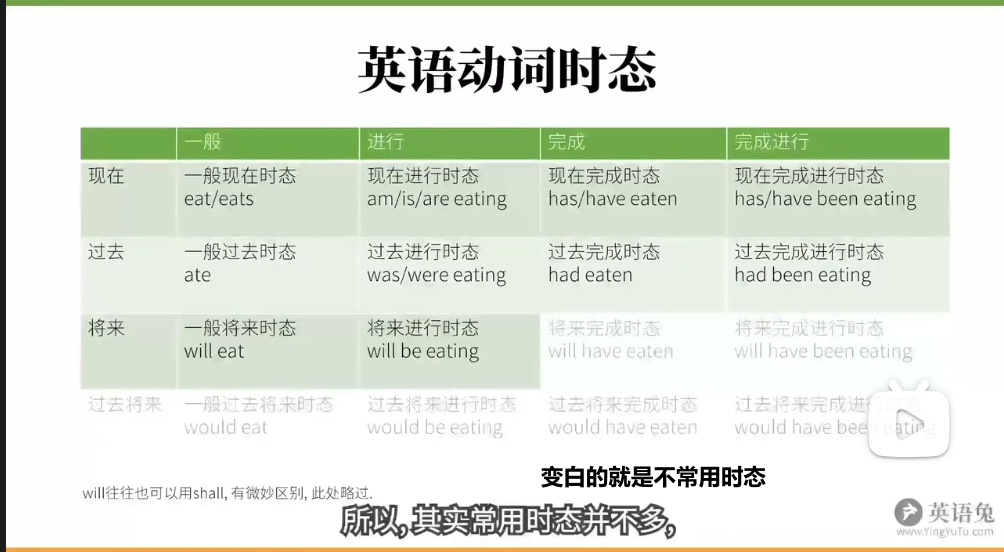
动词时间
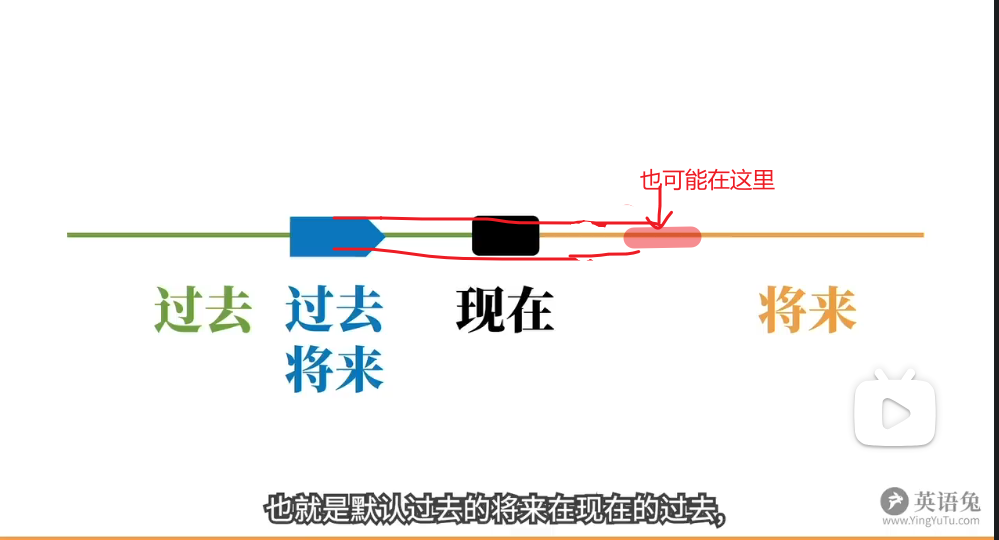
过去将来时间在现实中不常见,一般只出现在从句里。
动词状态

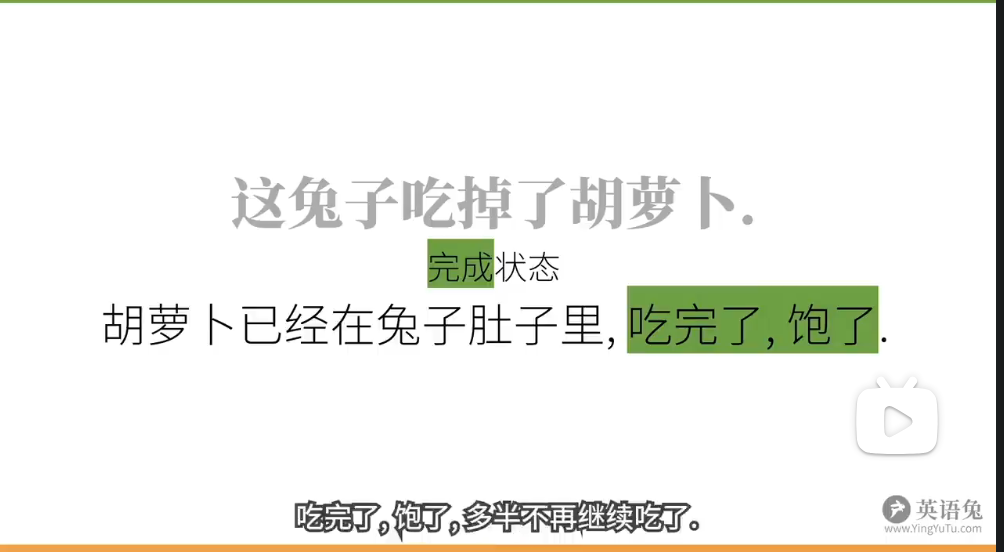
完成态的重点在动作状态完成了,并没有指出动作具体发生的时间。

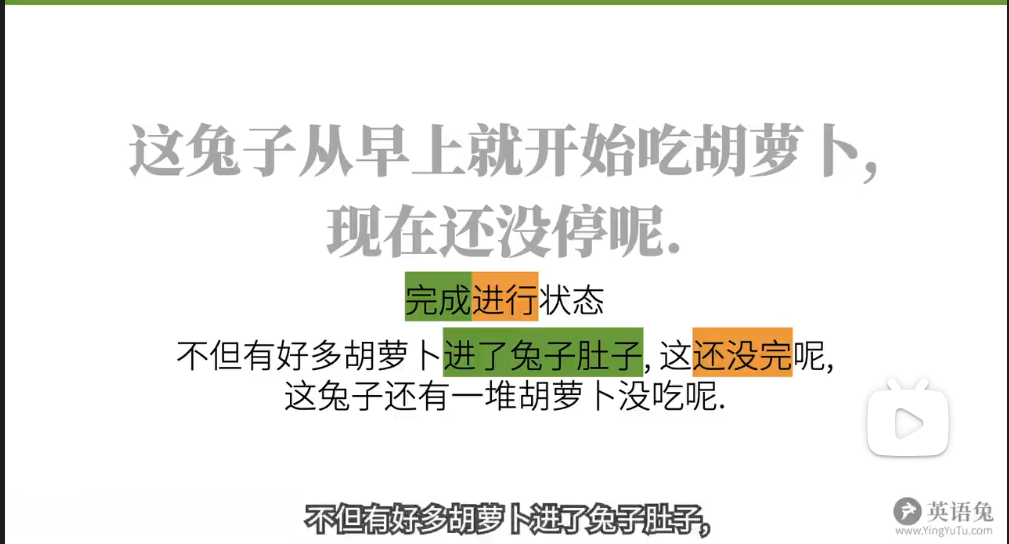
动作的一部分完成了,但剩下的还在进行中



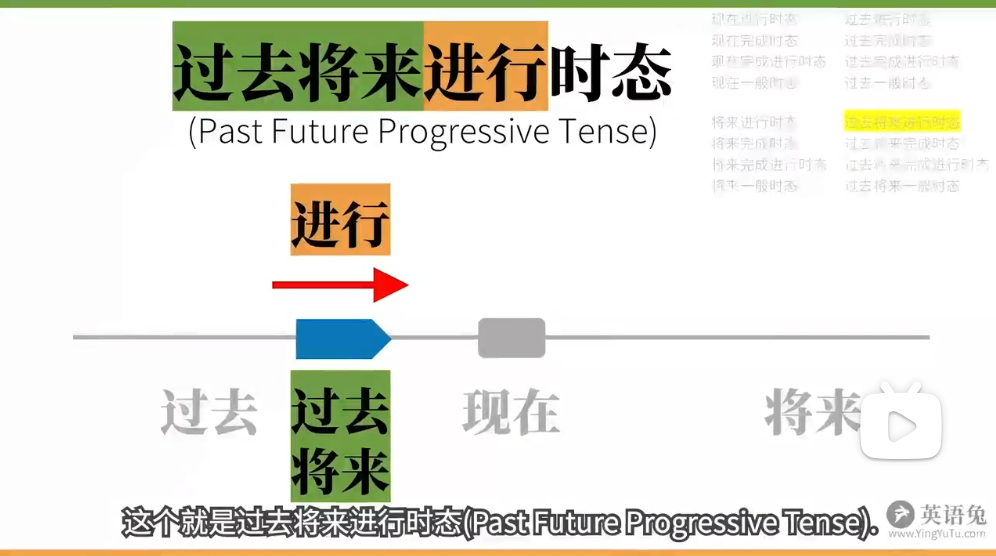
曾经被兔子啃了几口的包子上个月说:“你将在以后的某天看到我正在啃兔子呢!”
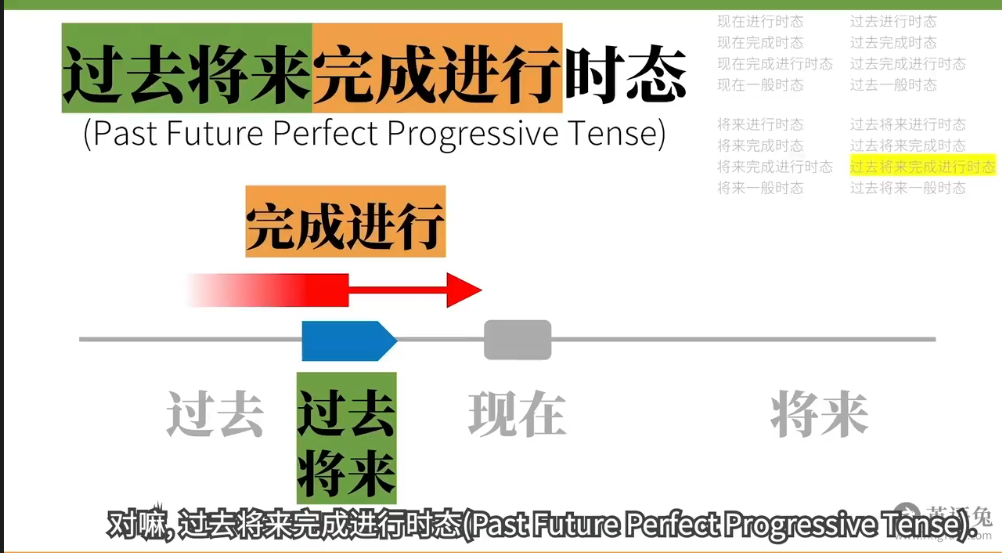
曾经被兔子啃了几口的包子上个月说:“以后的某天,当你发现我的时候,我已经啃兔子好几口了,还将继续啃下去!”
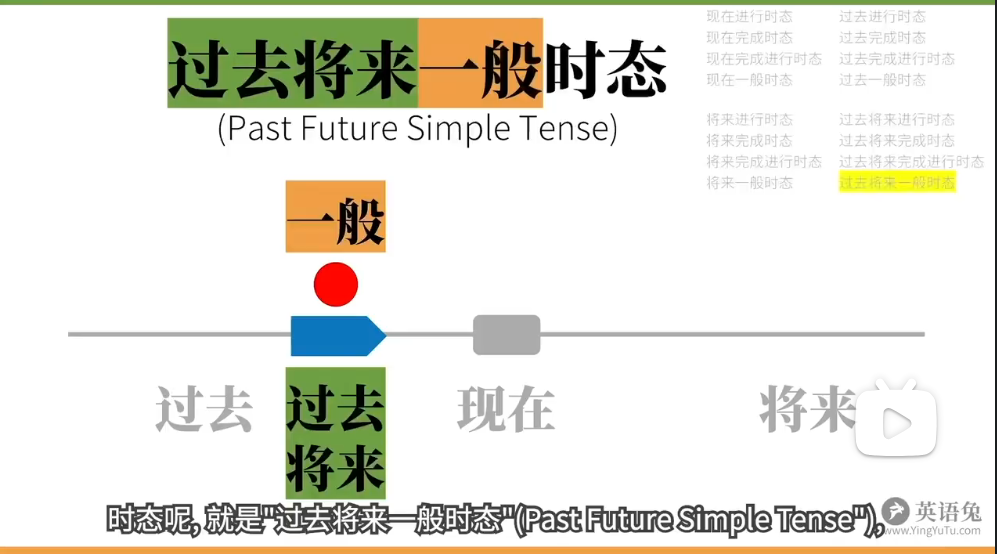
曾经被兔子啃了几口的包子上个月说:“以后的某天,我肯定会咬兔子的!”
英语兔认为时态的四大难点如下:
一、时&态未分清
二、动词变位Verb Conjugation:表达不同的时态往往需要改变单词拼写
三、表达时态往往需要借助助动词
四、时态往往和其他语法概念混合
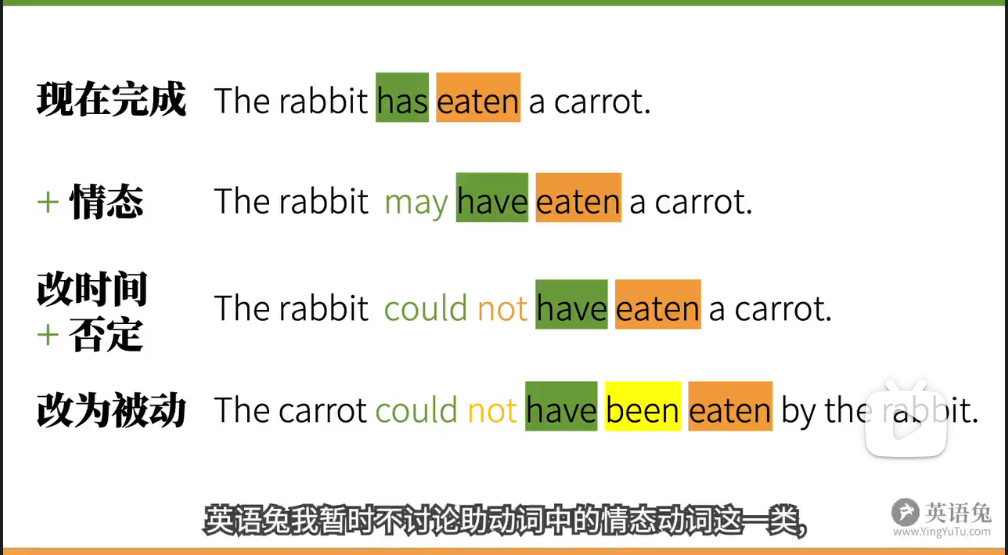
现在
一般现在时
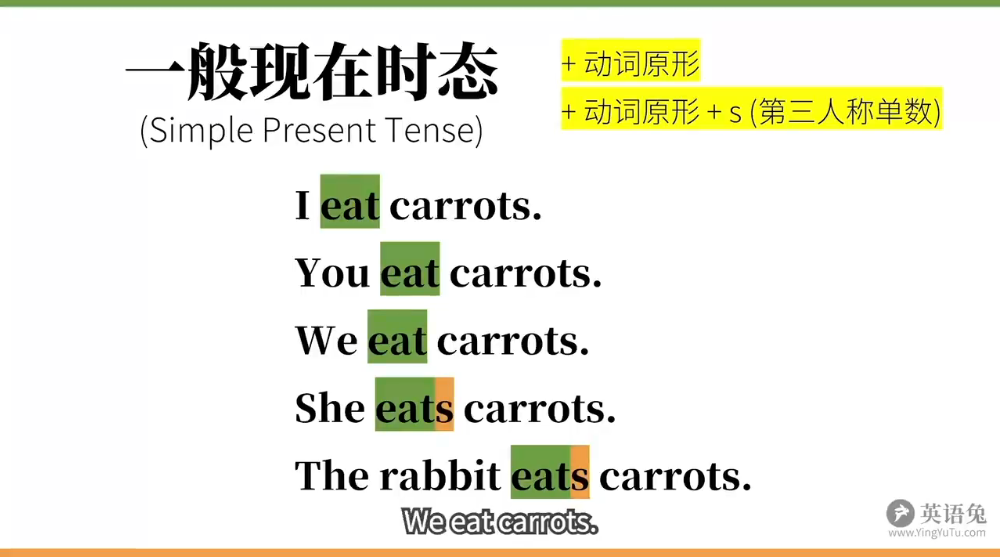
现在不是指正在进行。一般是指未特别指出状态,不太可能是正在进行的动作。
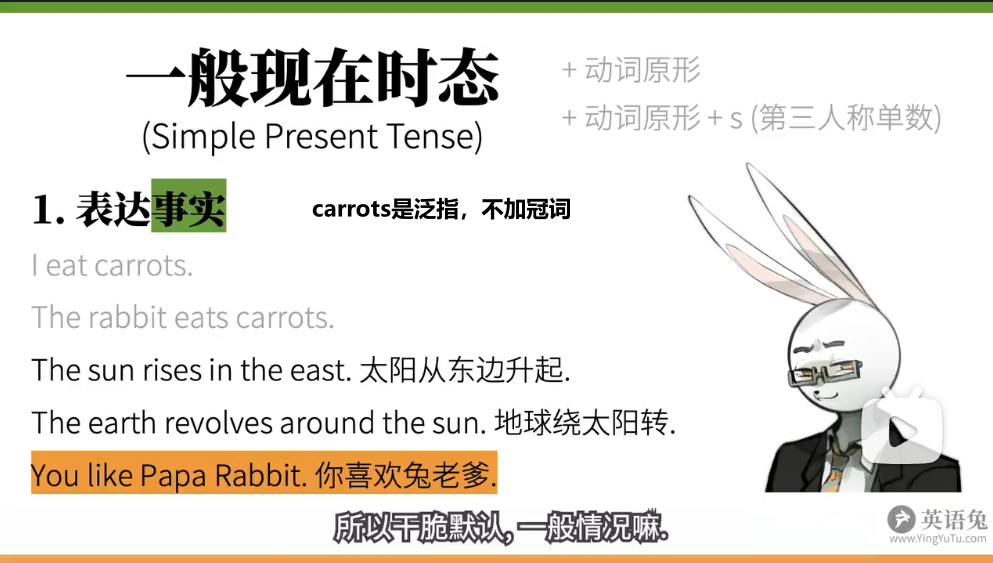
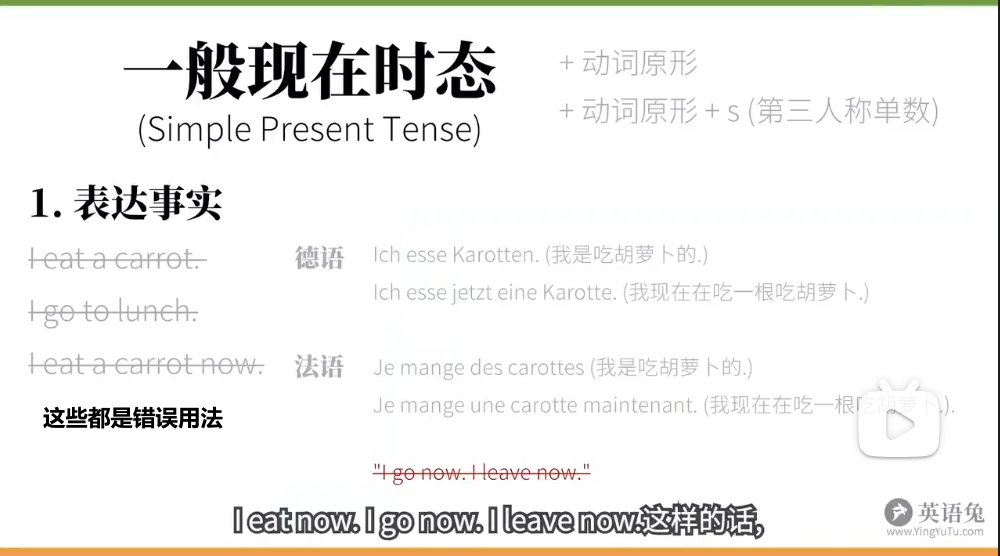

现在进行时
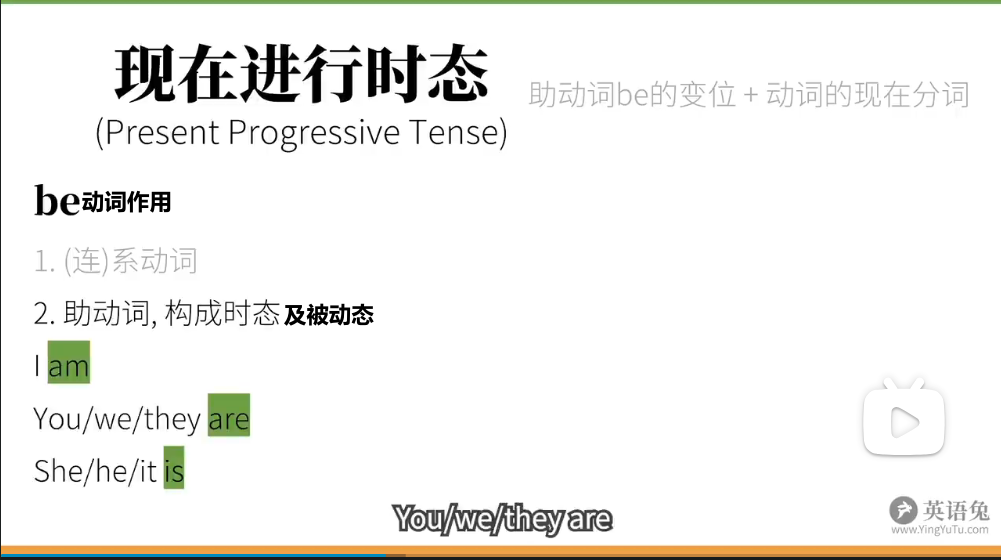
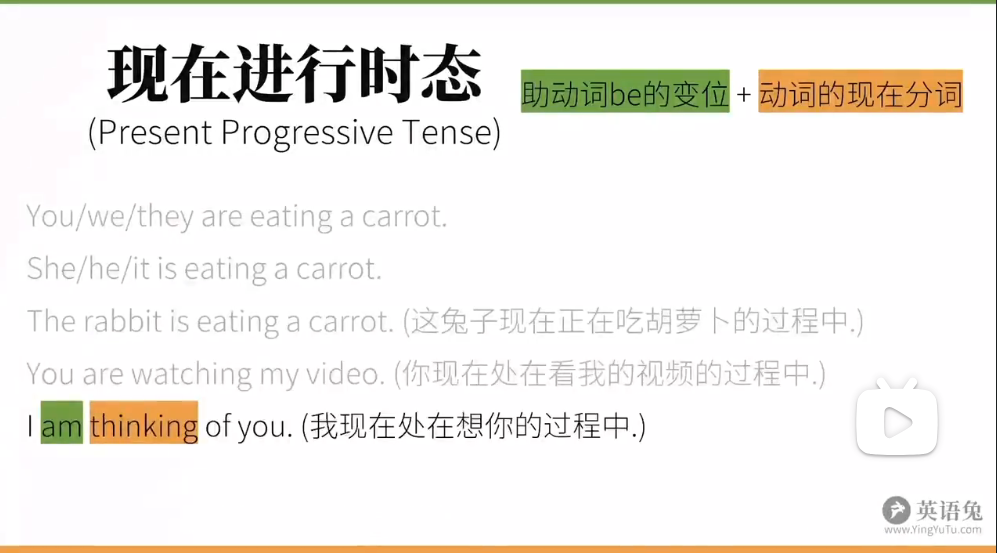
现在完成时
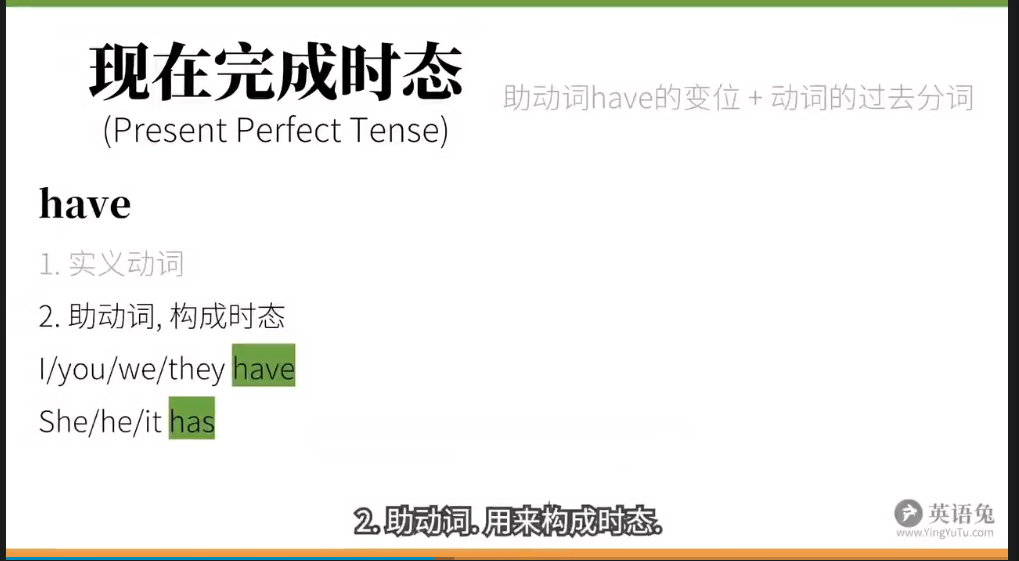
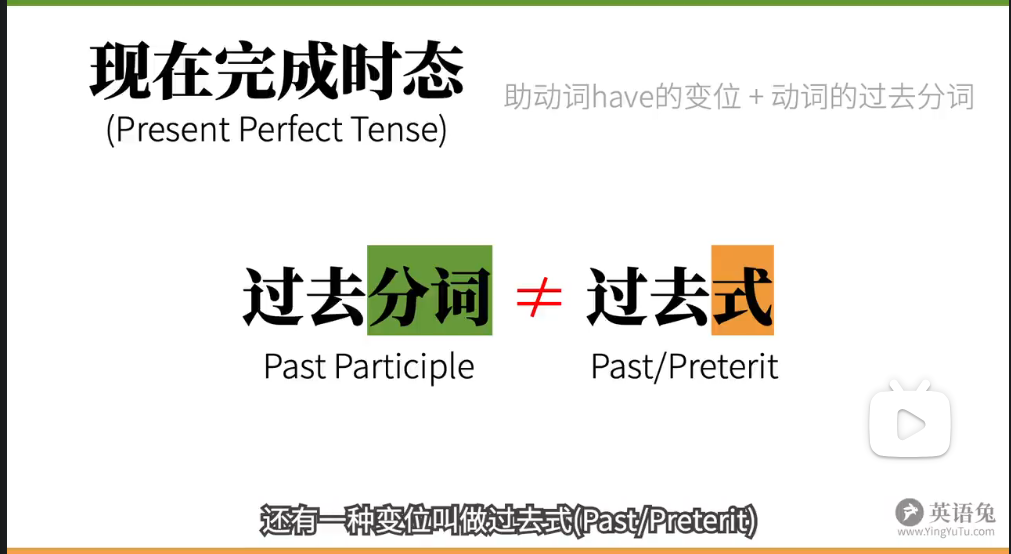
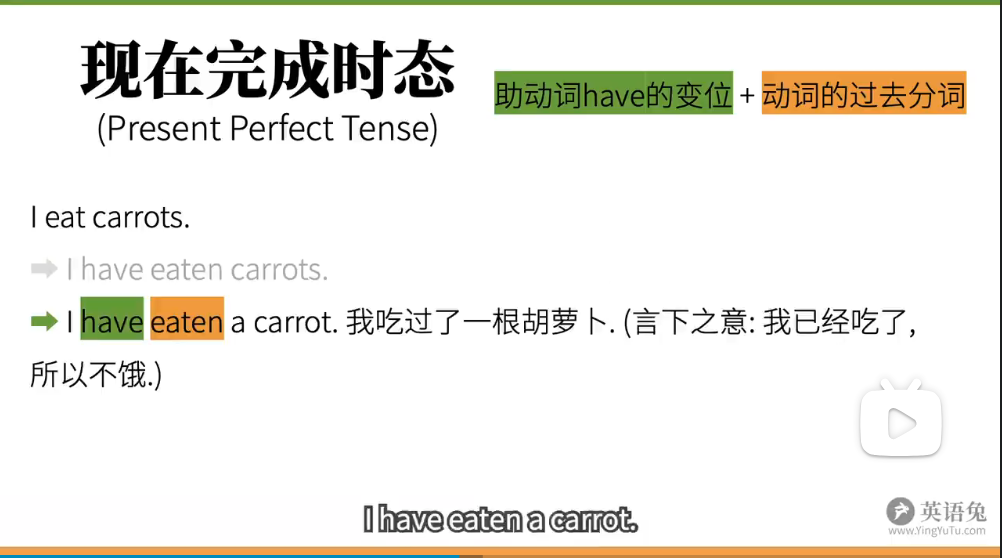

现在完成进行时态
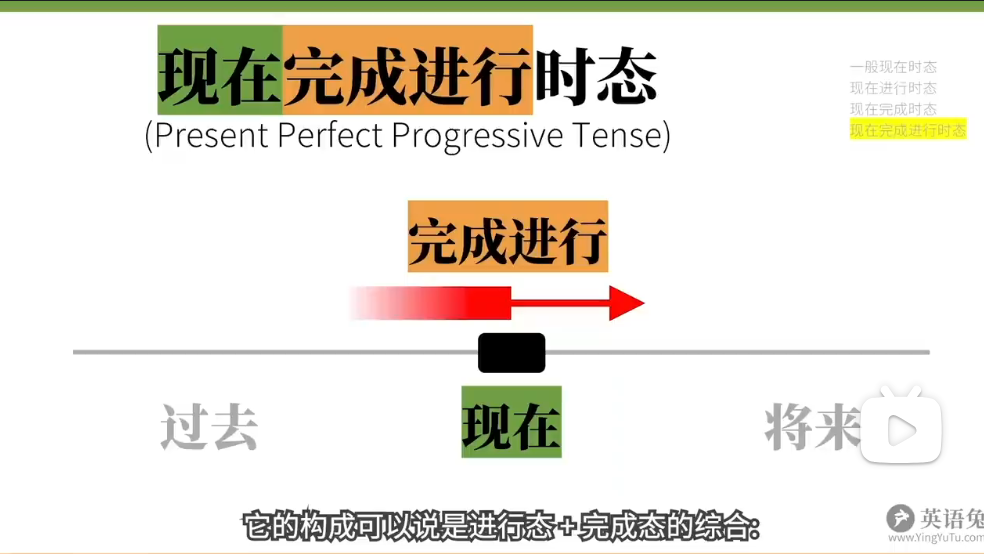
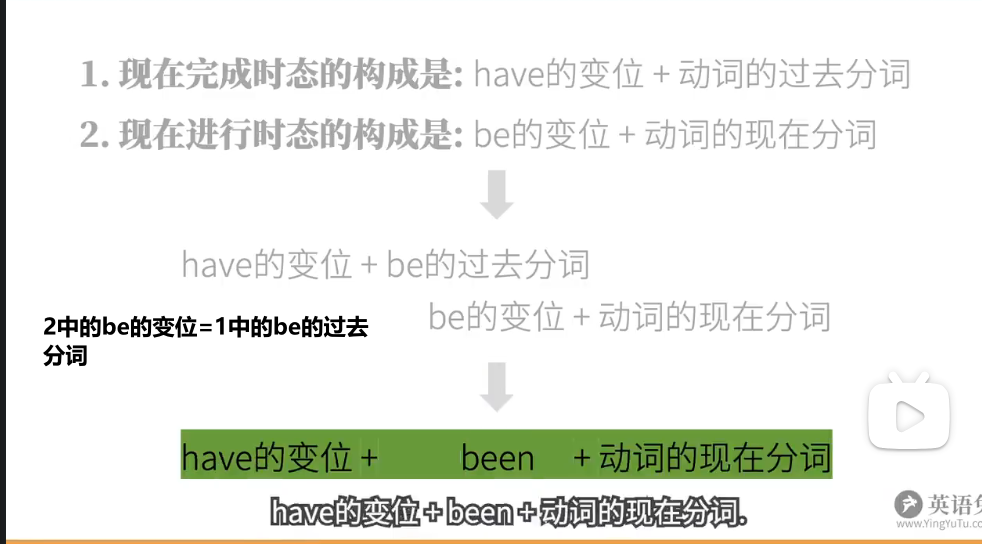
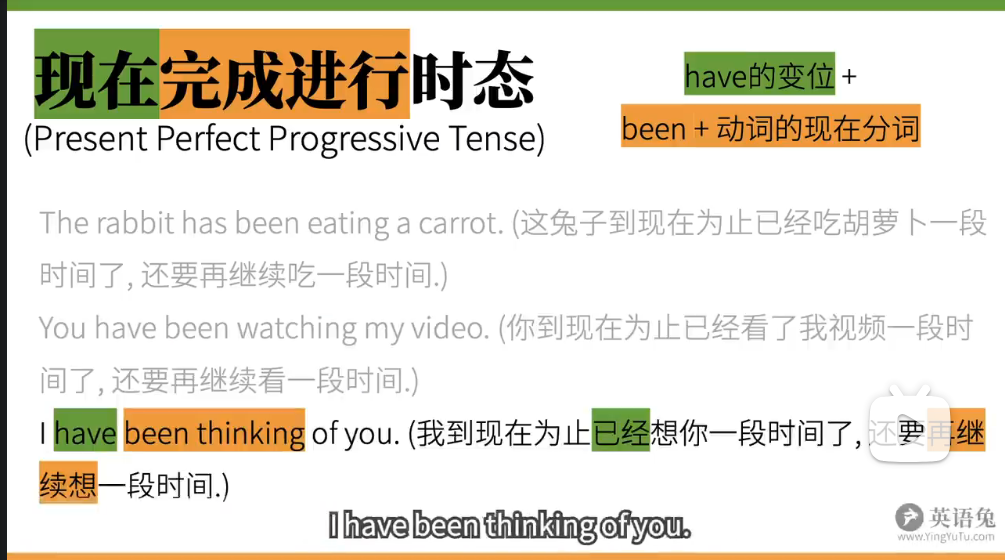
过去
一般过去时
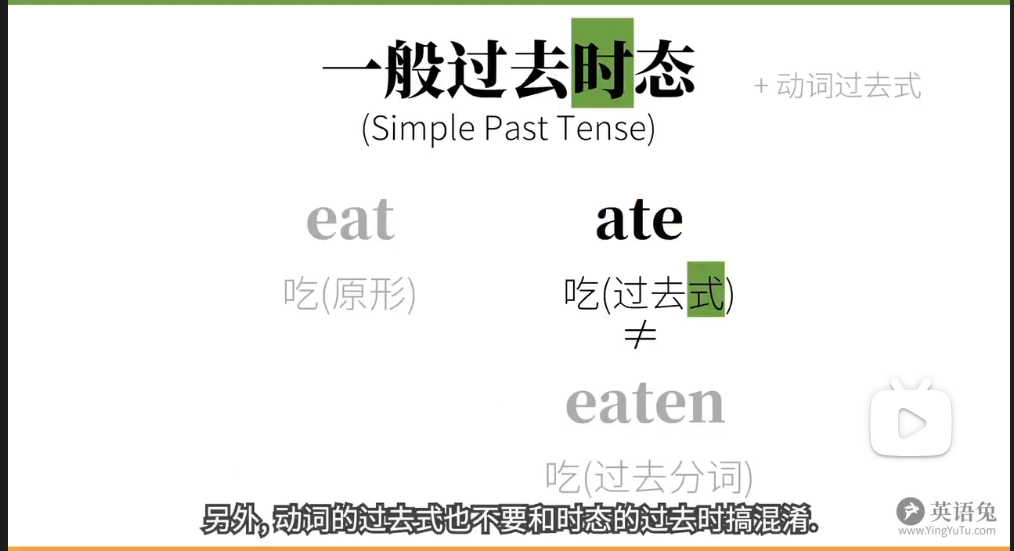
过去式通常+ed
一般用于指出动作发生了
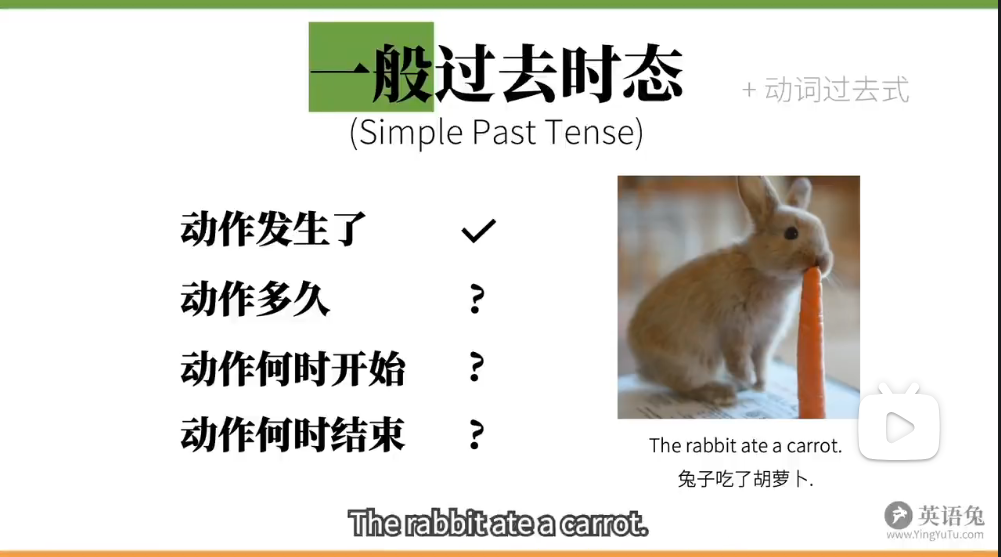
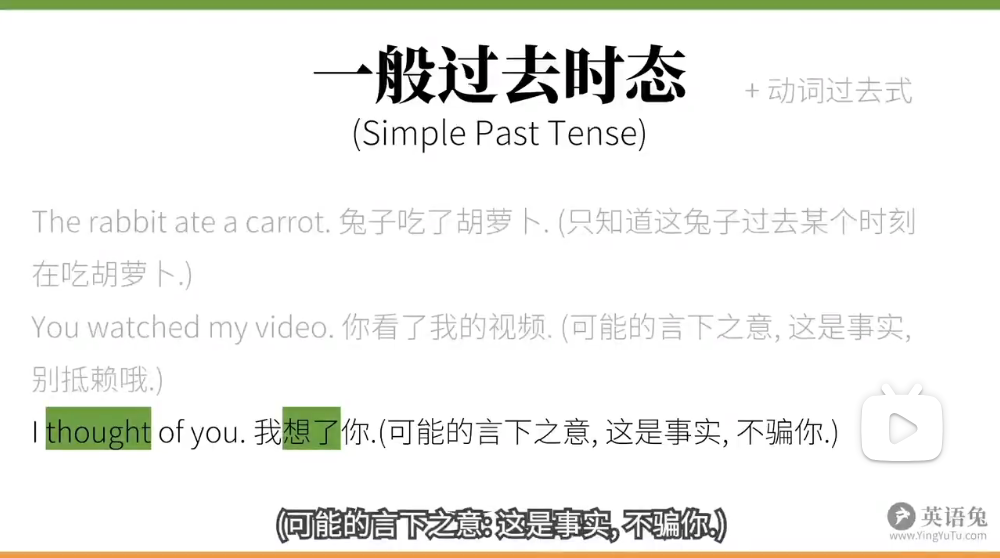
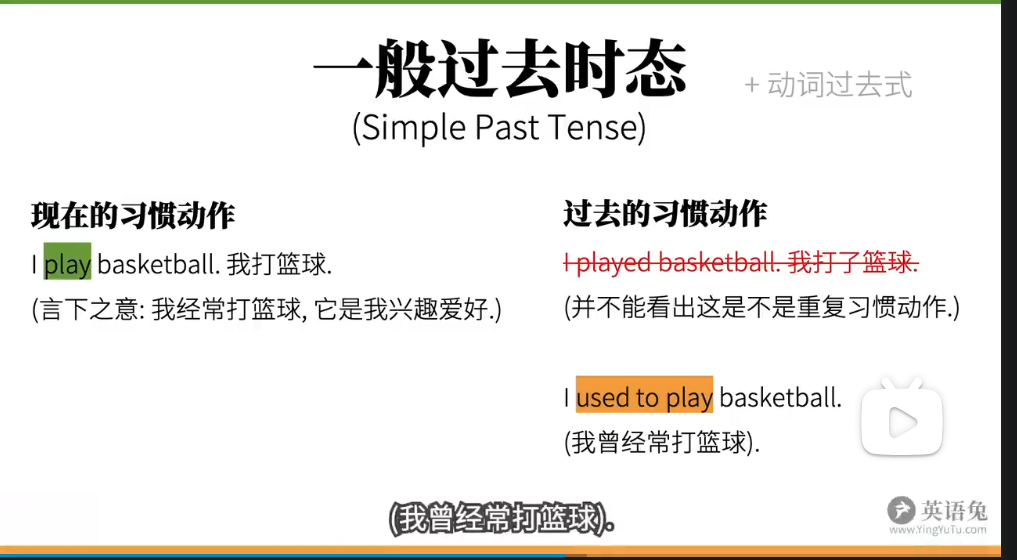
过去进行时
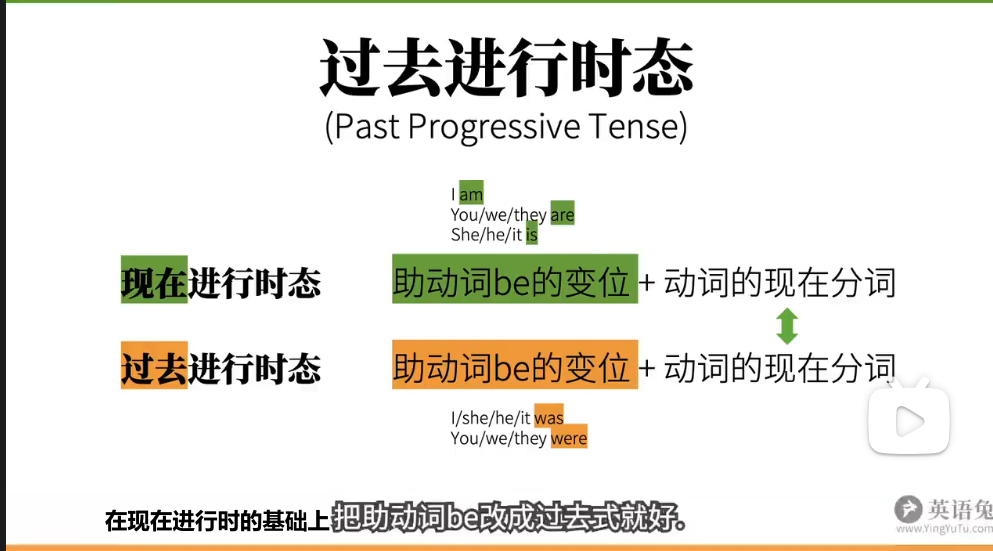
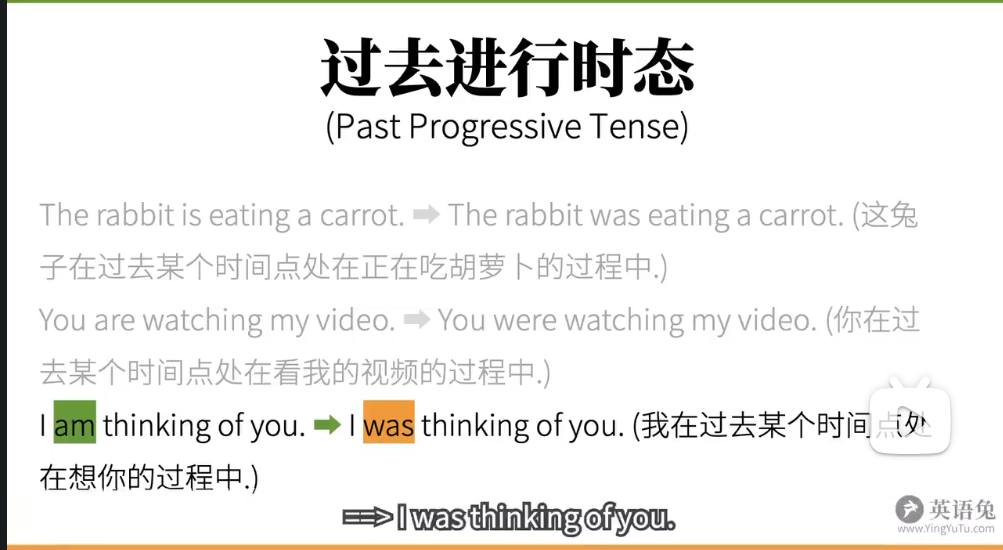

现在完成时强调对现在有有影响,一般过去时则不强调对现在有影响。
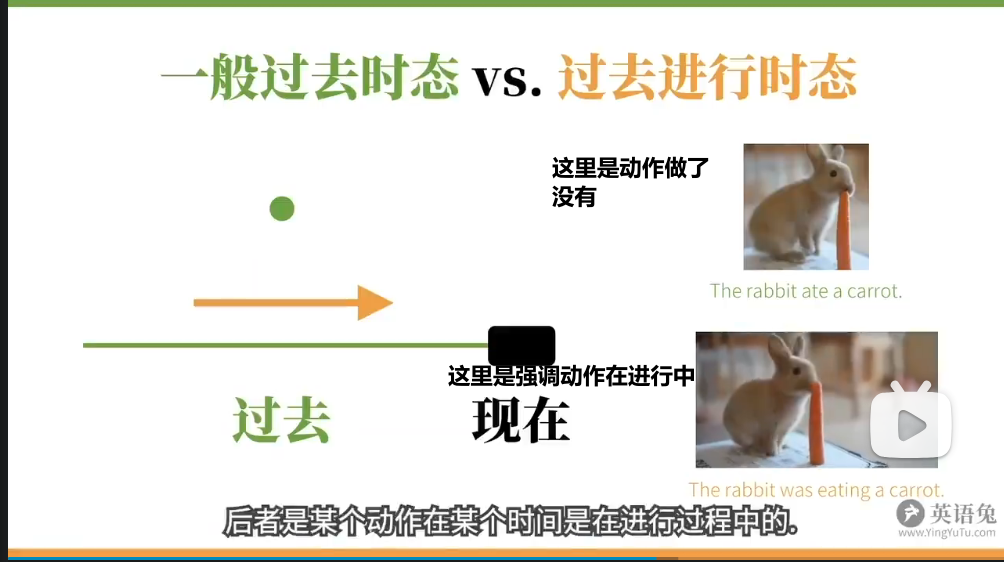
过去完成时
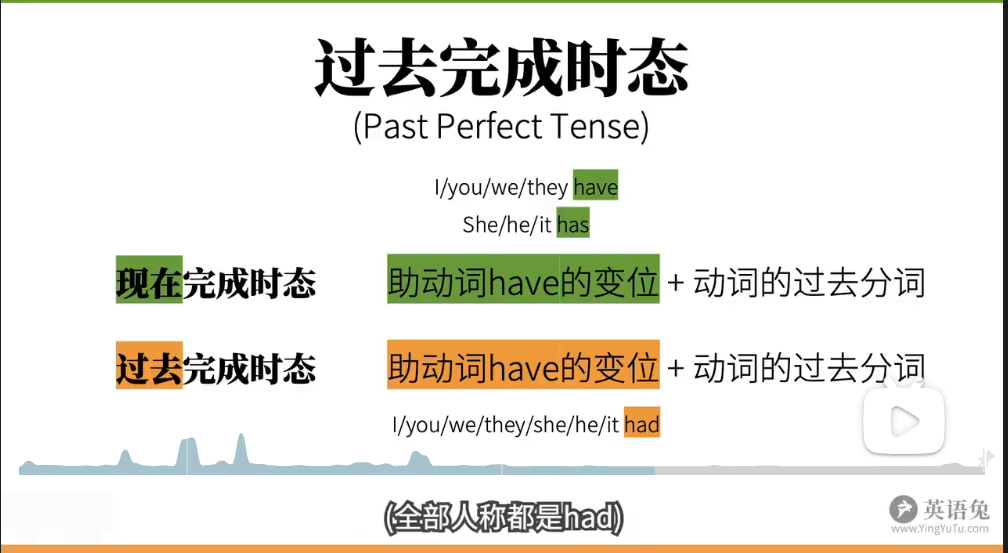
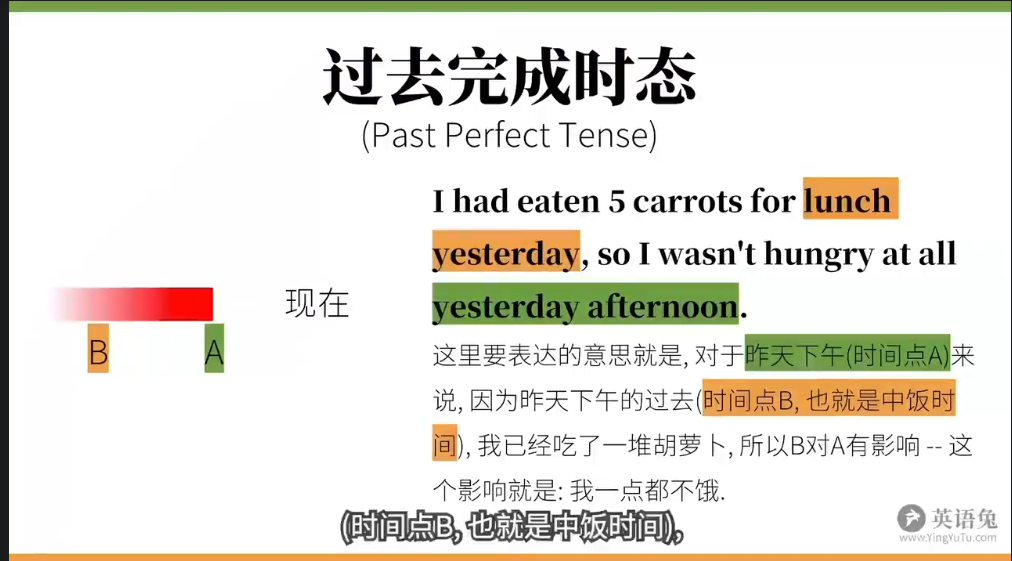
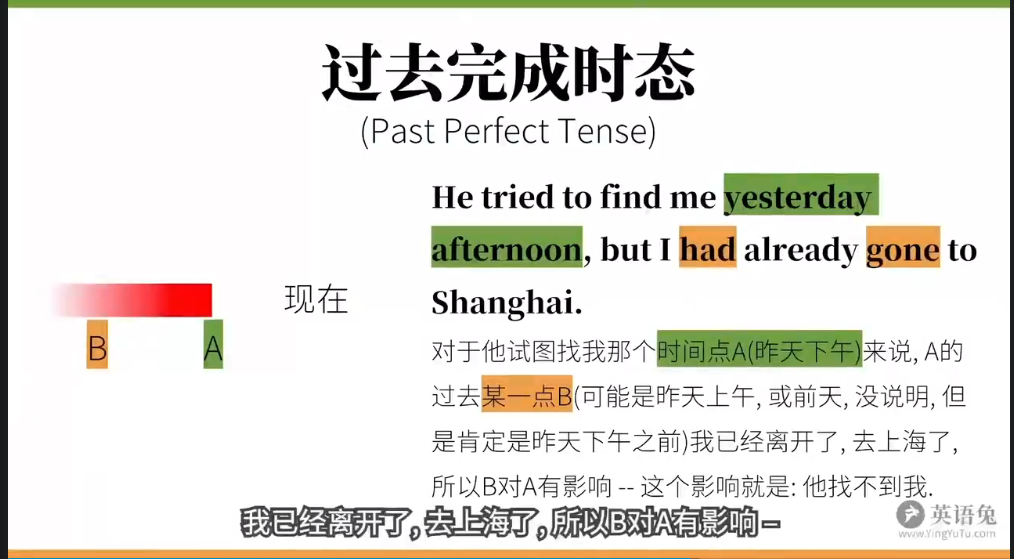
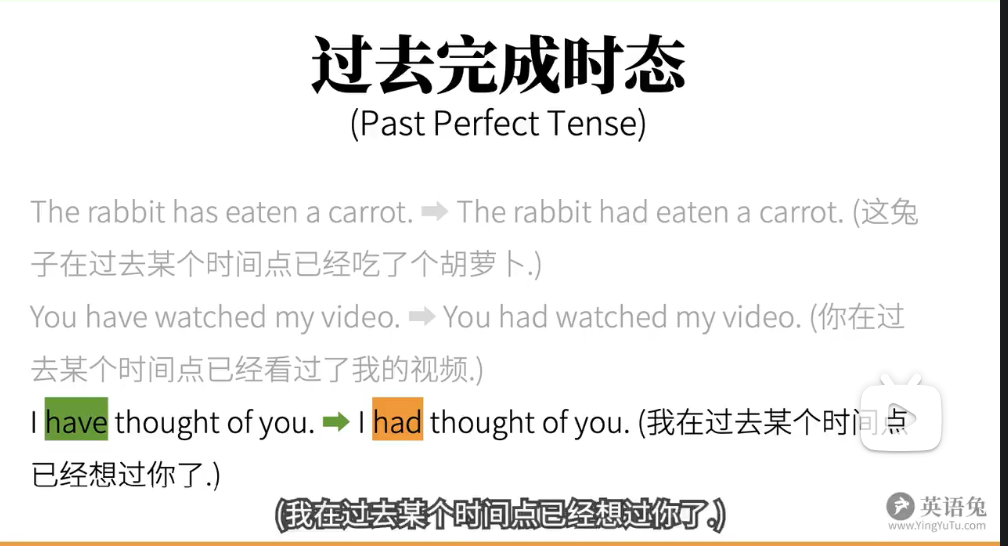
过去完成进行时
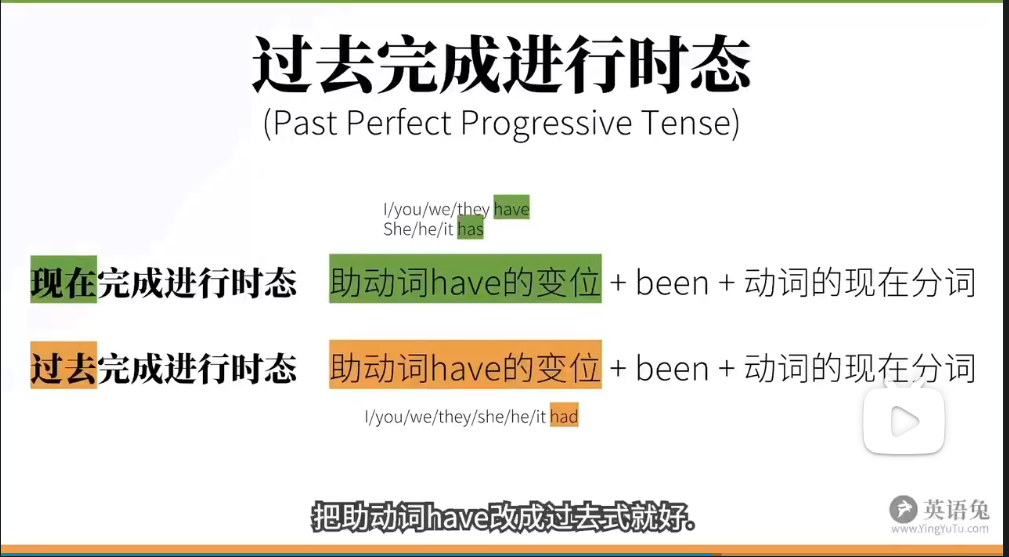
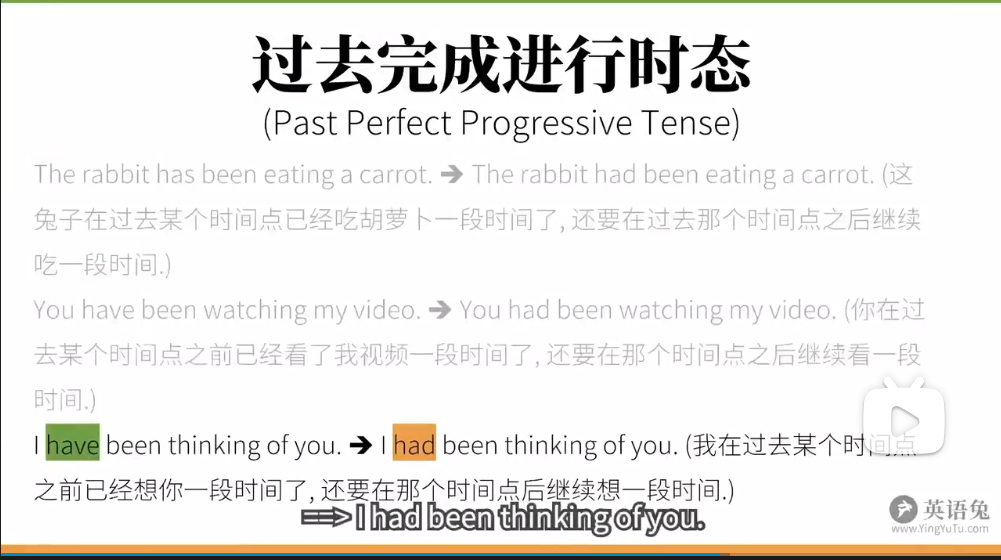
将来
一般将来时
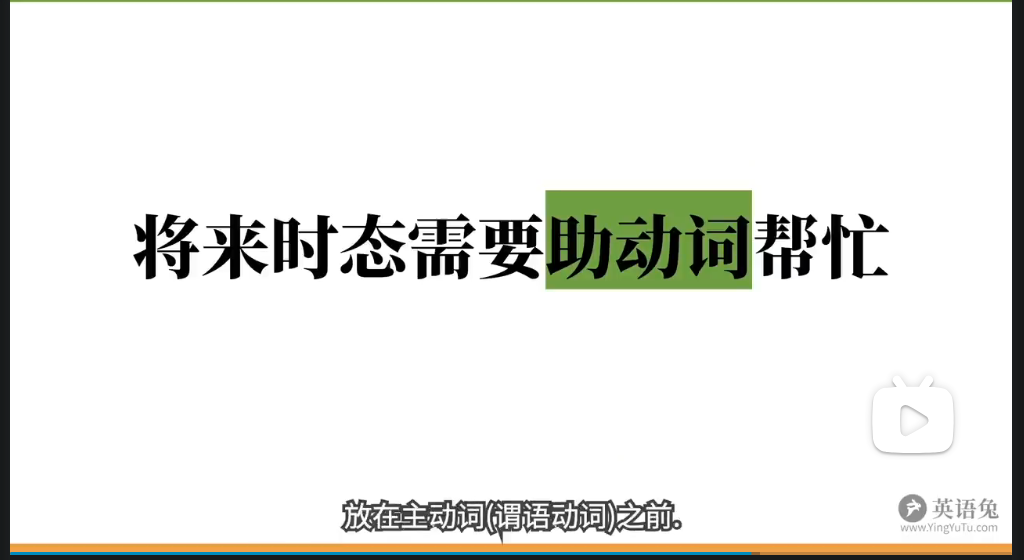




将来进行时
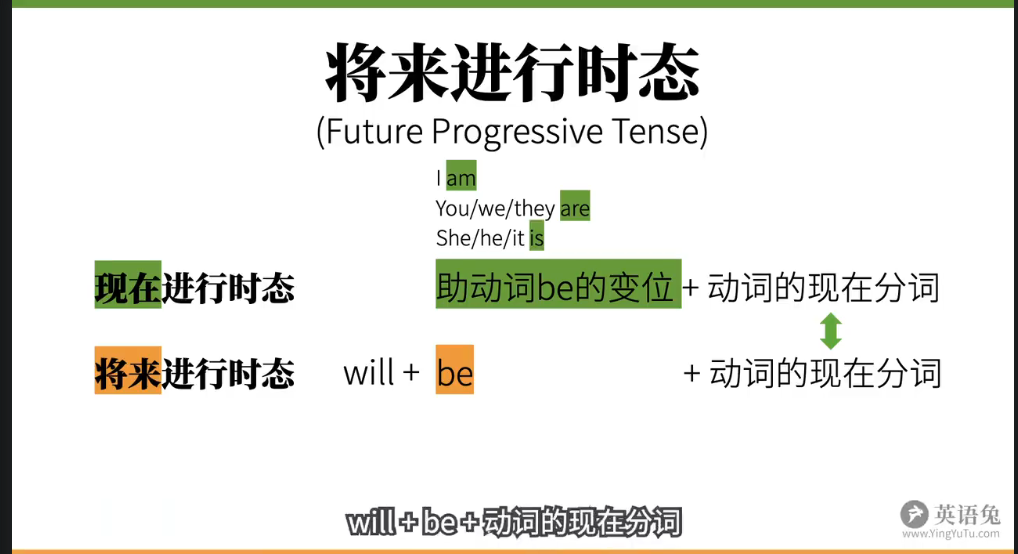
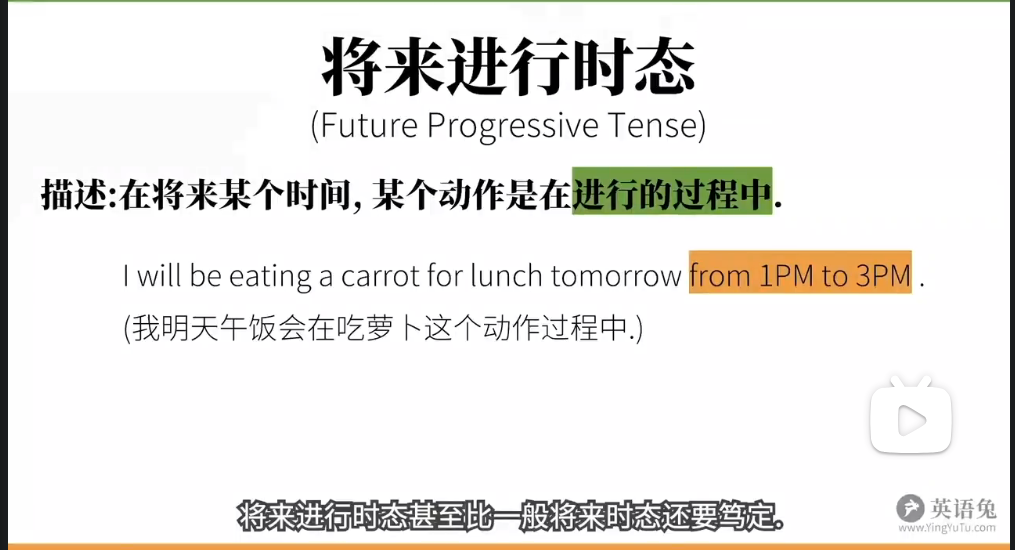

将来完成时
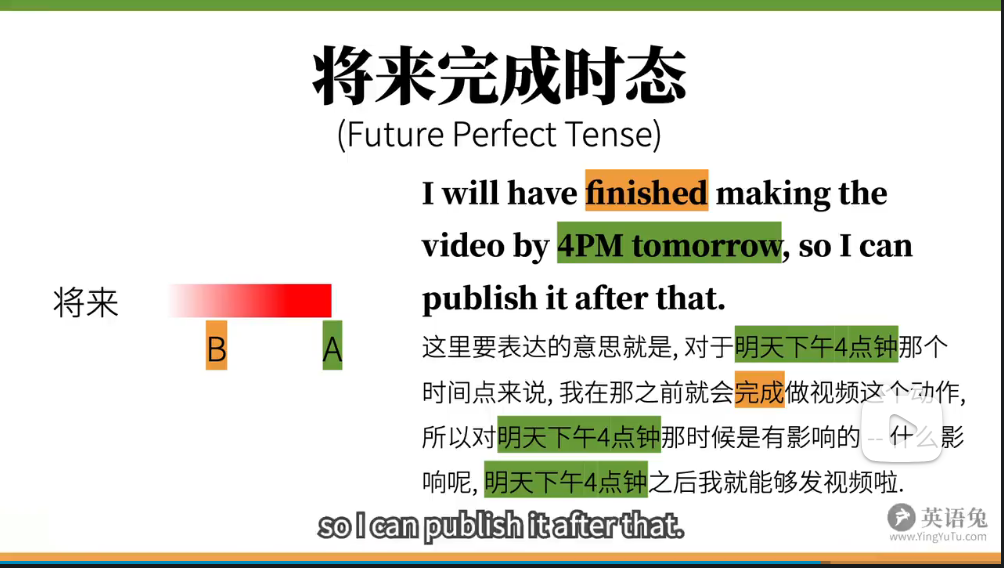


将来完成进行时
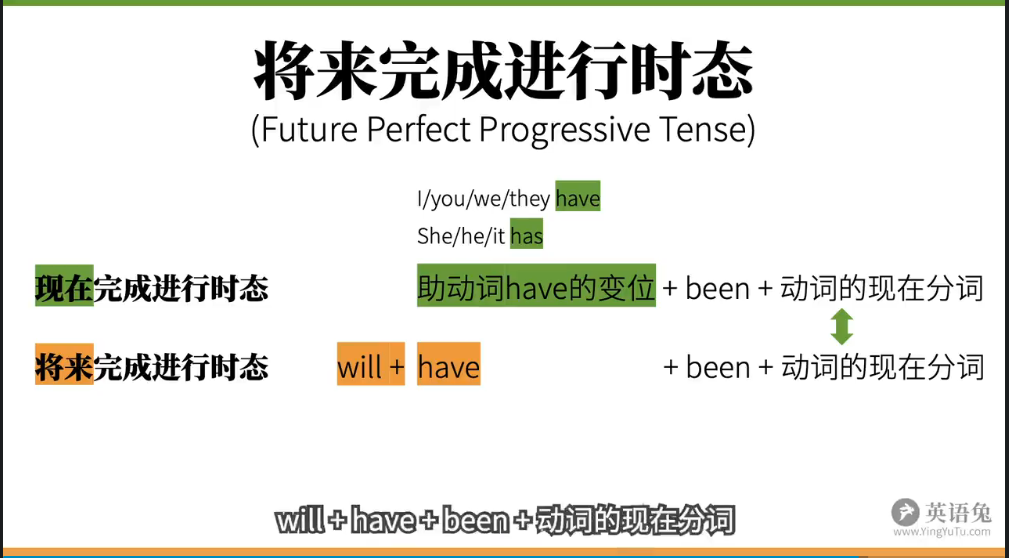


过去将来
一般过去将来时
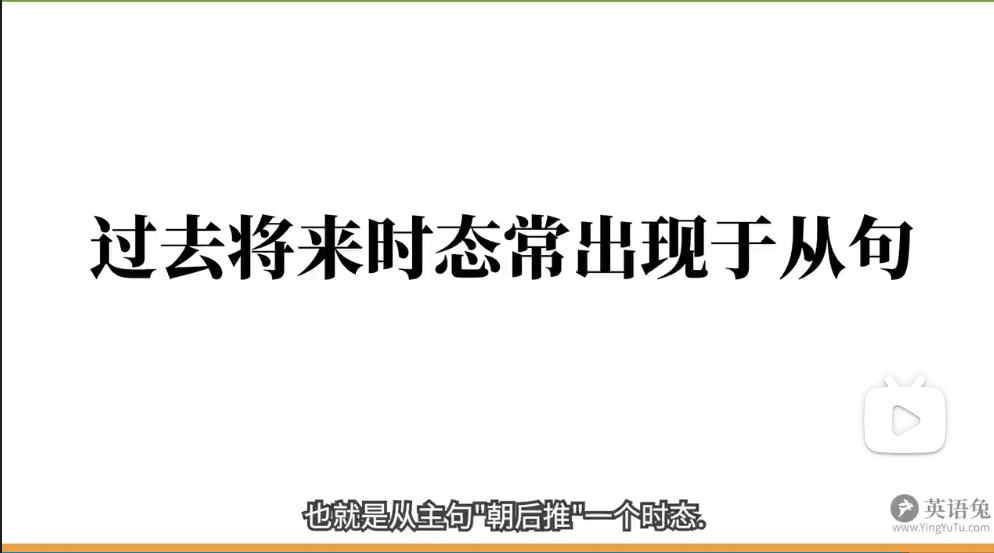

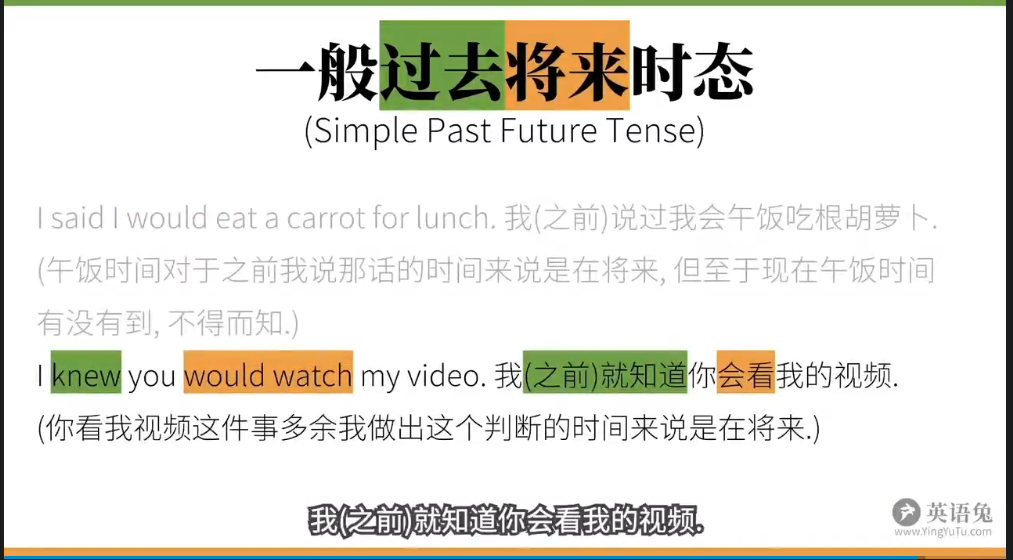
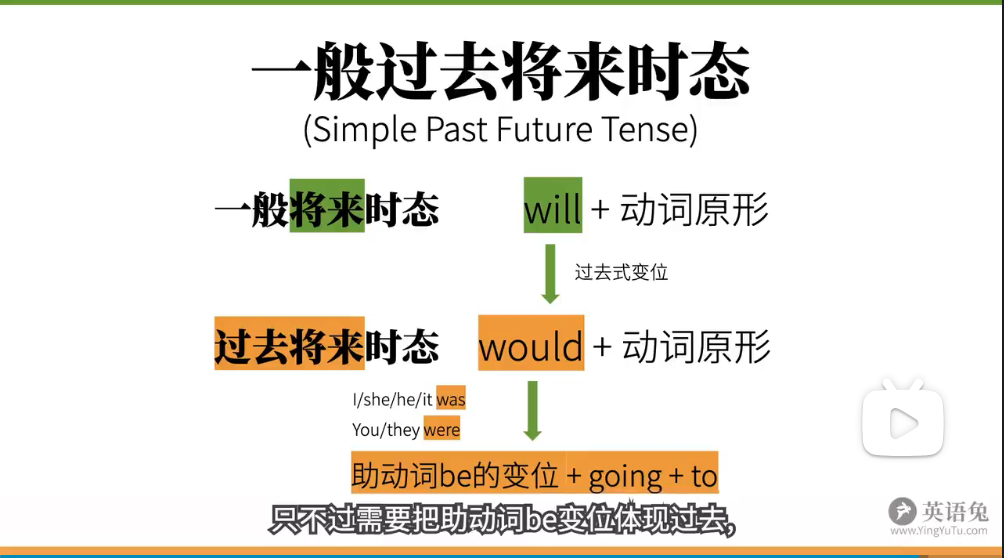
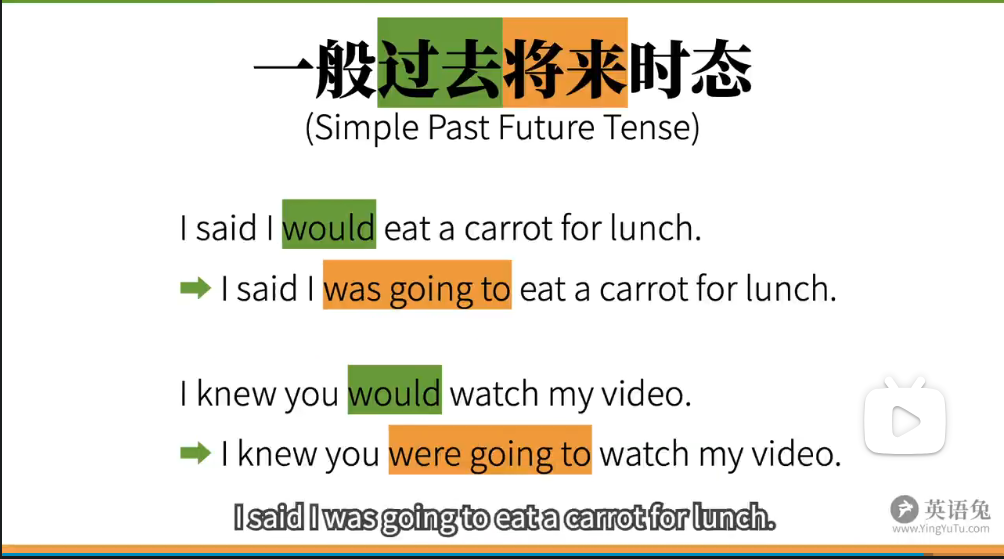

过去将来进行时

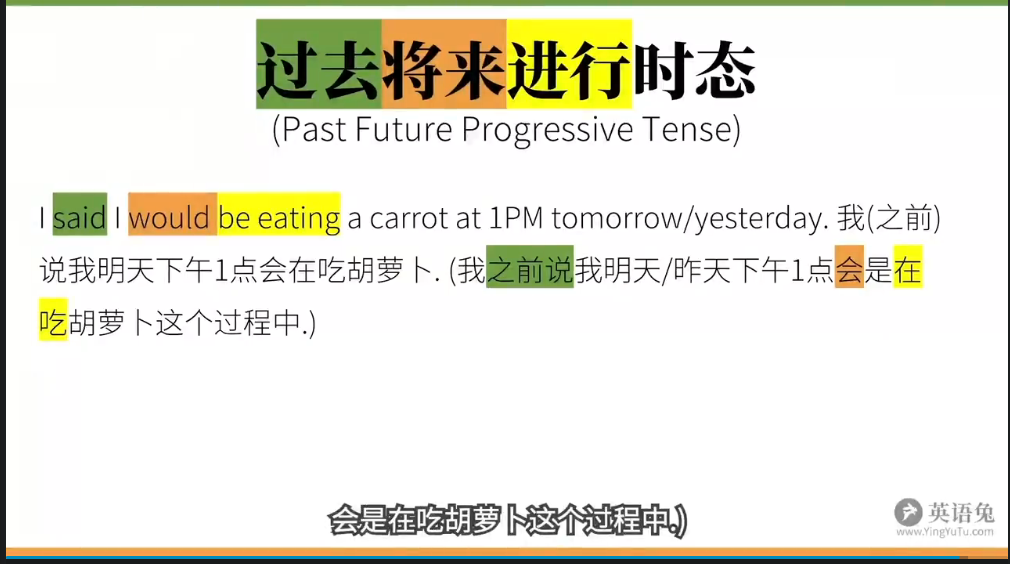
过去将来完成时

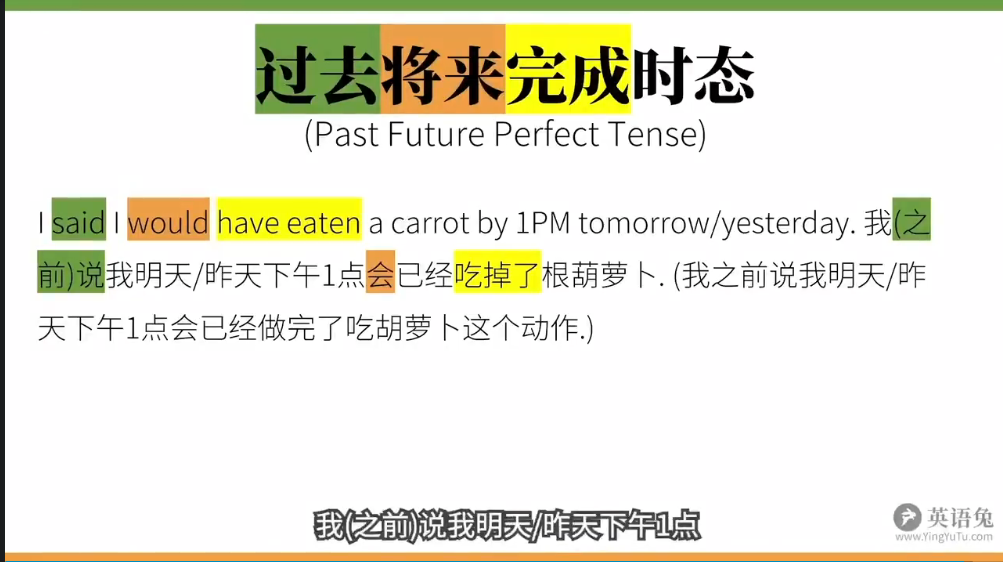
过去将来完成进行时
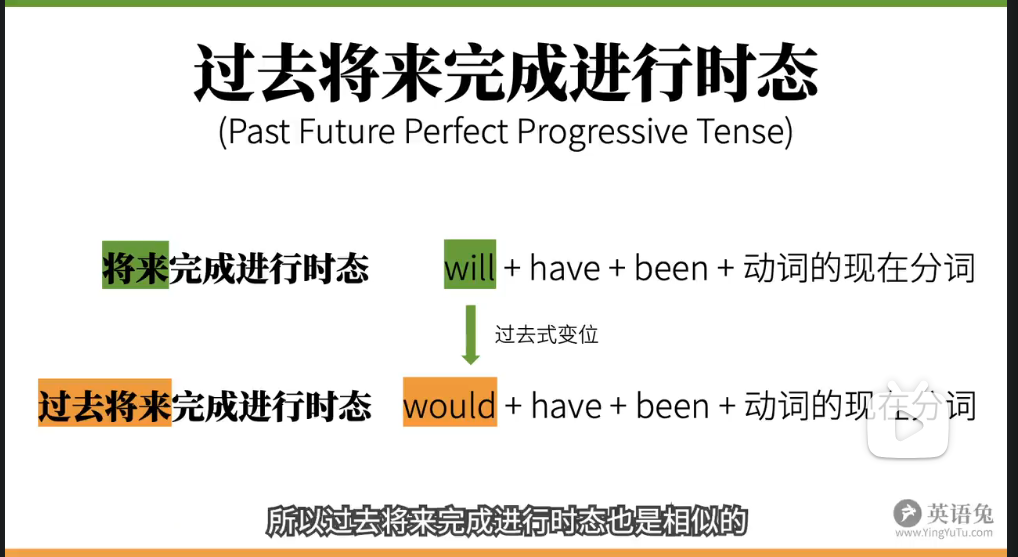
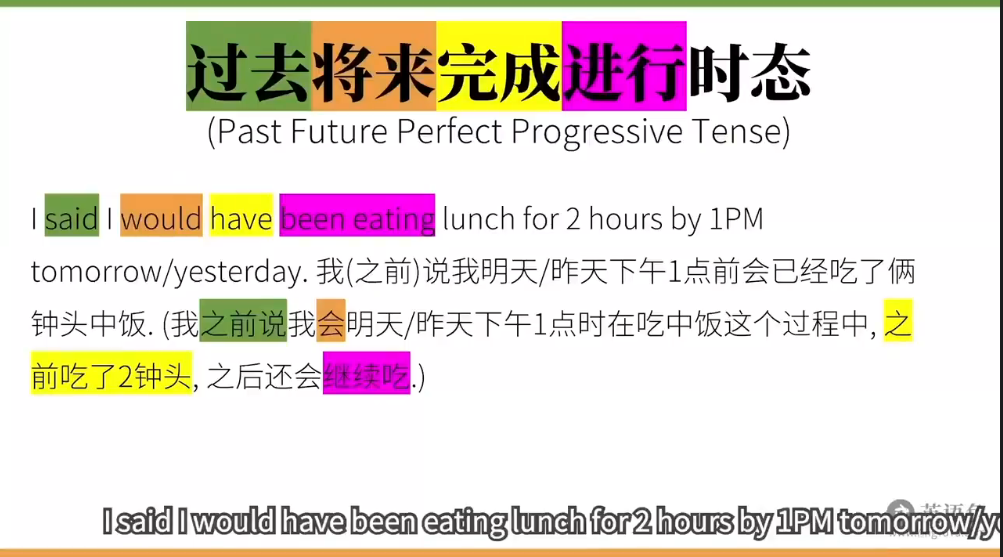
动词
英语语法的核心就是动词,动词能够串起几乎所有语法概念。
动词分类
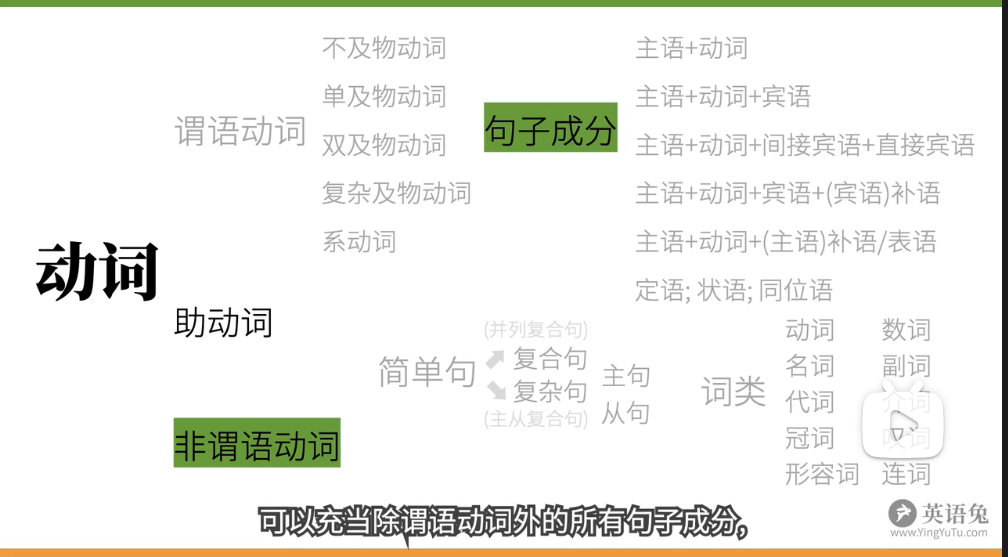

完全及物动词和不完全及物动词:是否需要宾语补足语
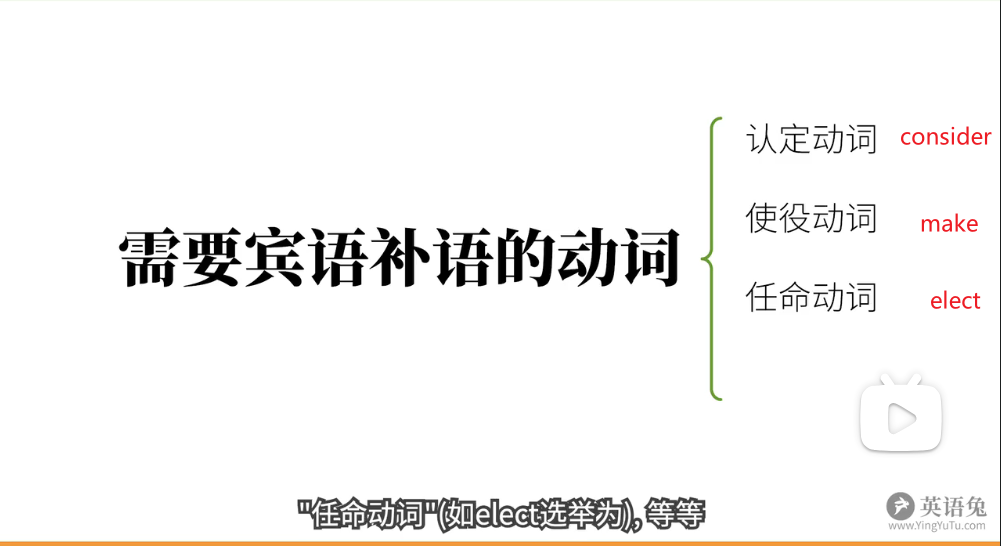
谓语动词
谓语动词有三大本领:表示动作时间、表示动作状态、表示动作假设情感等。

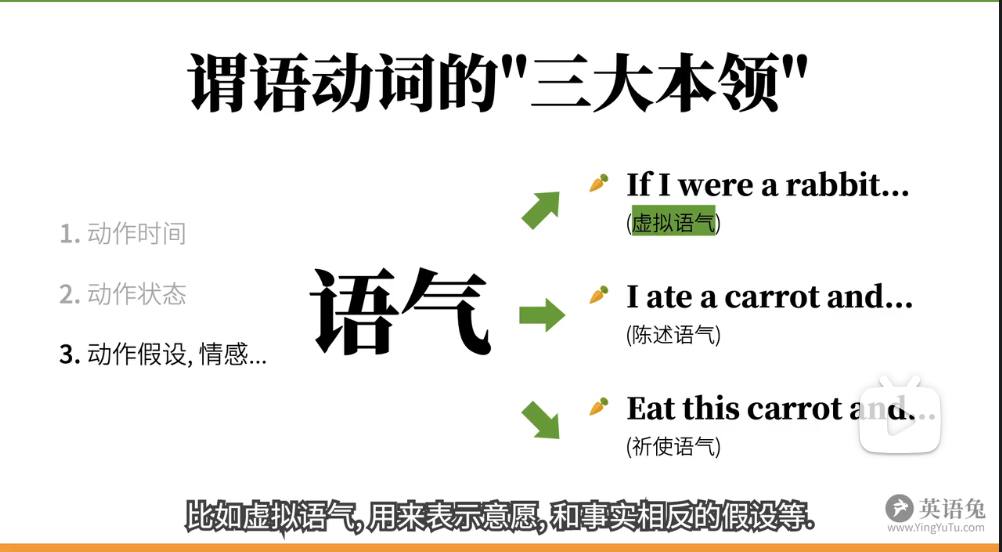
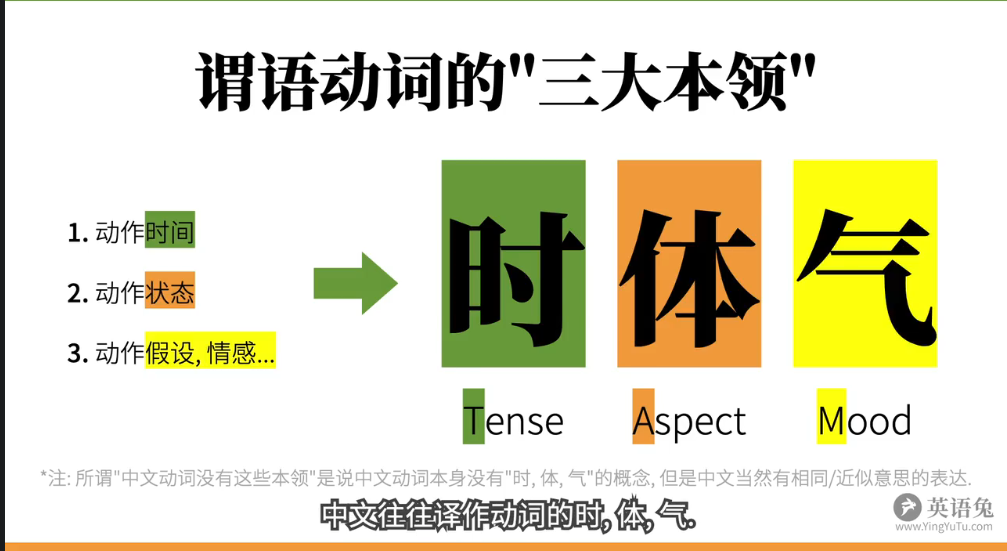
助动词Auxiliary Verbs&情态动词Modal Verbs

这些词语作为助动词(没有实义,只是帮助谓语动词)和实义动词意义不同,这点要注意区分。
be:存在
have:有,吃
can:易拉罐
might:能力
must:发霉的
do:做某事
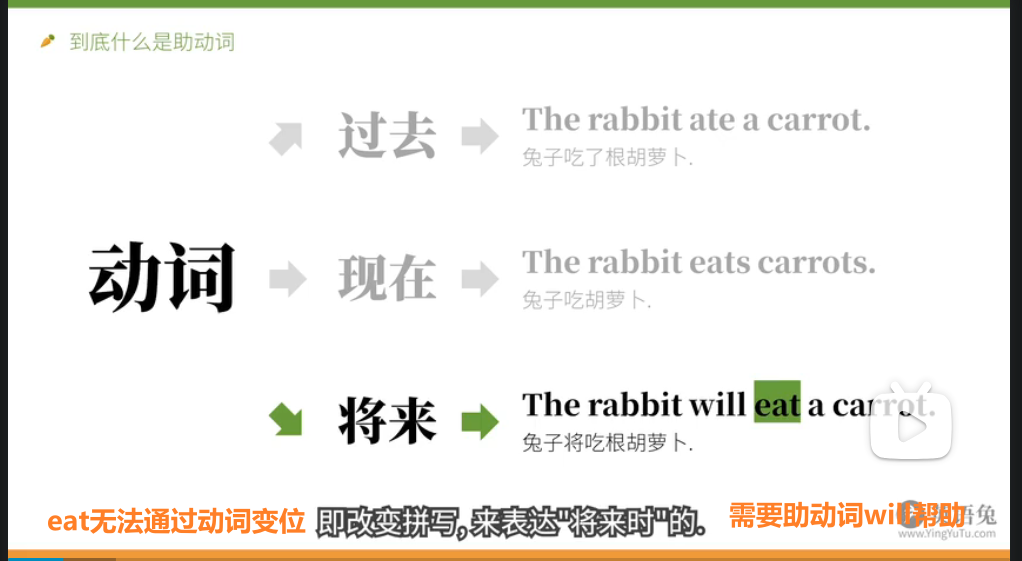
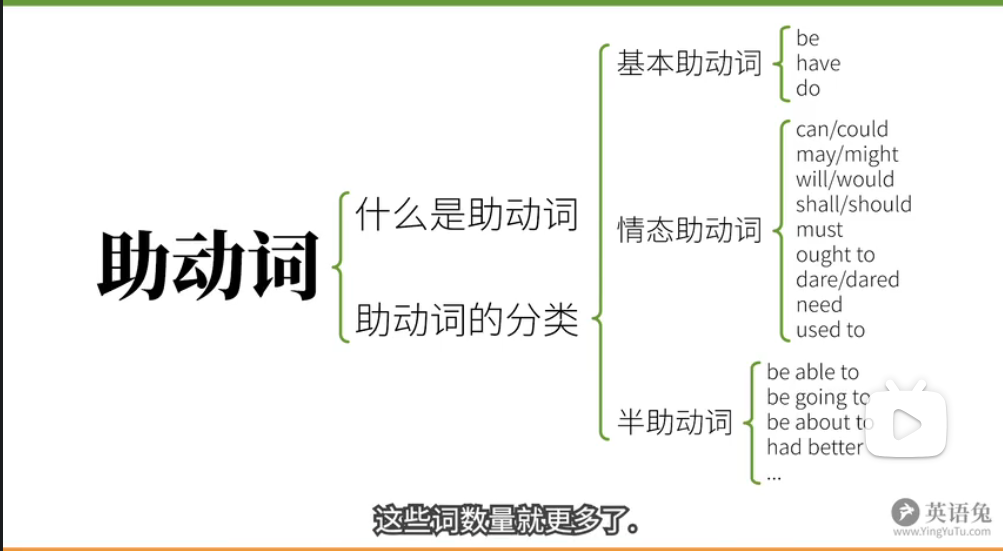


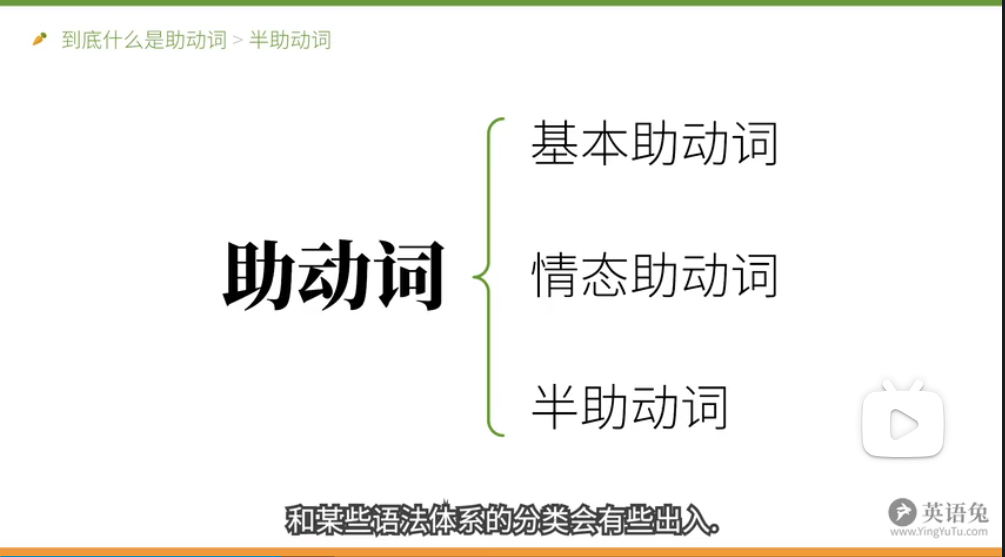

The rabbit can kill a wolf.
这里不能写成:The rabbit can a wolf.
根据功能,can这类的情态动词还是助动词的一种。
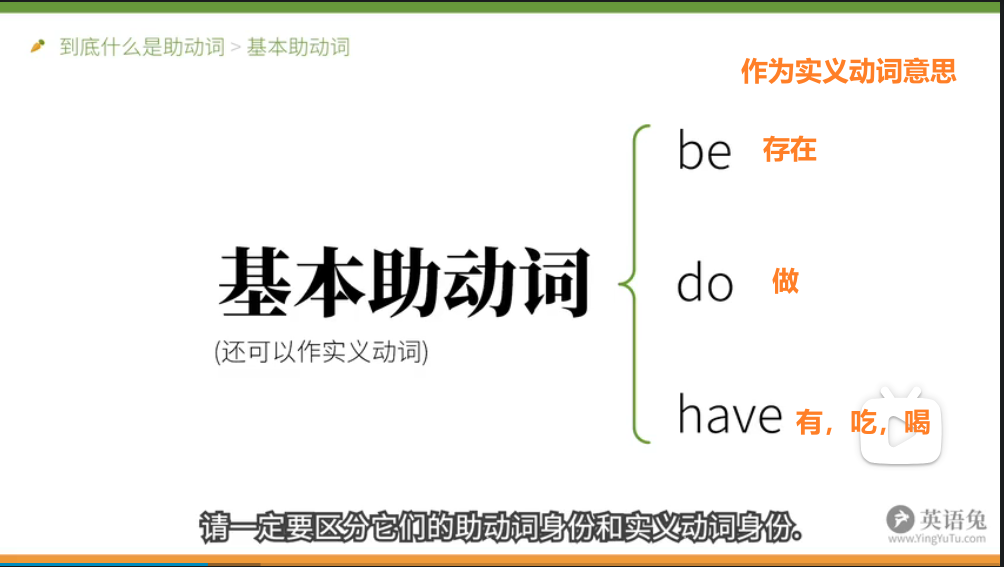
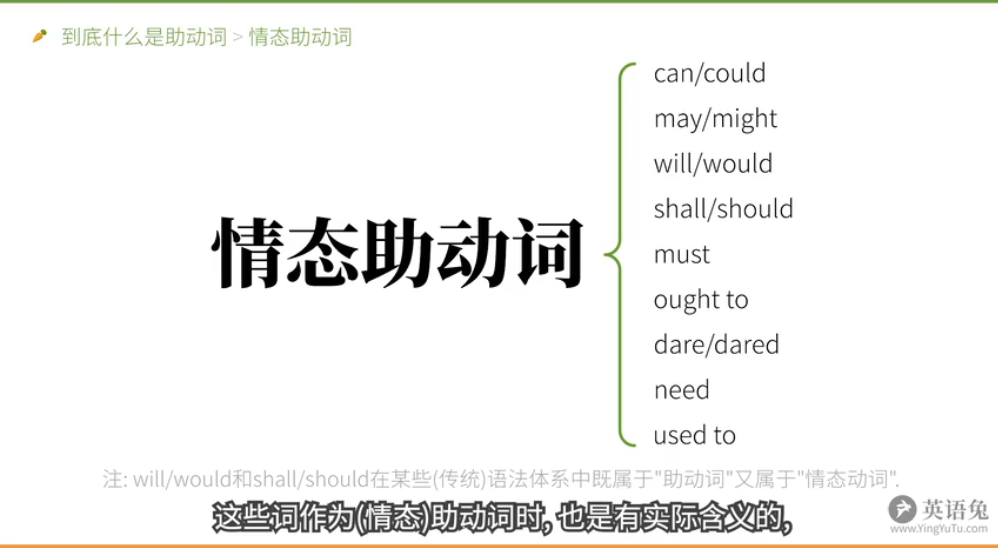
但很多“情态助动词”不能充当谓语动词。
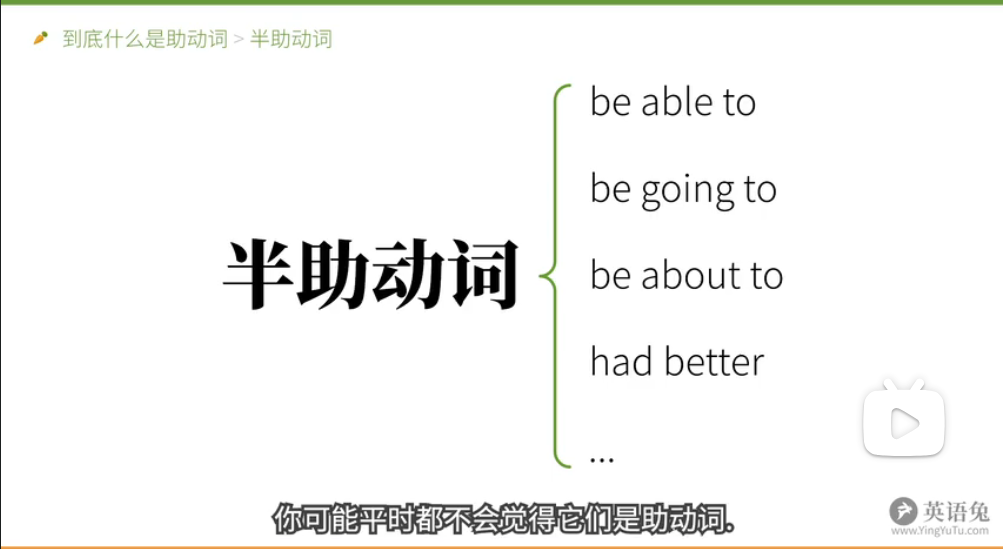
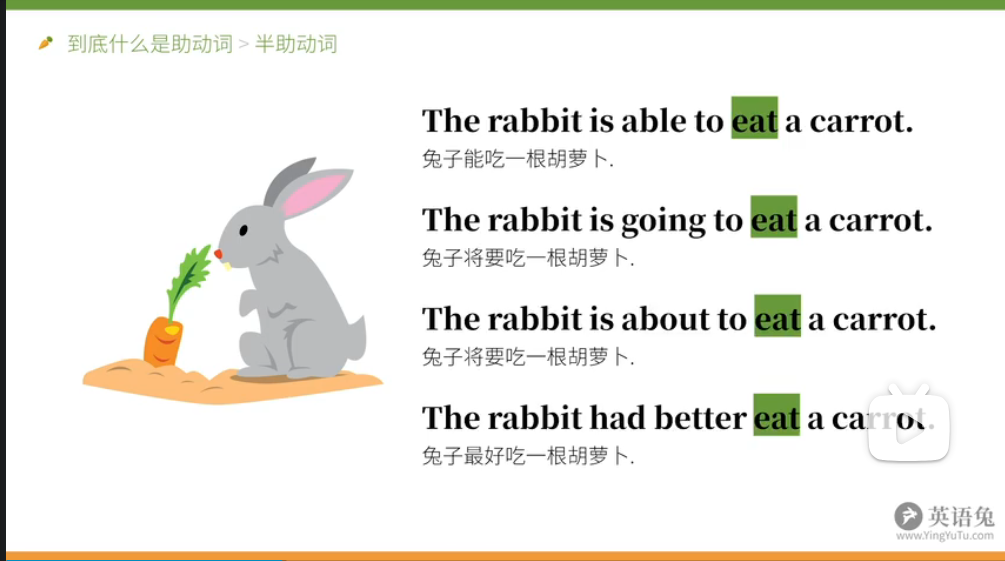
基本助动词be
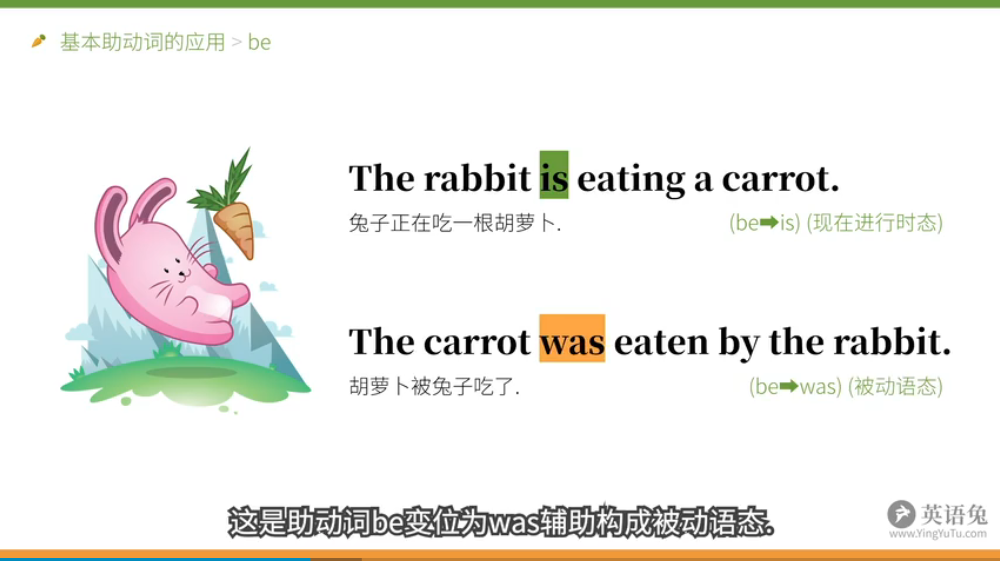
基本助动词have
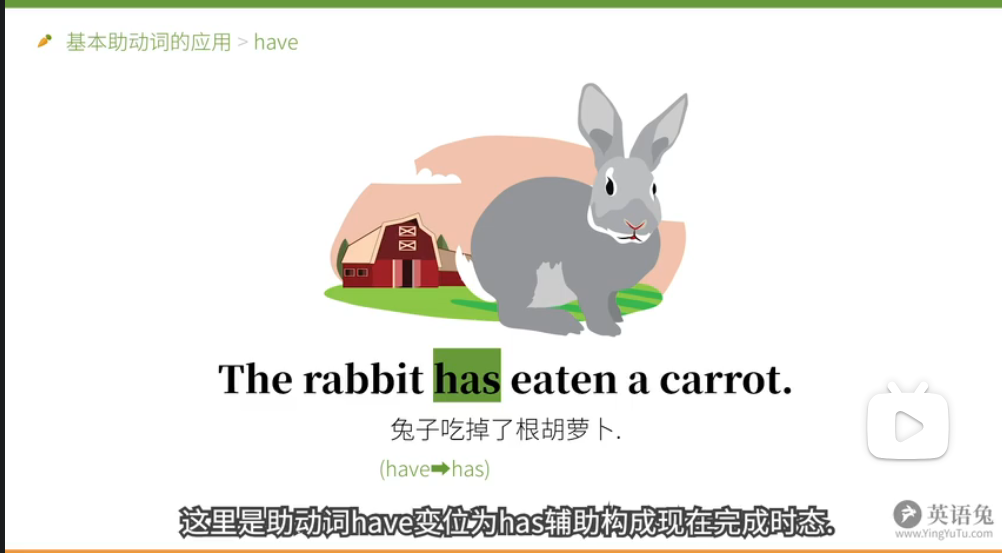
基本助动词do
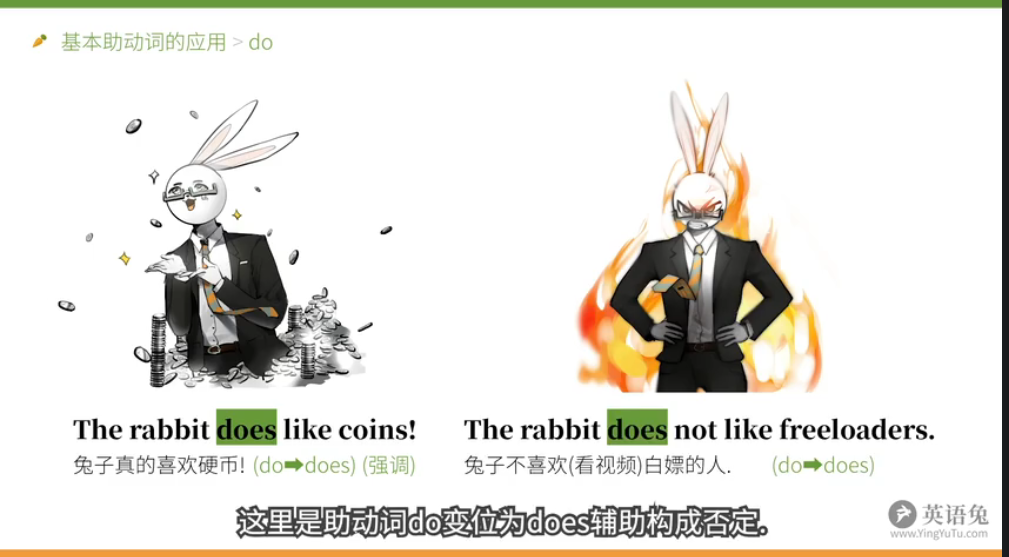
情态助动词 can/could
1.表示有能力做某事
I can kill a wolf.
I could kill a wolf last year.
2.表能力或许可
Can/Could I borrow your book?
Yes, of course.
3.表达可能性
Anything can happen.

The rabbit could have gone home earlier, but he didn't finish work on time.
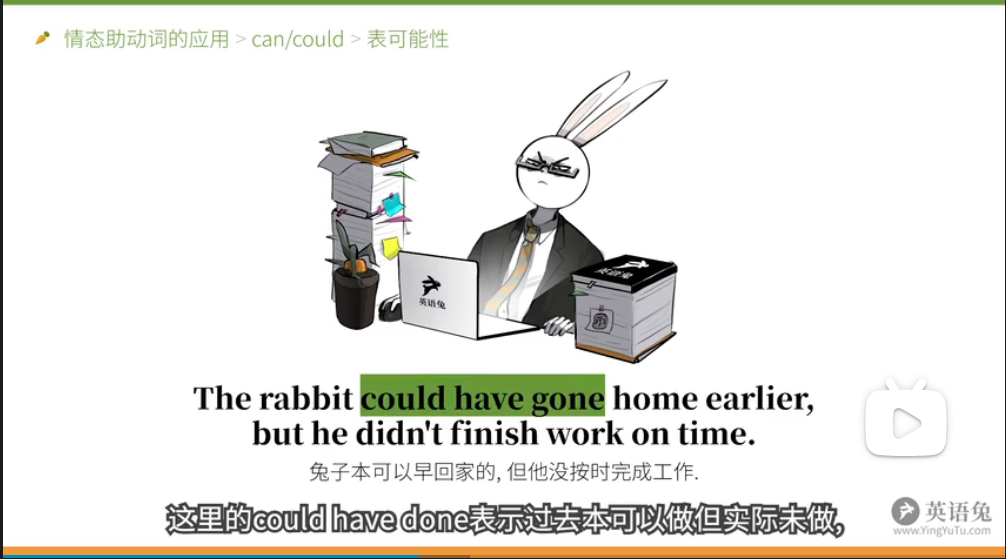
情态助动词 may/might
1.表请求或许可
May/Might I borrow your book?
Yes, of course.
2.表达可能性,译为可能,也许

The rabbit isn't here. He may be at home.

3.May可以表示祝愿,放在句首。
May you succeed! = Wish you success!
情态助动词 must
1.表示义务上必须
You must finish your homework first!
2.表禁止
You must's smoke here!
Must I give you a thumbs-up?
No, you need not give me a thumbs-up.
No, you don't have to give me a thumbs-up.
3.表推测,意为肯定、一定
The light is on. The rabbit must be at home.(肯定在家)
The light isn't on. The rabbit can't be at home.(不可能在家)
情态助动词 will/would
1.构成将来时
The rabbit will eat a carrot.(将来)
The rabbit would eat a carrot. (过去将来,这里其实也能表示推测,具体意思要看语境。)
2.表示请求或建议
Will you lend me that book?
Yes, of course.
Would you please lend me that book?
3.表推测,假设
Ask him.He will/would know.


情态助动词 shall/should
1.构成将来时
I shall/will be there at 9AM.
2.表请求或征求意见
Shall we meet at 9AM?
3.表警告、命令
You shall not pass!(你不许通过!)
情态助动词 should
1.表应当
We should treat the rabbit well.
2.表示有一定根据的推测
It should rain tomorrow.
3.表竟然
It's surprising that he should be late!

4.构成虚拟语气
If it should rain tomorrow, I wouldn't go.


情态助动词ought to
表应当
We ought to treat the rabbit well.
比should语气更强一些。
情态助动词need
need作实义动词是表示需要,例如I need your coins.

作为情态动词时意思也是需要
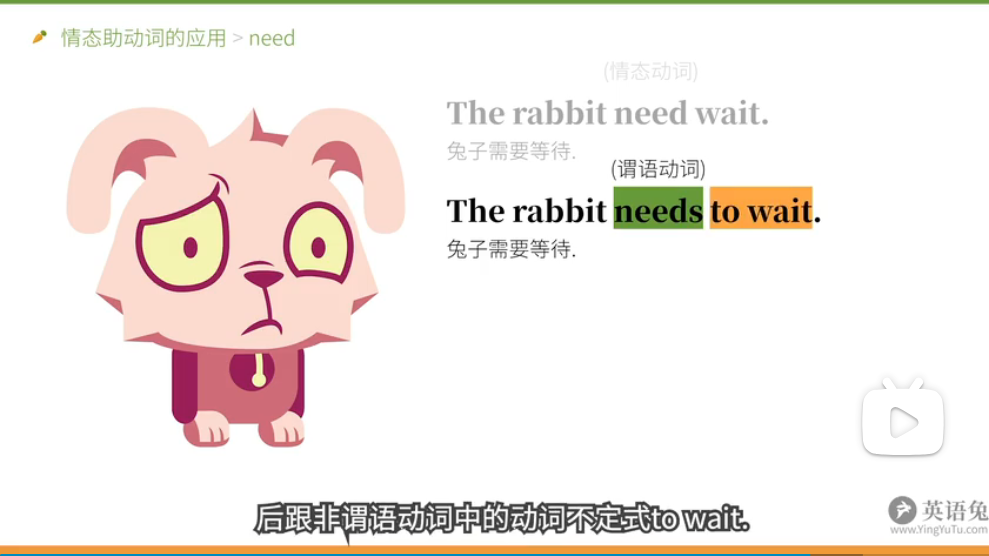
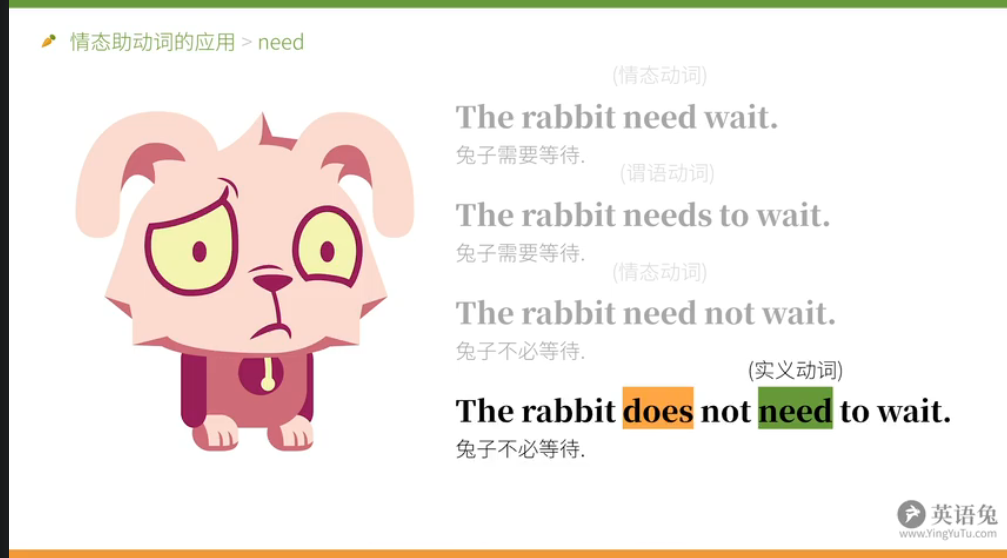
情态助动词dare


情态助动词used to
表示过去的动作,尤其是重复的动作,强调与现在的对比
The rabbit used to eat apples. Now he only eats carrots.
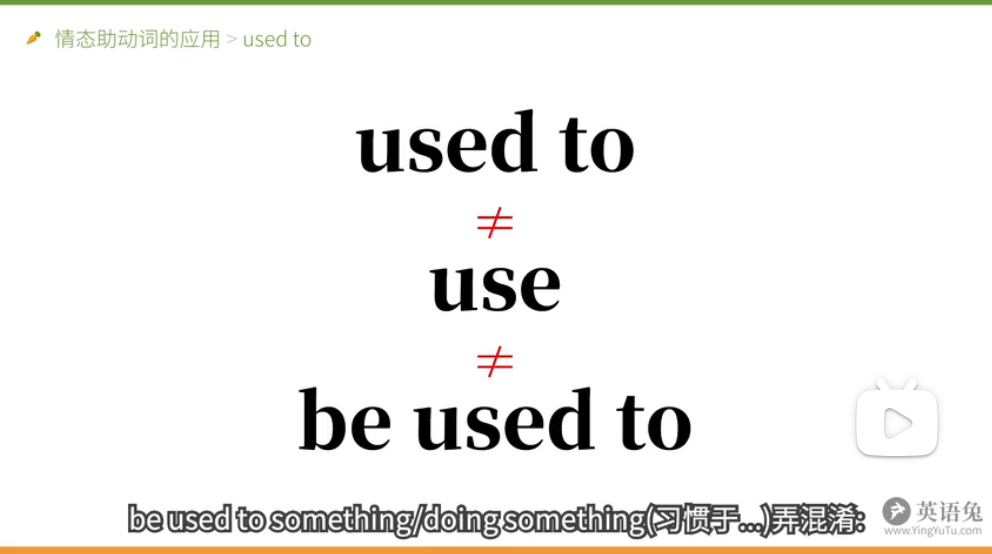

半助动词be able to

表示将来的能力,这和can/could不同
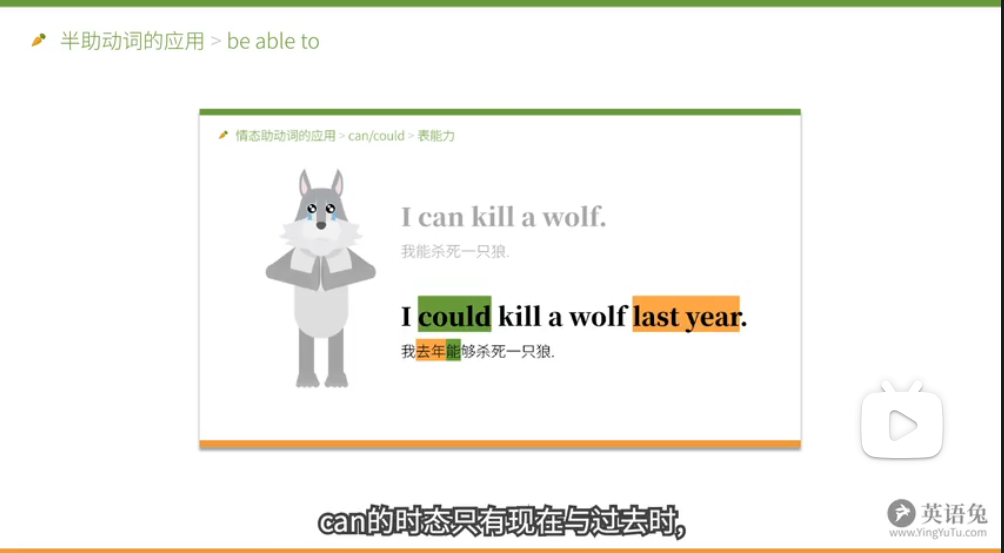

半助动词be to/be going to/be about to


be to也可以表示命中注定
I think they're to fall in love with each other.(注定会相爱)
半助动词had better

You had better follow my orders!

系动词



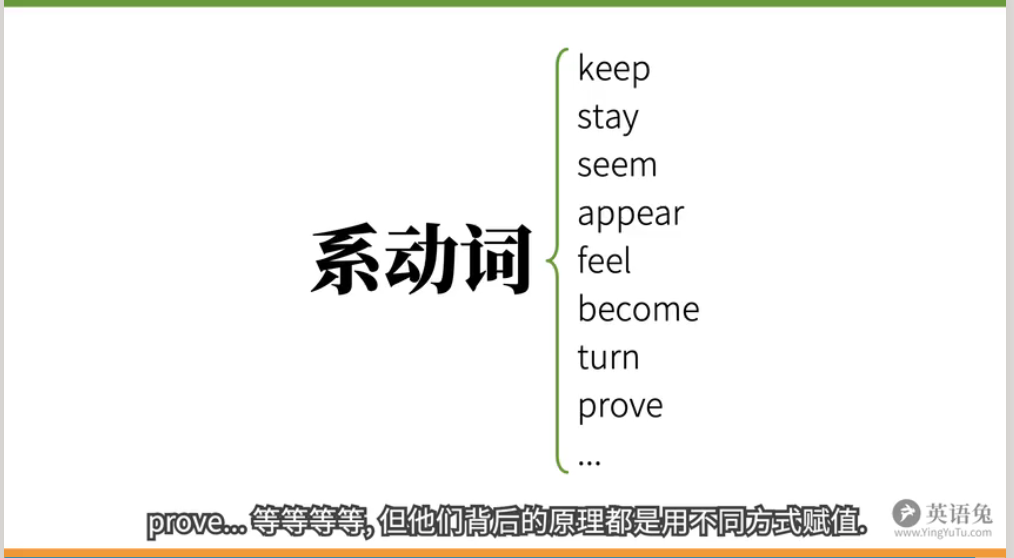
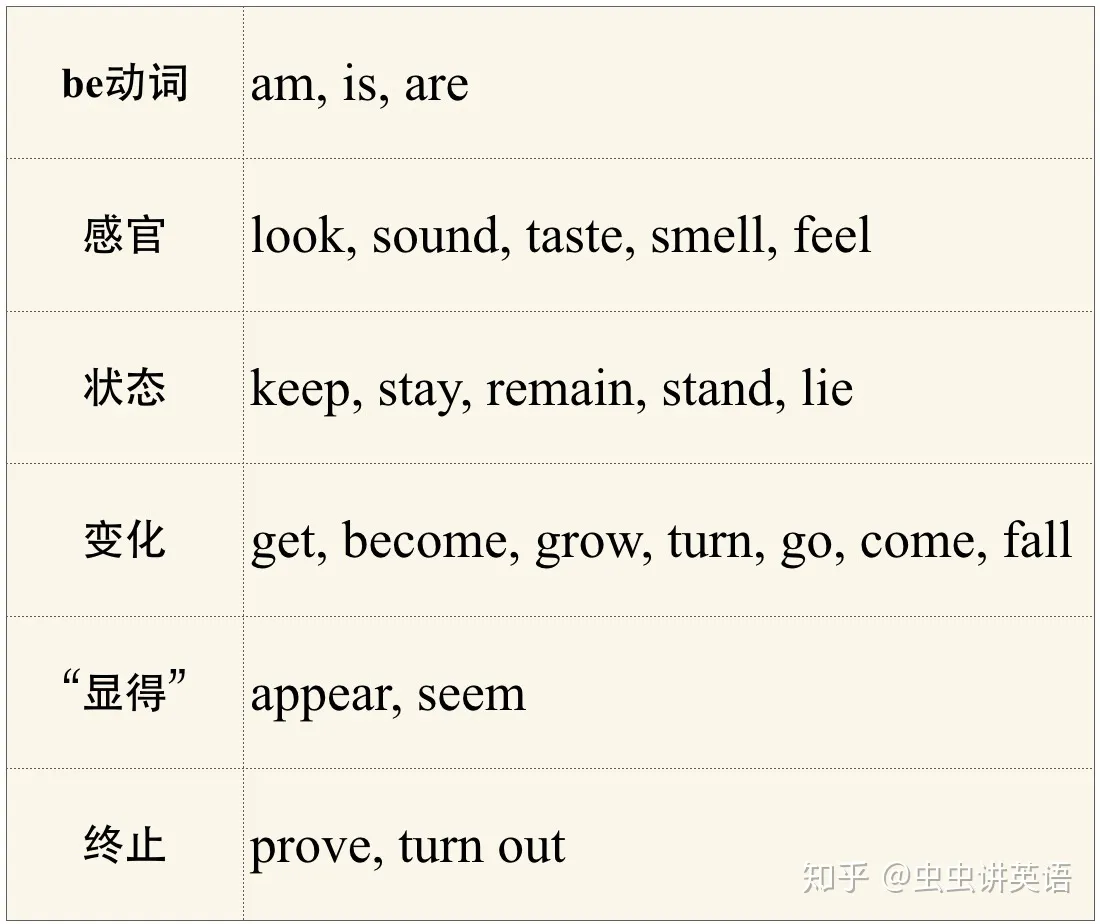
使役动词


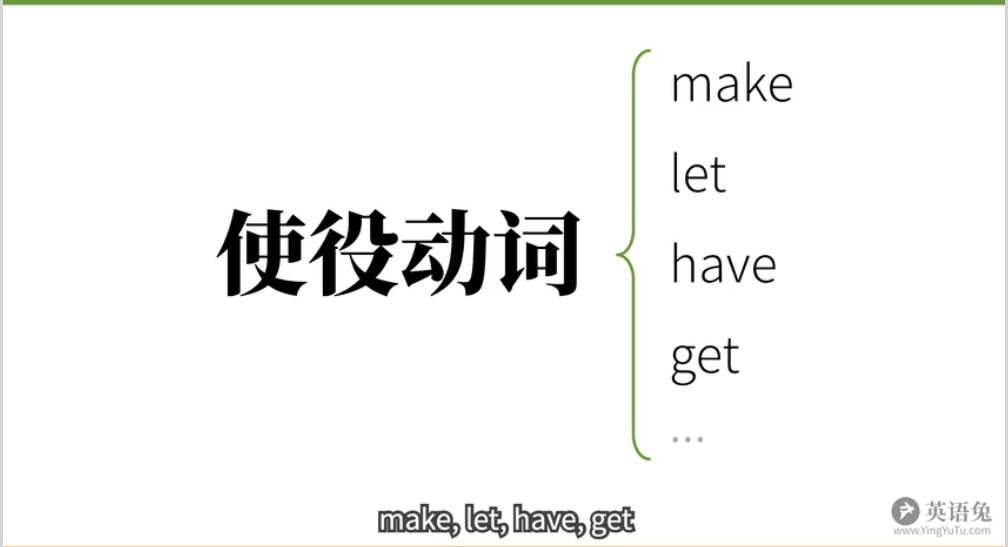
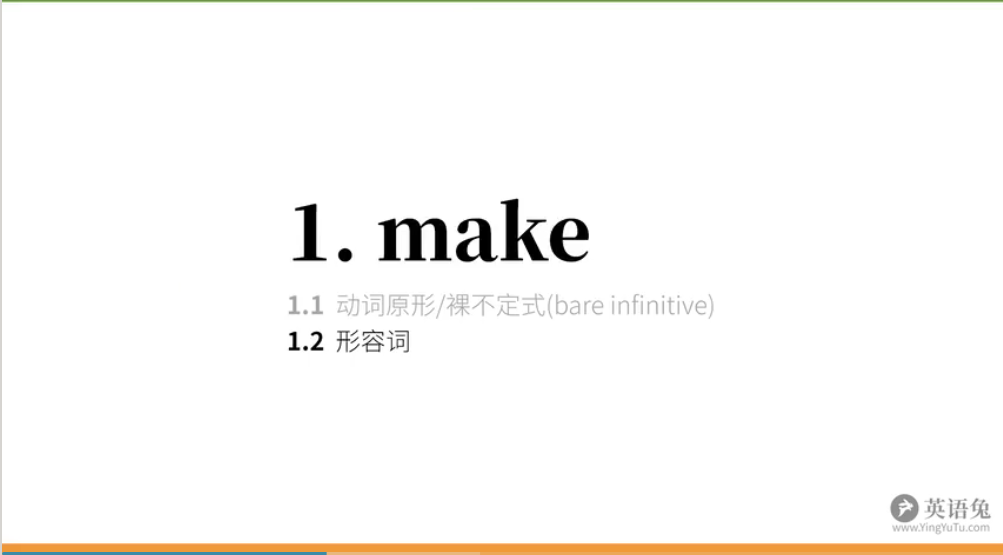

The carrot made the wolf full.



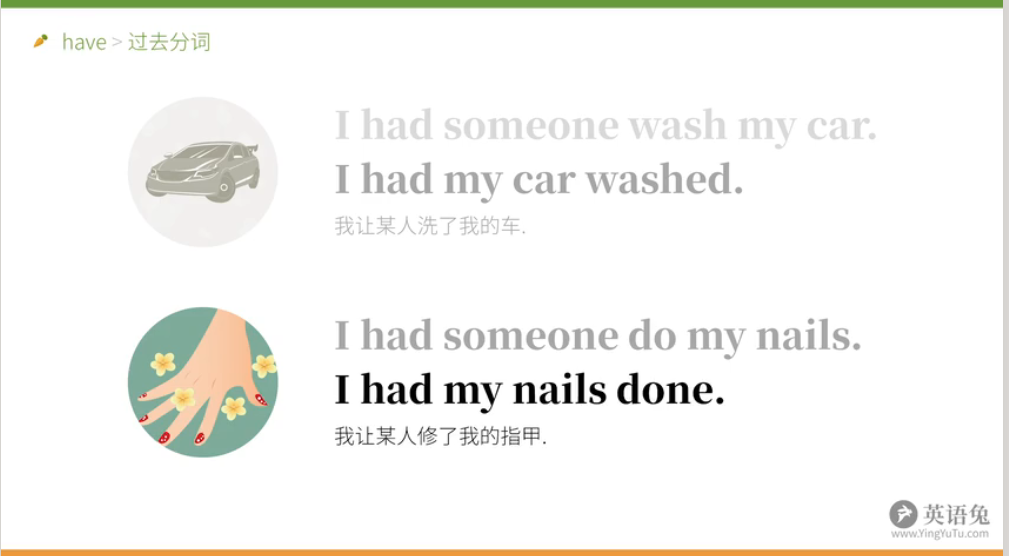
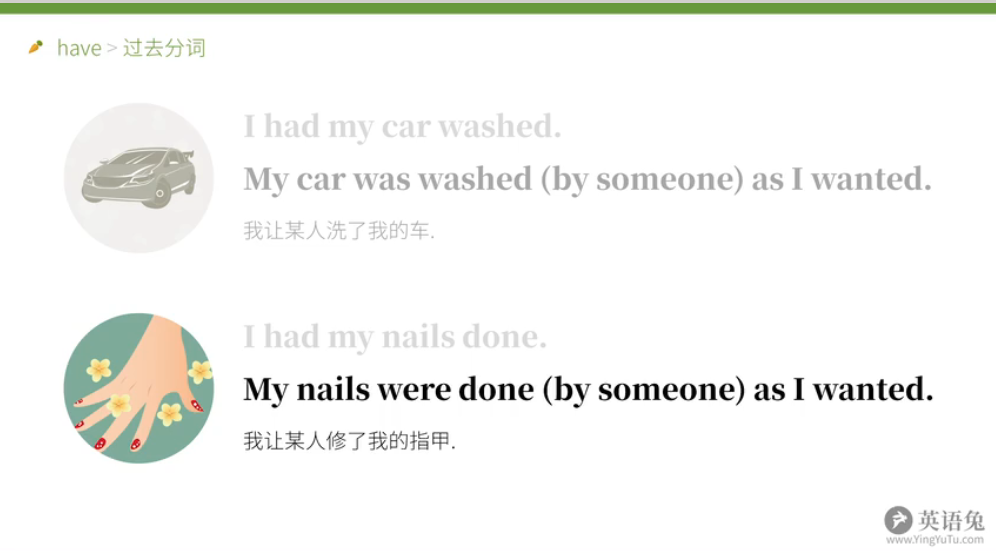

I had my carrots stolen yesterday.




非谓语动词
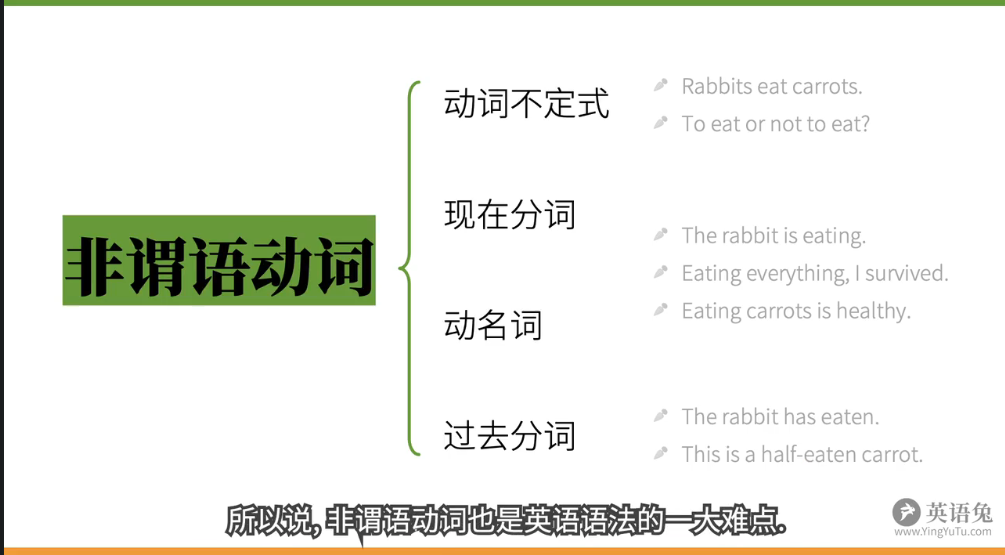
一个句子中只能有一个谓语动词,其他的动词要变为非谓语动词充当除谓语动词之外的句子成分。
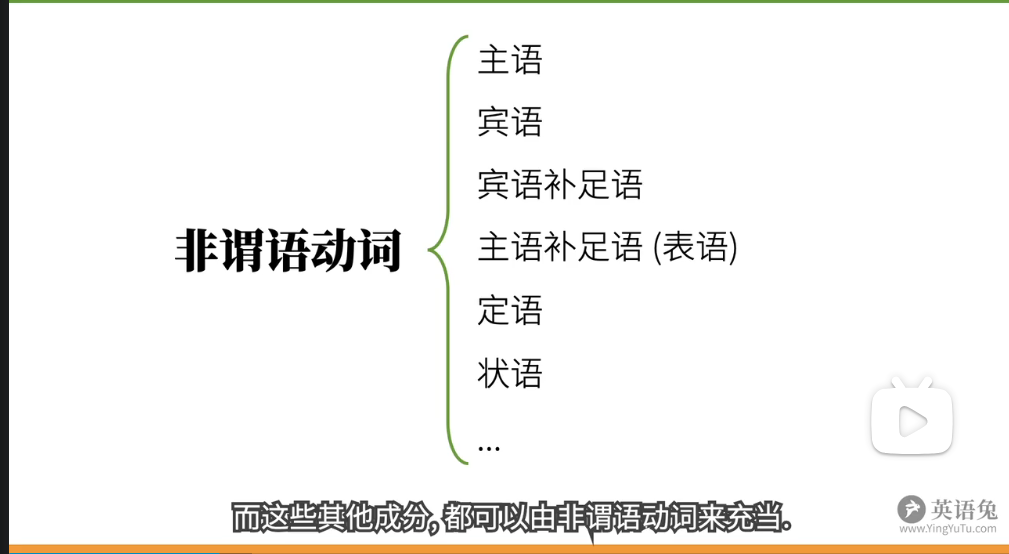
谓语动词也叫限定性动词(finite verbs),限定句子中的时间、状态和语气等。
非谓语动词也叫非限定性动词(non-finite verbs),失去了表达时间和人称的本领。

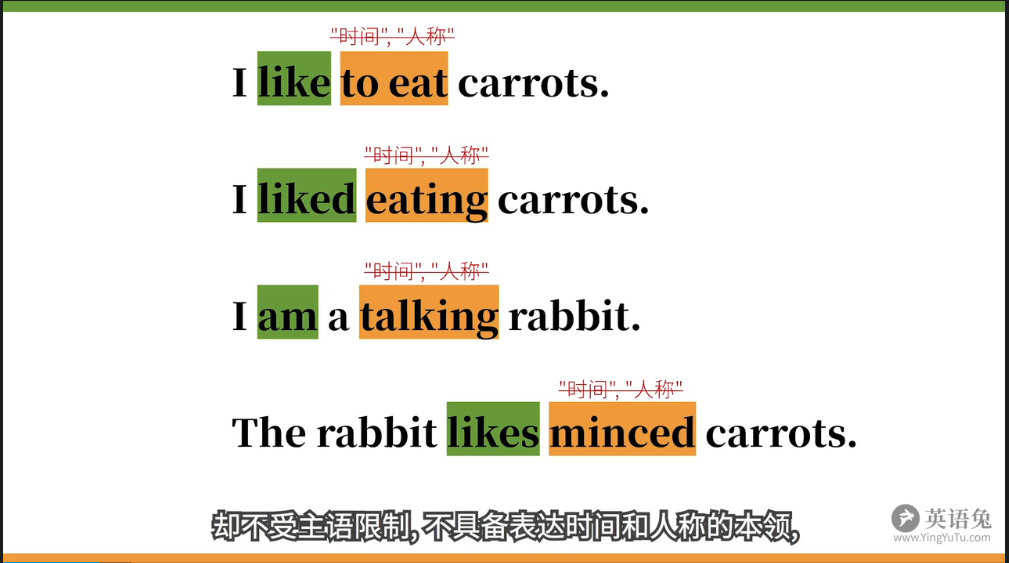
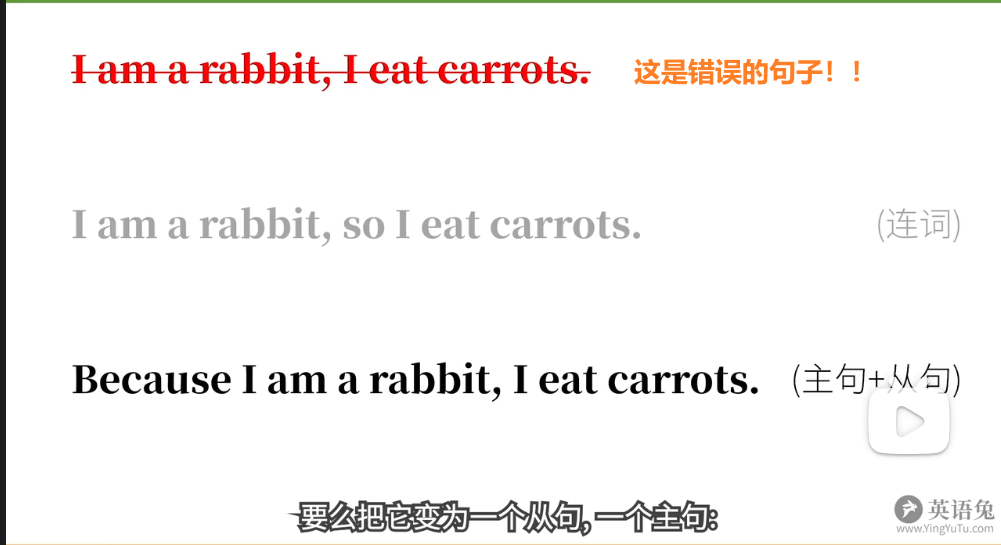
动词不定式infinitive
基本格式:to+动词原形
特性:不受时间、人称等概念的限制
例句:To be or not to be, that is a question.
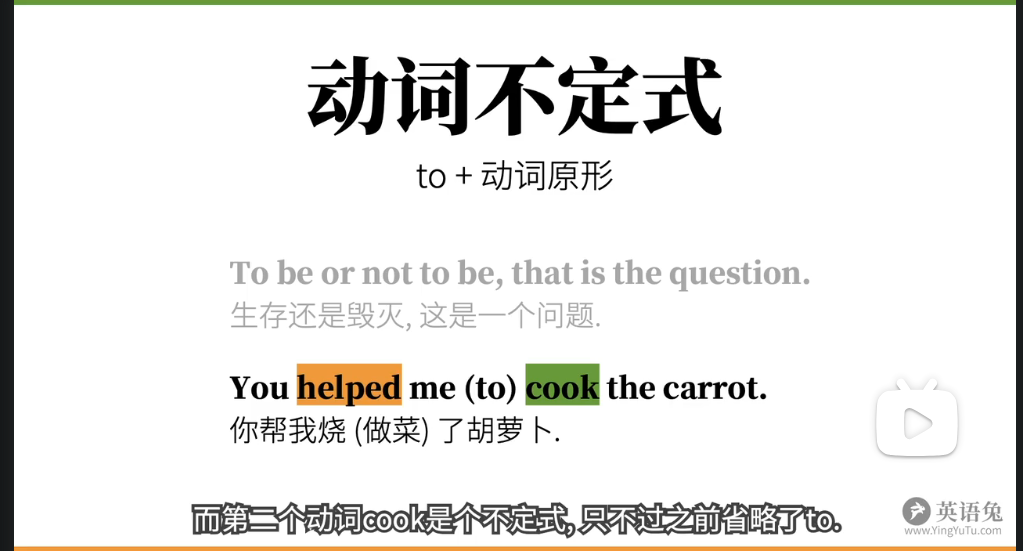
1.充当主语
To eat a carrot every day is good for the rabbit.
用it充当形式主语,能避免”头重脚轻“的问题,例如:It is good for the rabbit to eat a carrot every day.
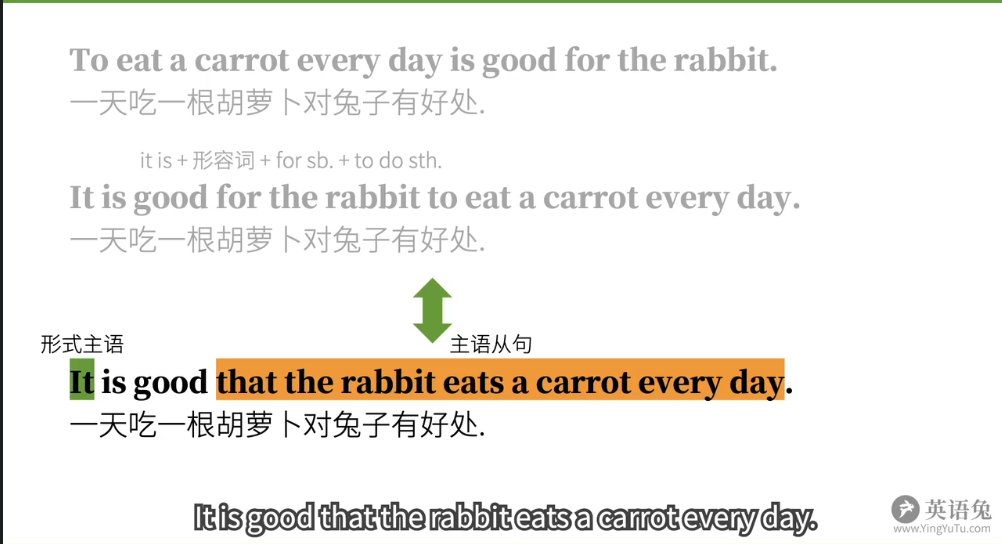
2.充当宾语
The rabbit likes to eat carrots.
3.充当宾语补足语
I consider it important to eat a carrot every day.

不定式可以和复杂及物动词一起使用,例如:The rabbit expects the wolf to eat a carrot.
这里的to eat a carrot是补充说明wolf的行为。
有些谓语动词如see、watch、find以及have、let、make等使役动词,后面用不定式作宾补时需要省略to。这些内容和bare infinitive相关。
Carrots make the rabbit feel happy.
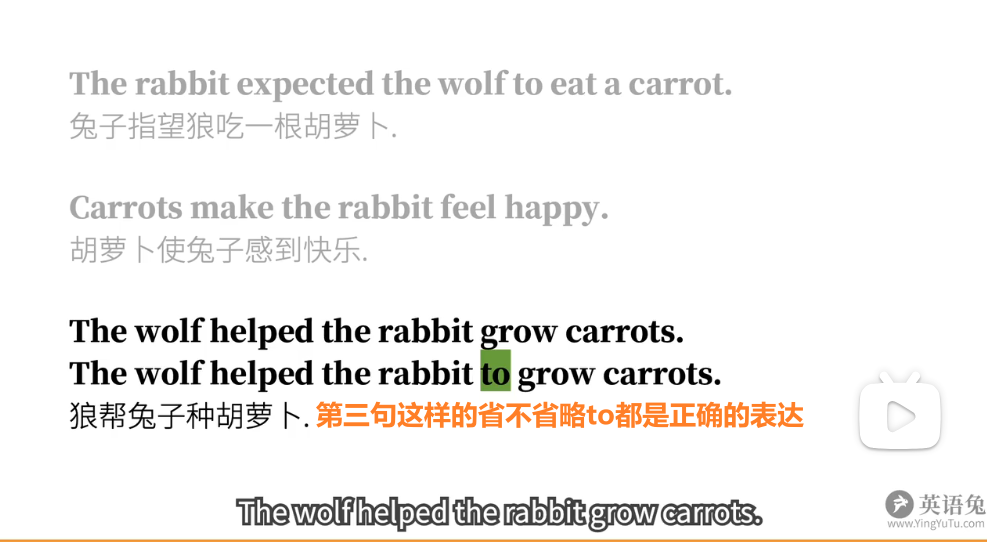
4.充当表语
The rabbit's dream is to eat every kind of carrot in the world. 这句话等价于To eat every kind of carrot is the rabbit's dream.
5.充当定语
The rabbit has a lot of carrots to eat.
6.充当状语
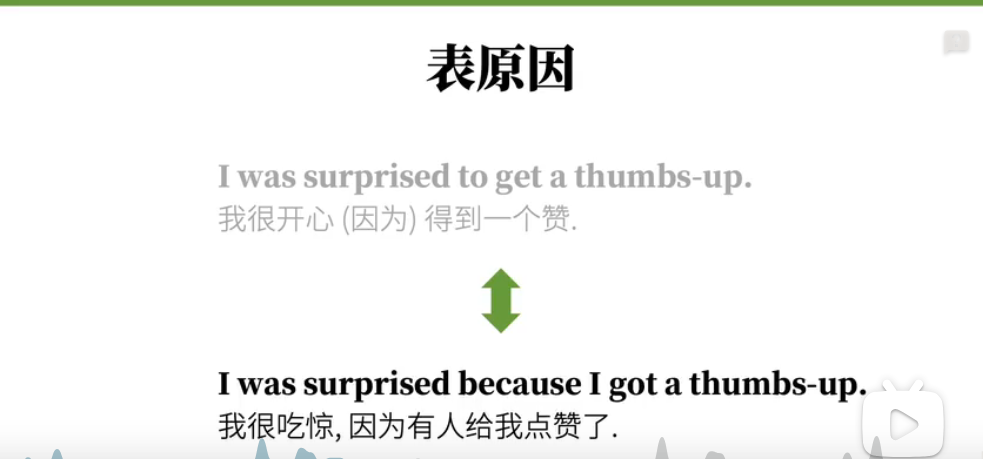
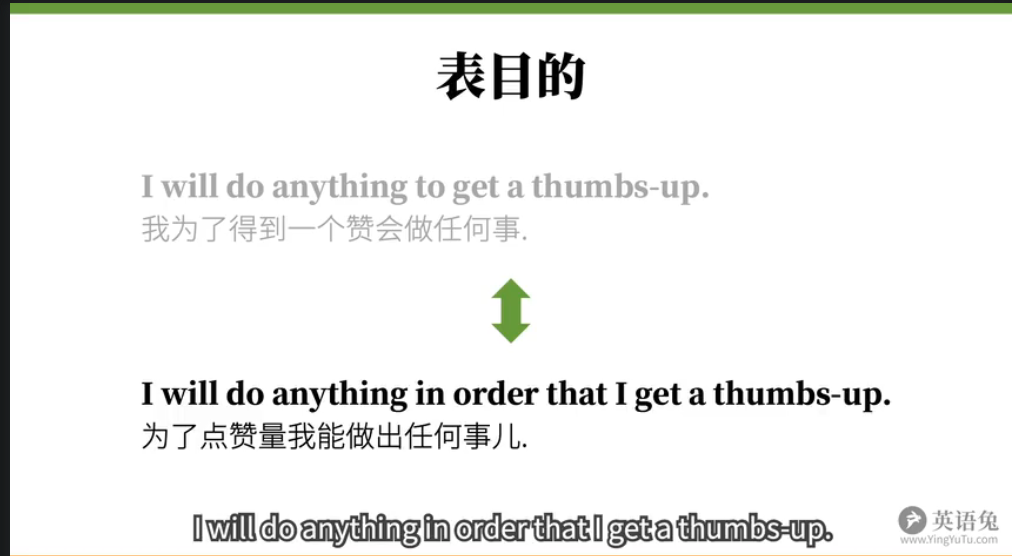

高级不定式
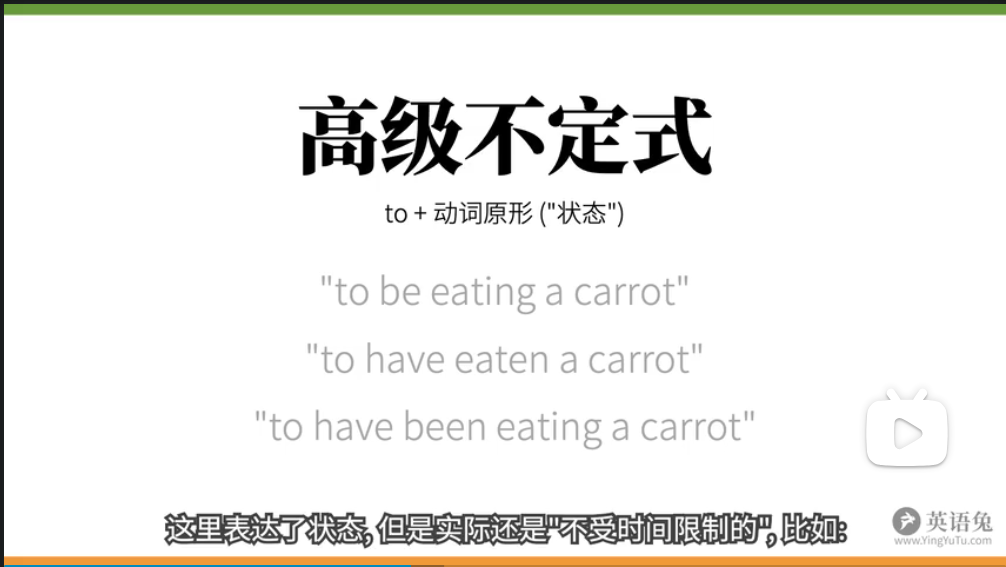
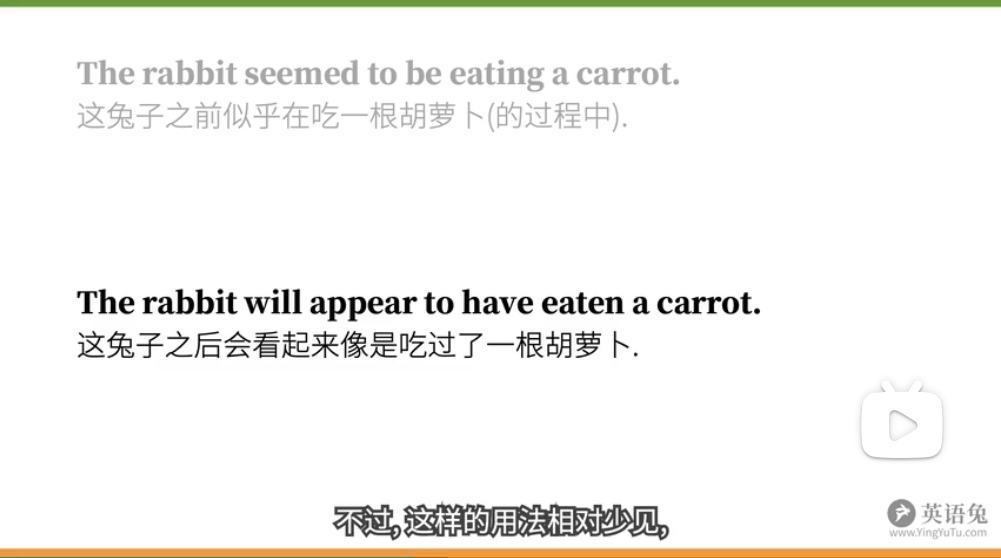
动名词
1.充当主语
Eating carrots is healthy for the rabbit.
2.充当表语
The rabbit's hobby is growing carrots.
Seeing is believing. 眼见为实,主语和表语都是动名词。
3.充当定语
a sleeping pill = a pill for sleeping
4.充当宾语
The rabbit likes to eat carrots.
The rabbit likes eating carrots.
这两句话很像啊,不过总的来说,动名词充当宾语和不定式充当宾语有明显差异。
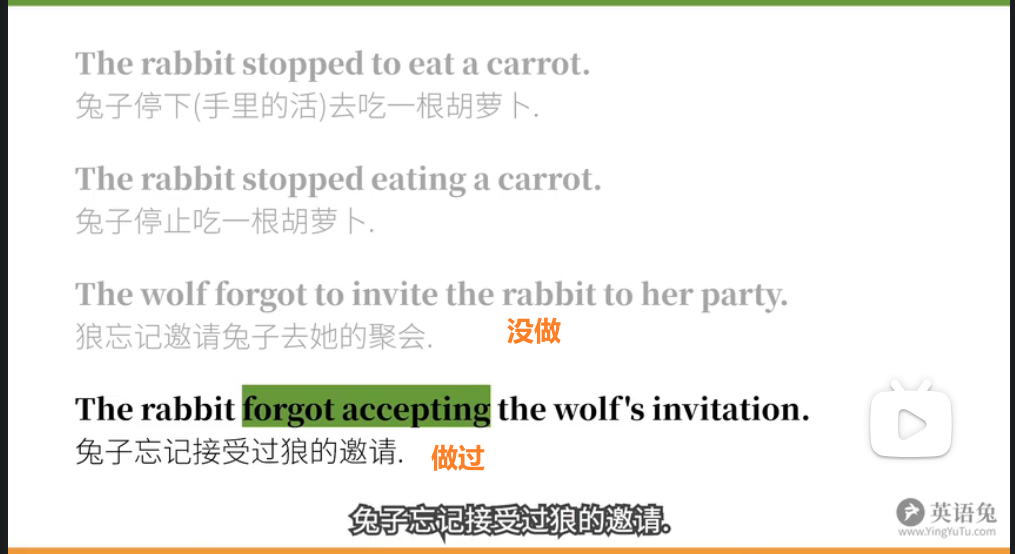
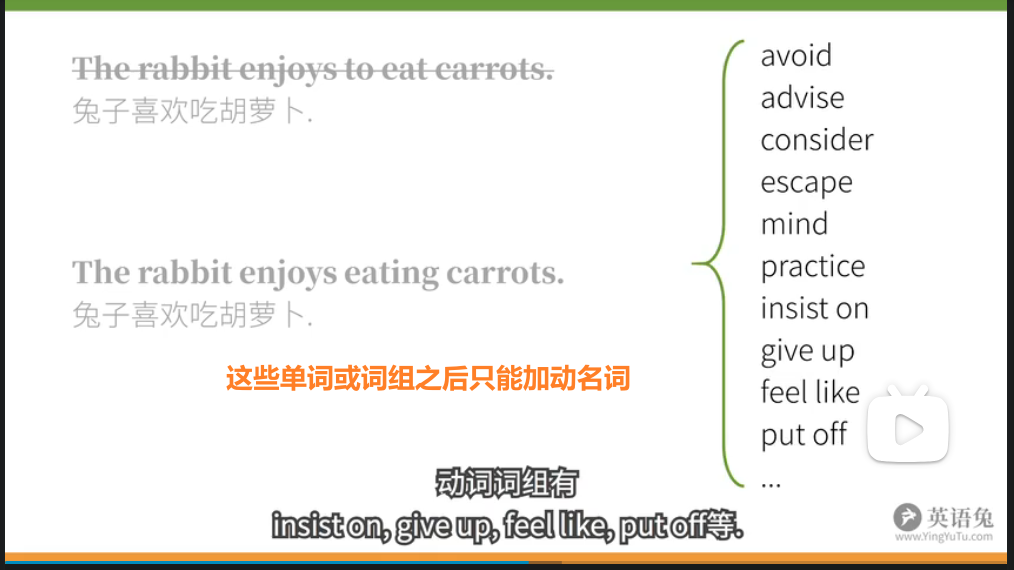

现在分词
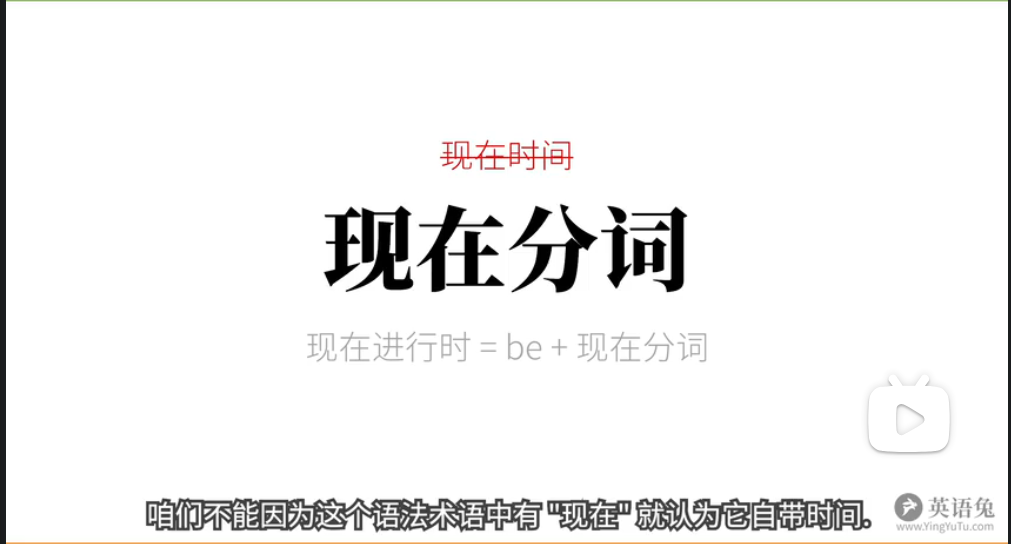
原因:非谓语动词是没有时间变化的。
1.充当定语
a talking rabbit中talking是一个充当定语的形容词,不是强调正在说话。

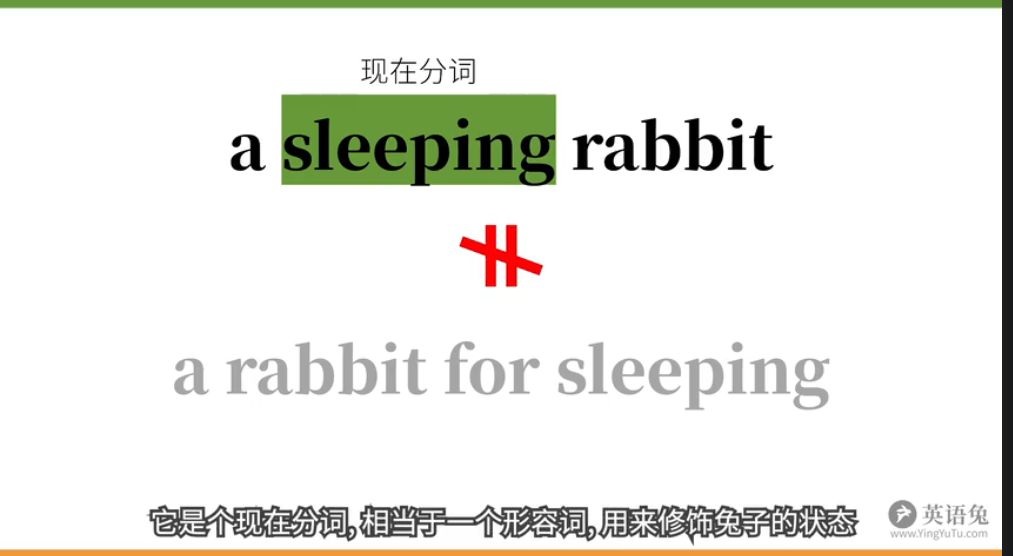
2.充当表语
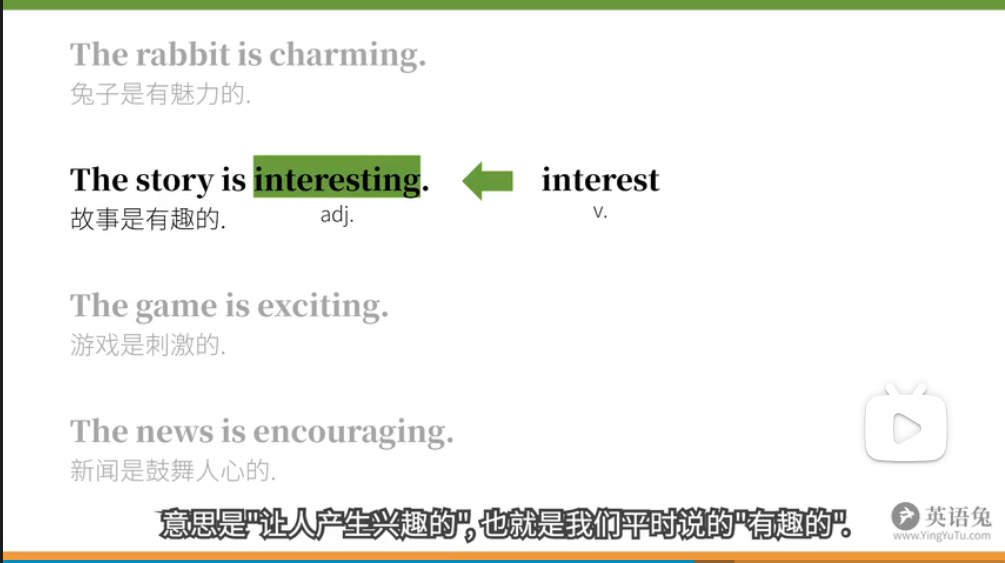
3.充当宾语补足语
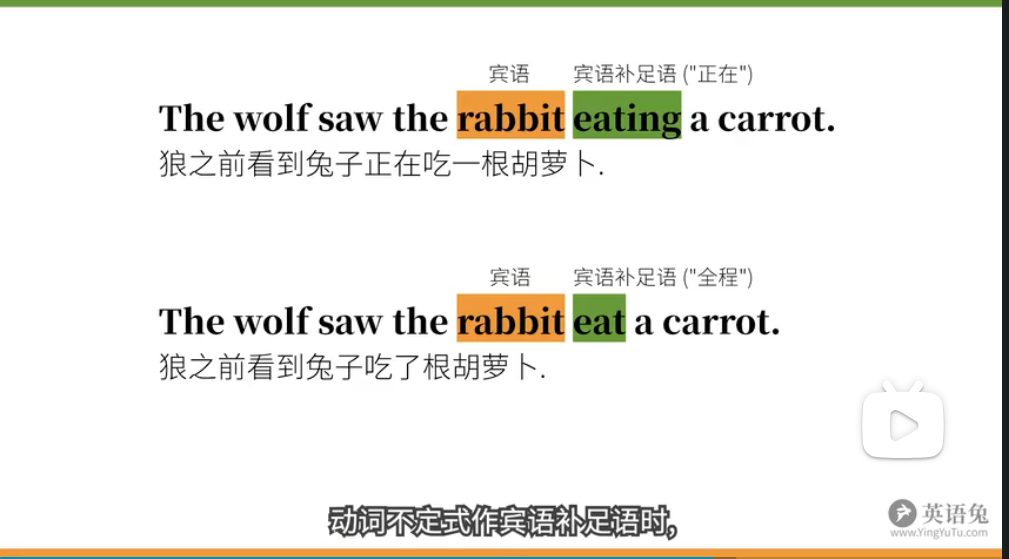
4.充当状语

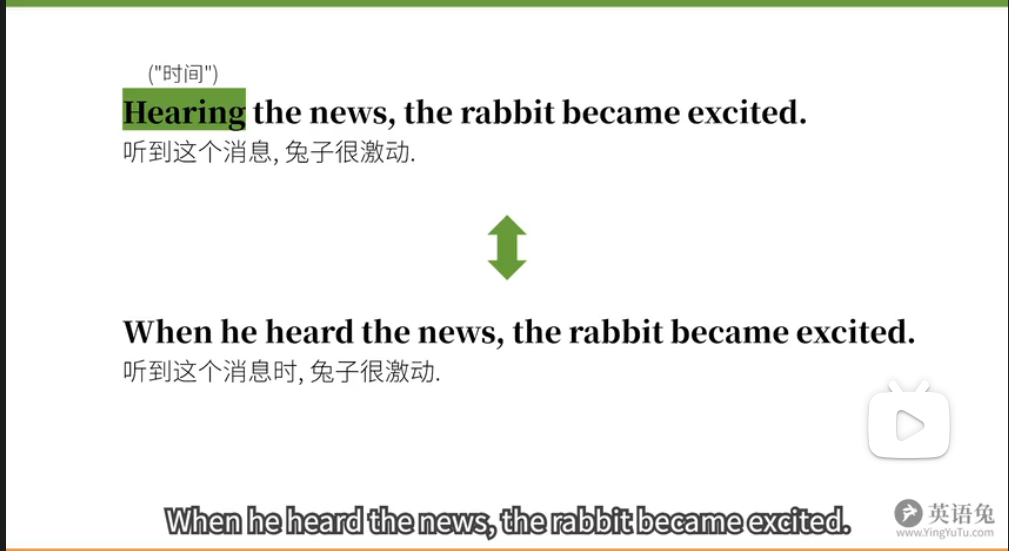
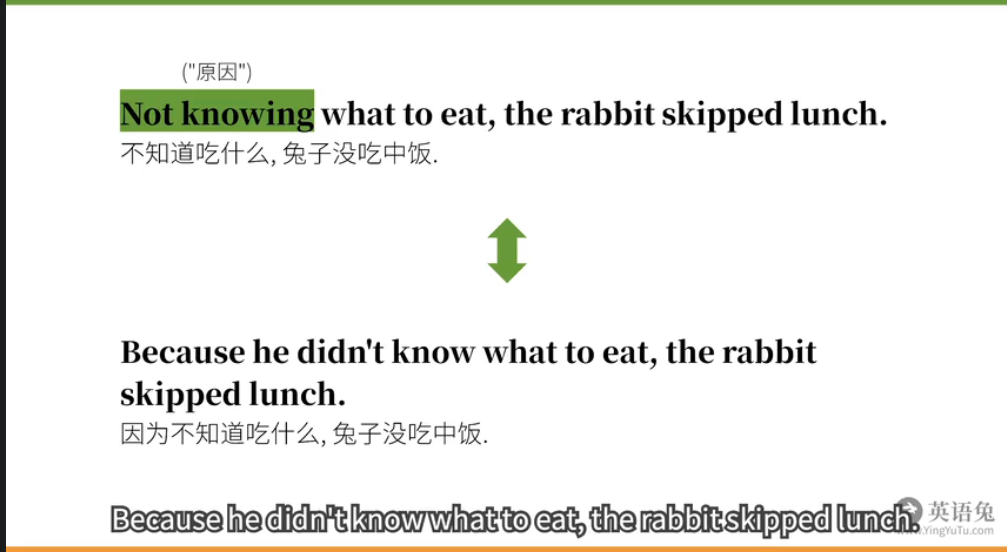

过去分词
1.充当定语


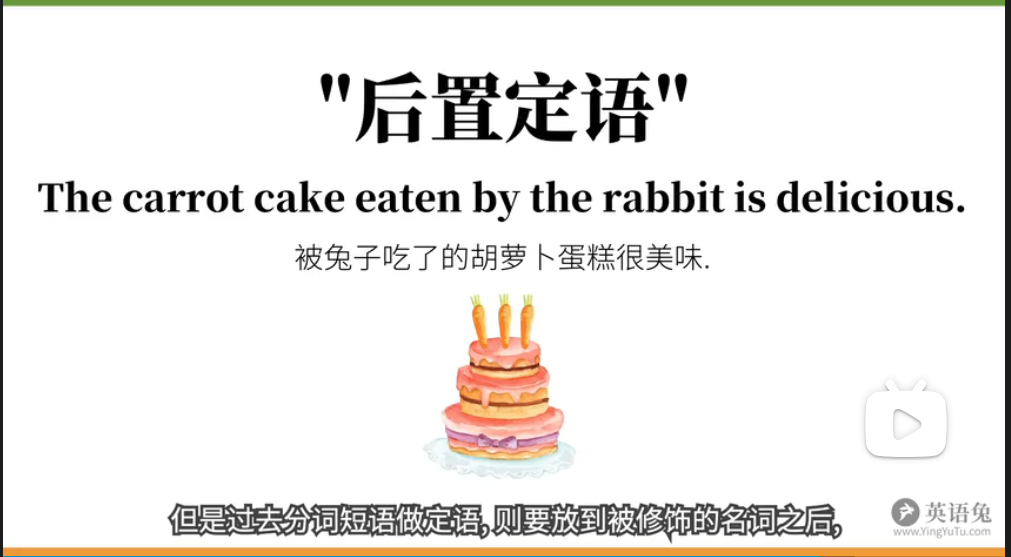
2.充当表语
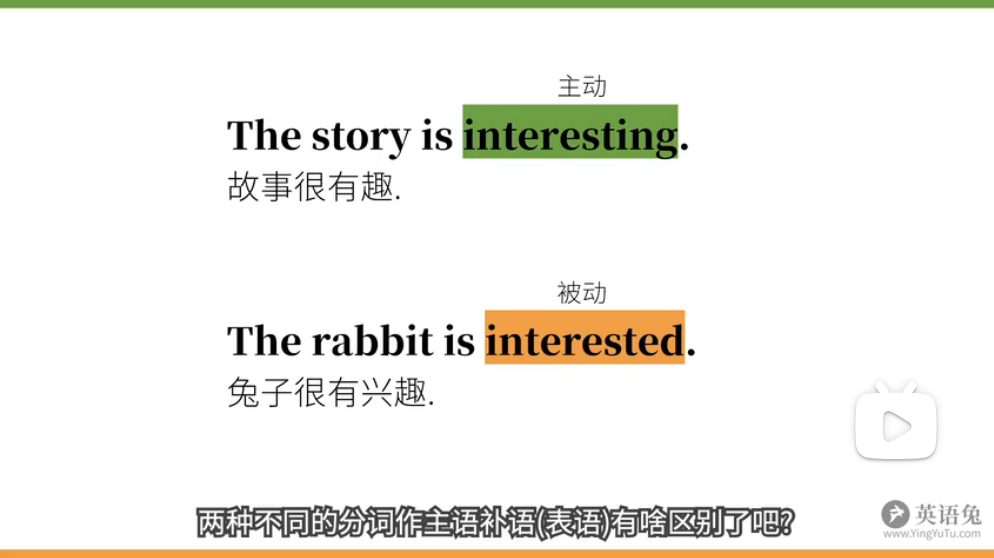
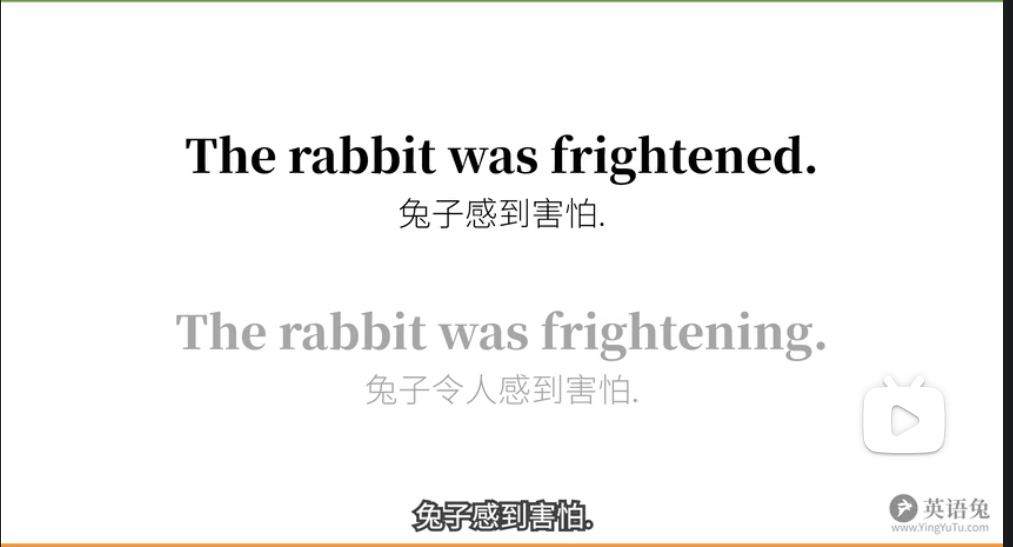
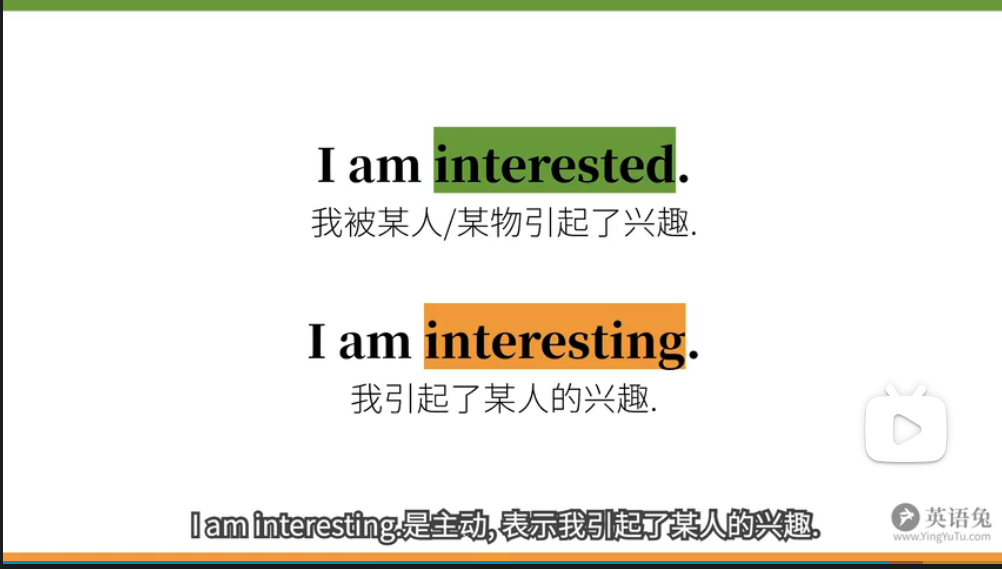
3.充当宾语补语
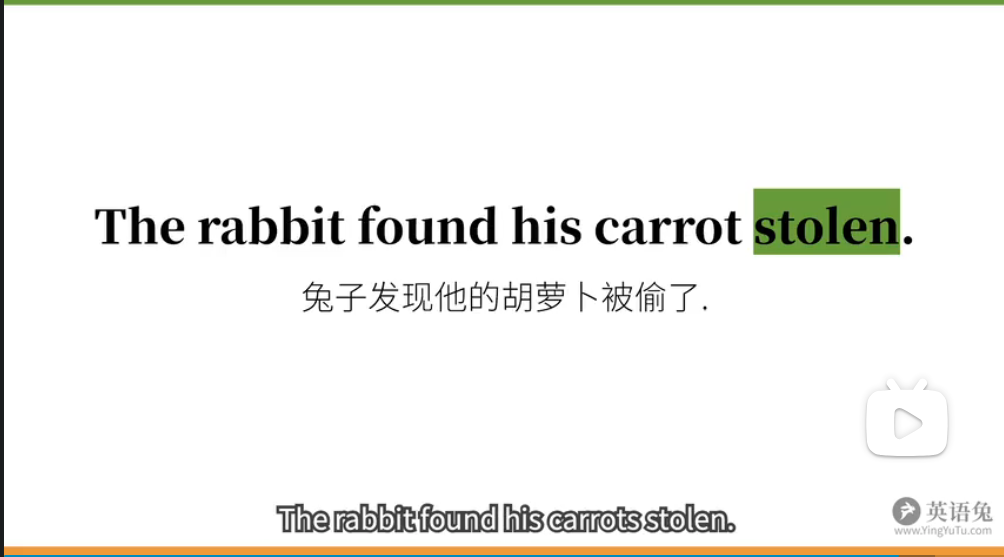
4.充当状语
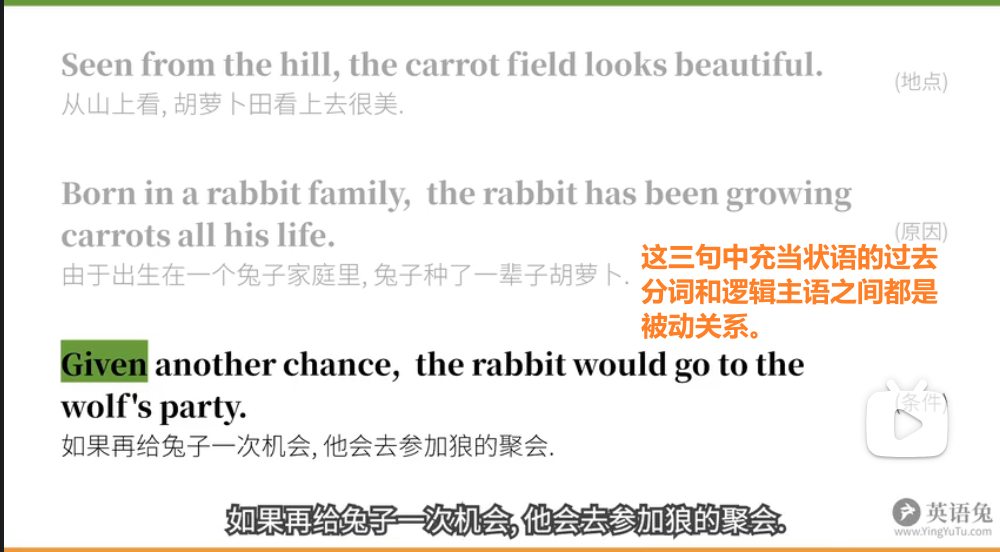

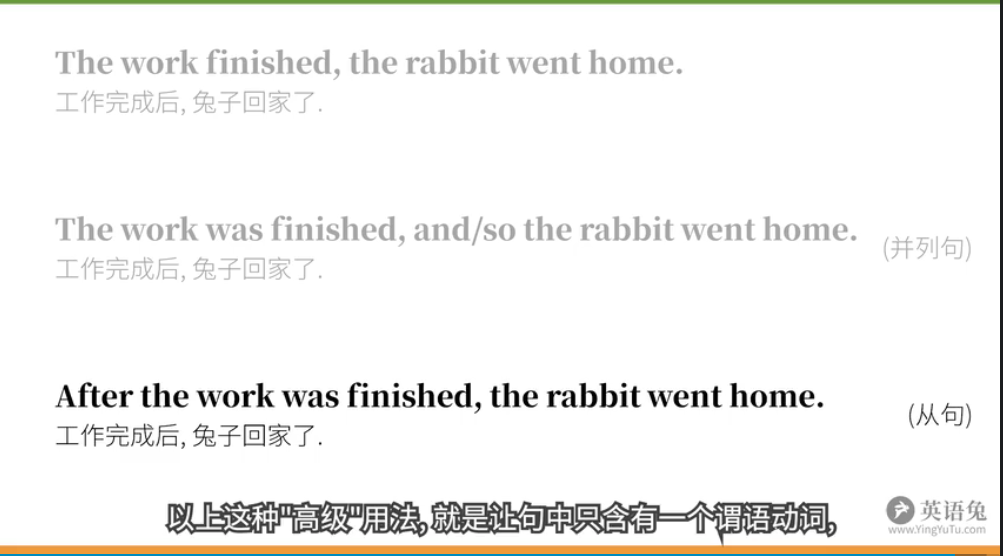
finished修饰the work
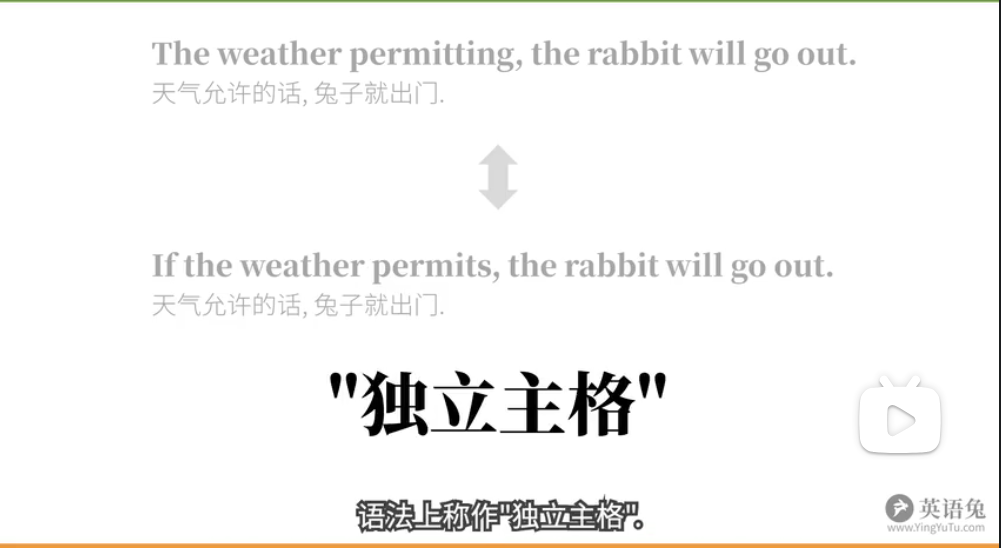
动词语气Verb Moods
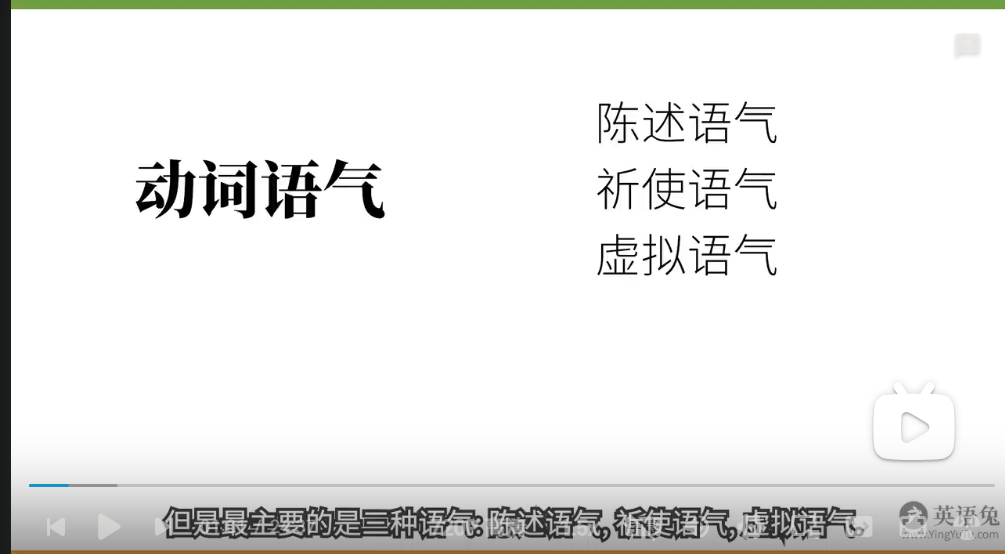
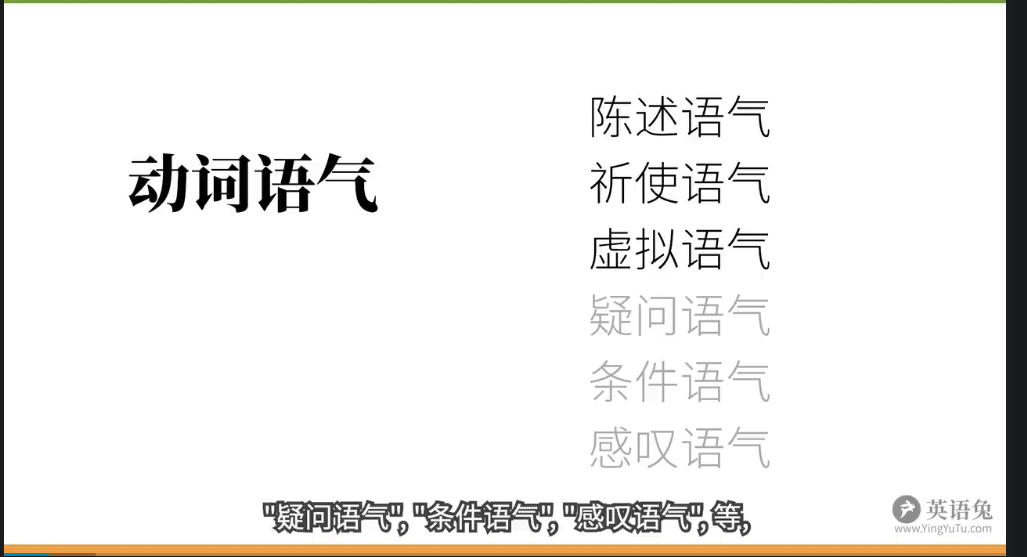
陈述语气Indicative Mood


祈使语气Imperative Mood
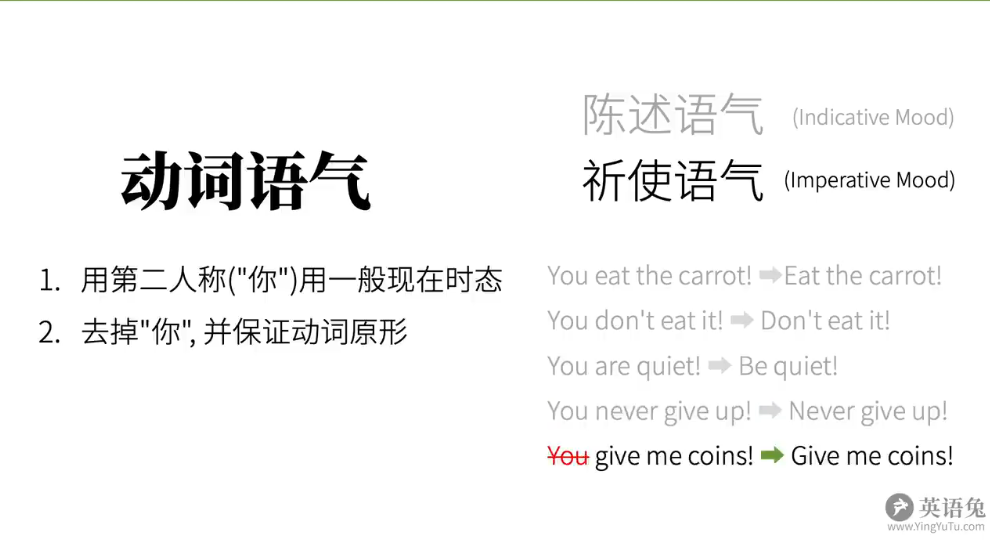
虚拟语气Subjunctive Mood
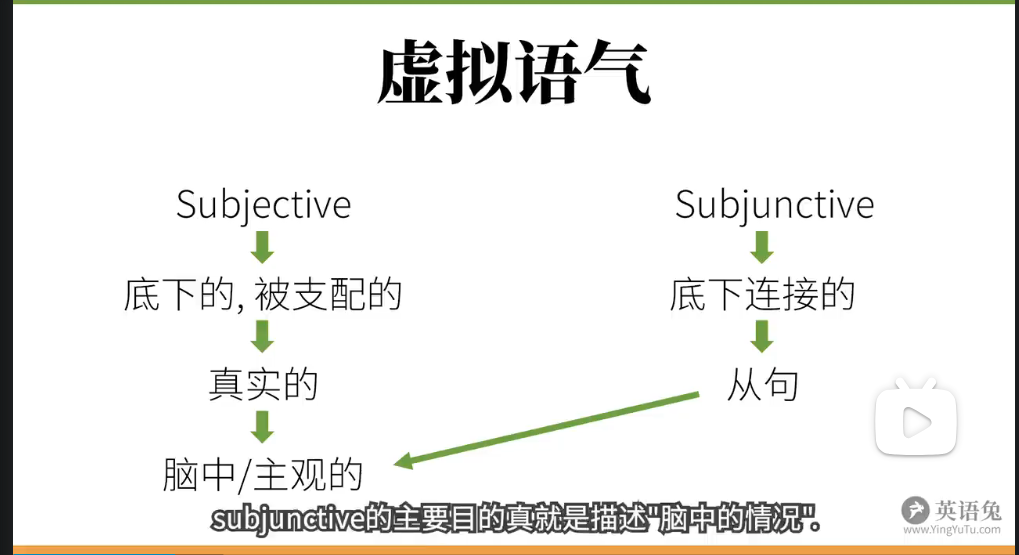


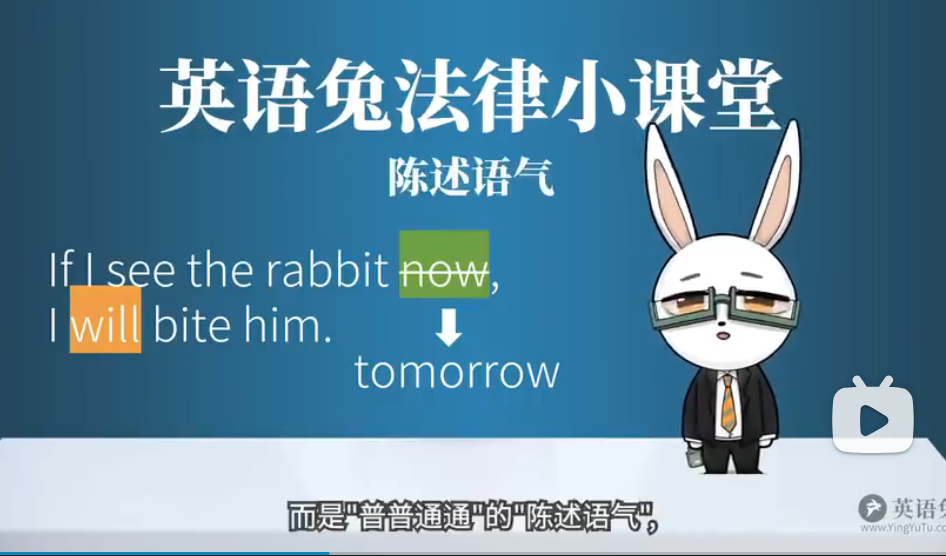

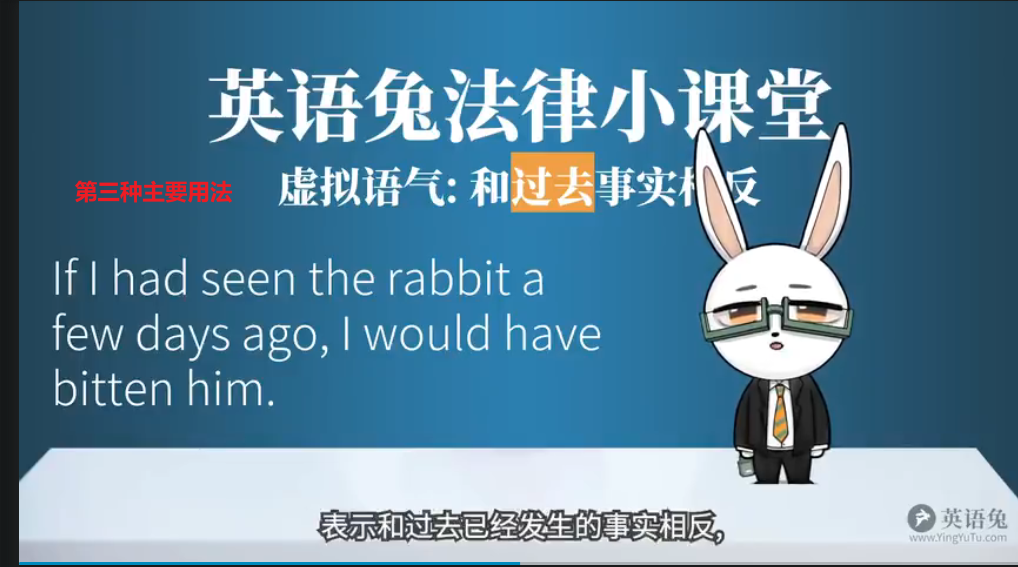
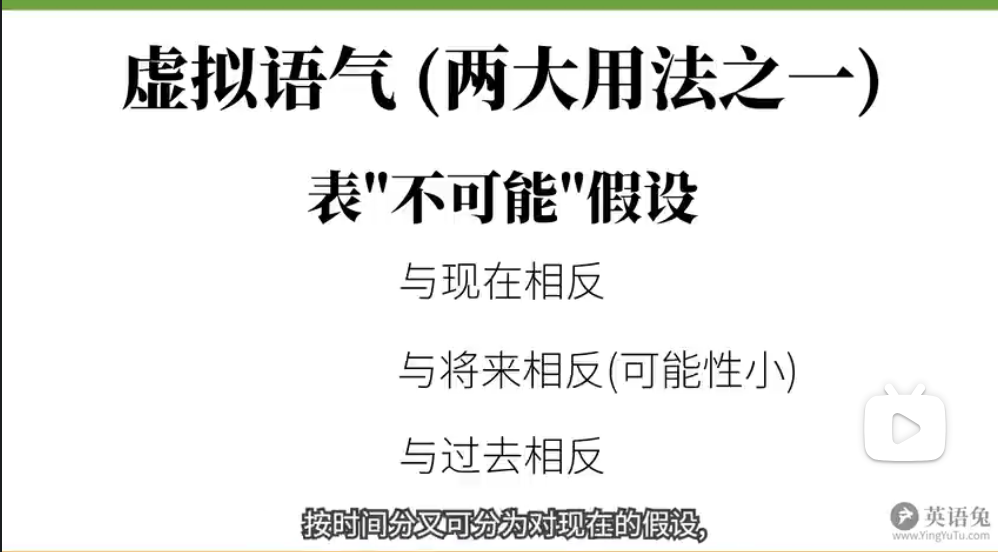


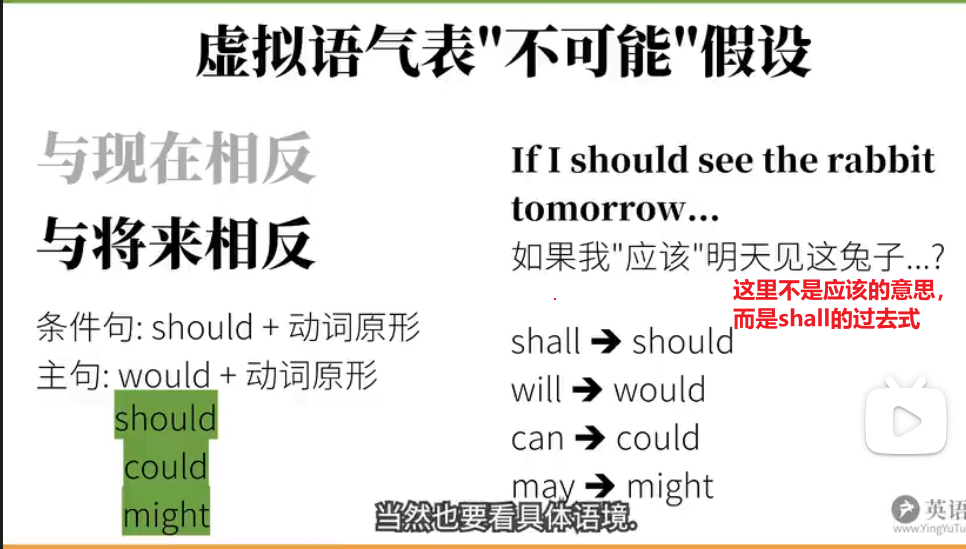
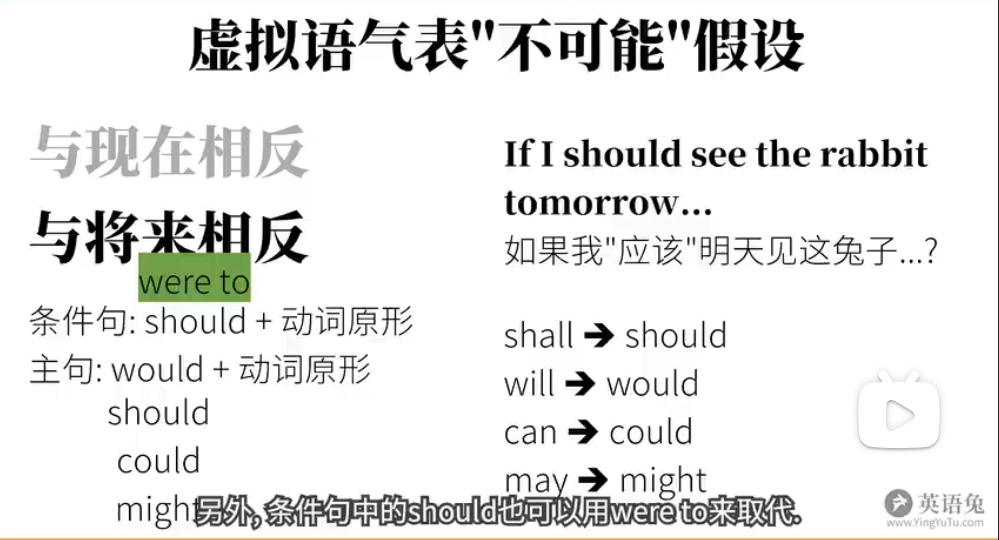
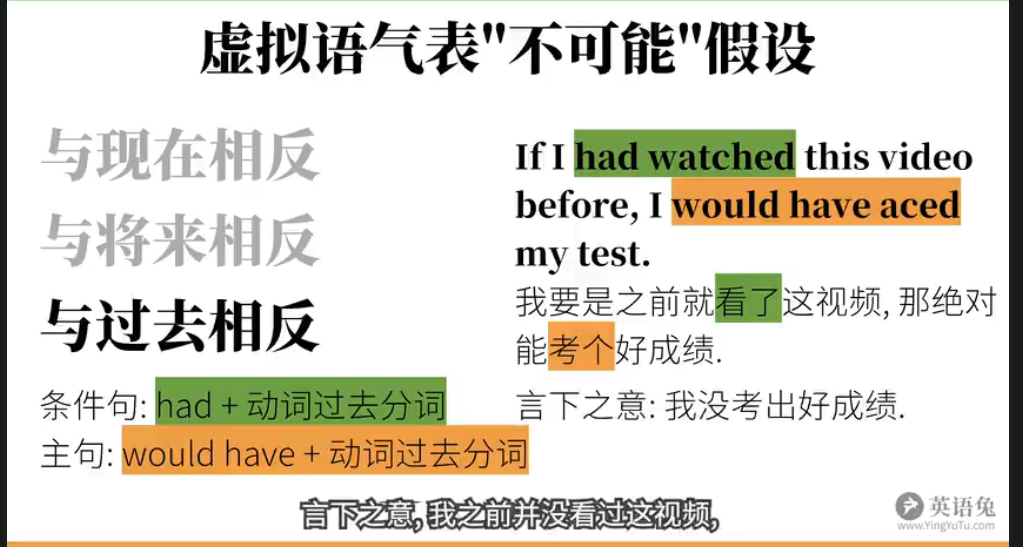

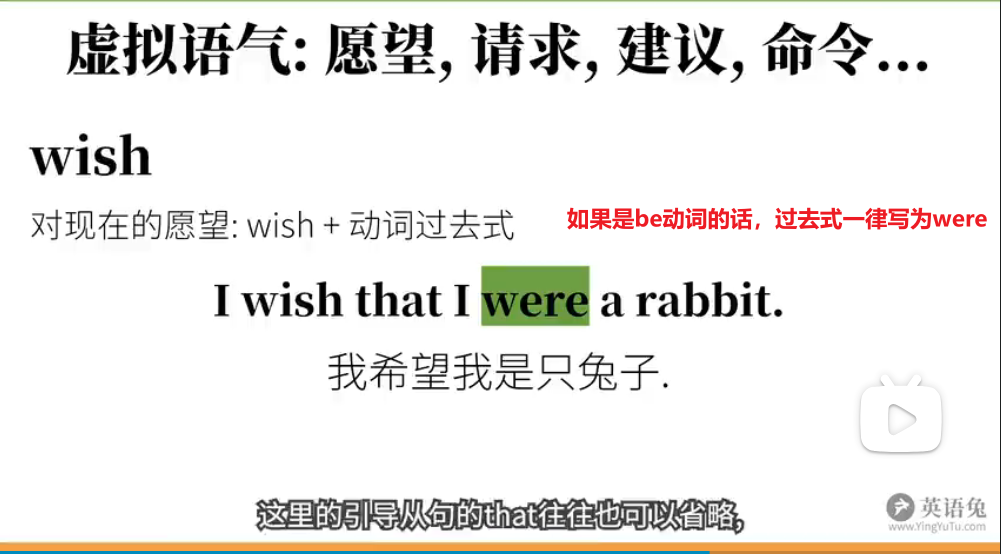
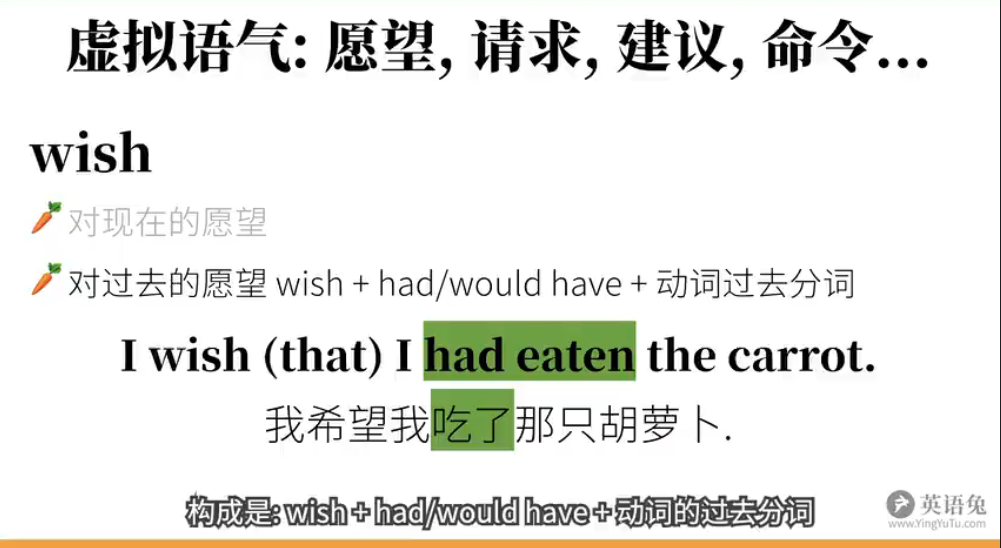


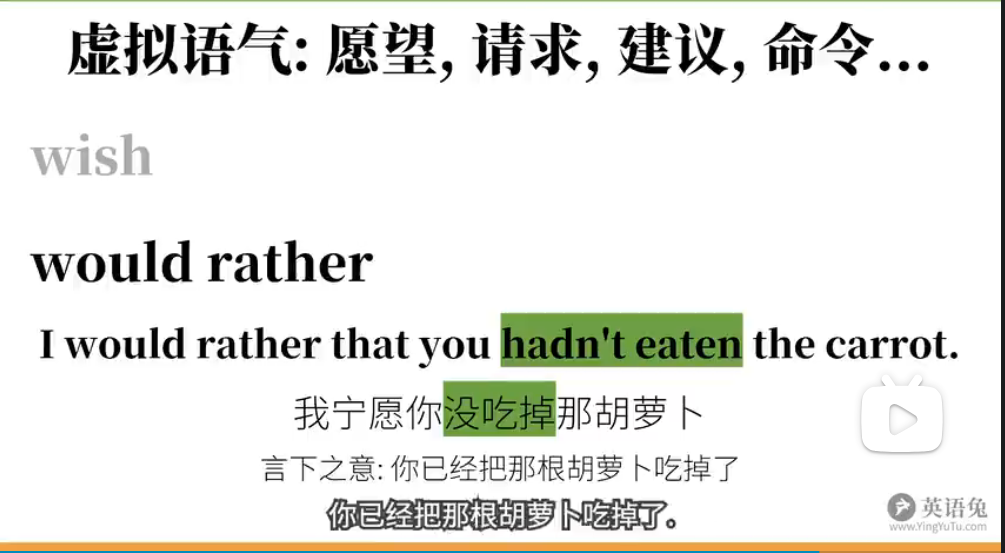
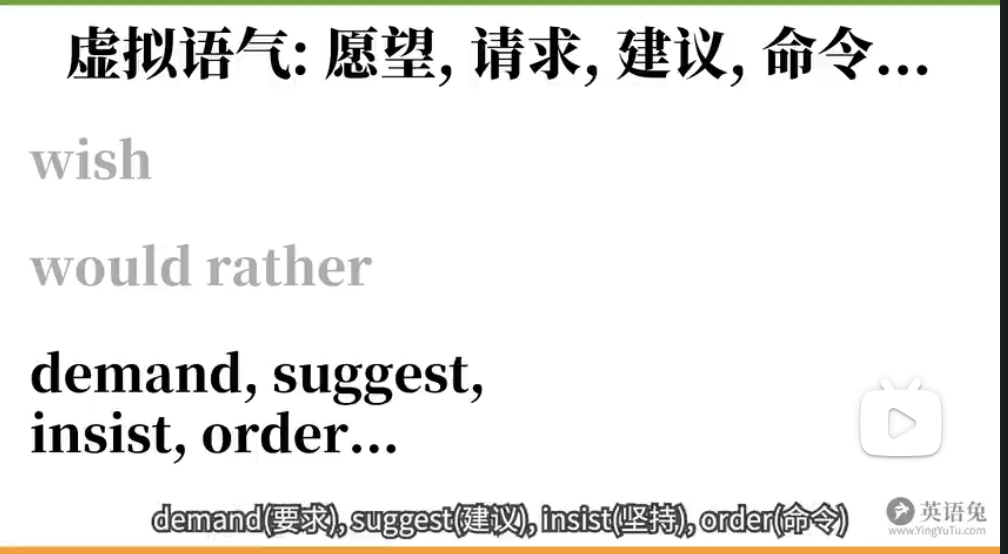
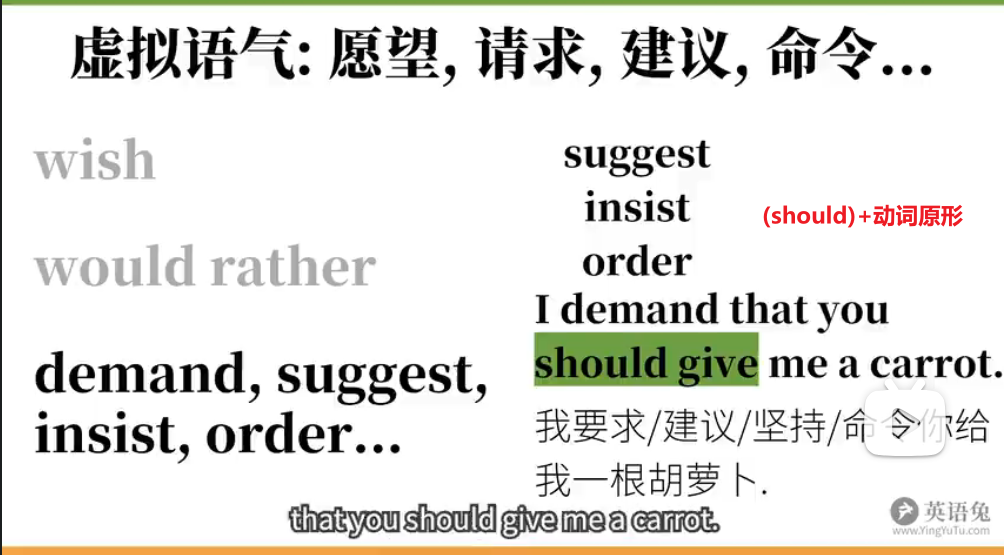


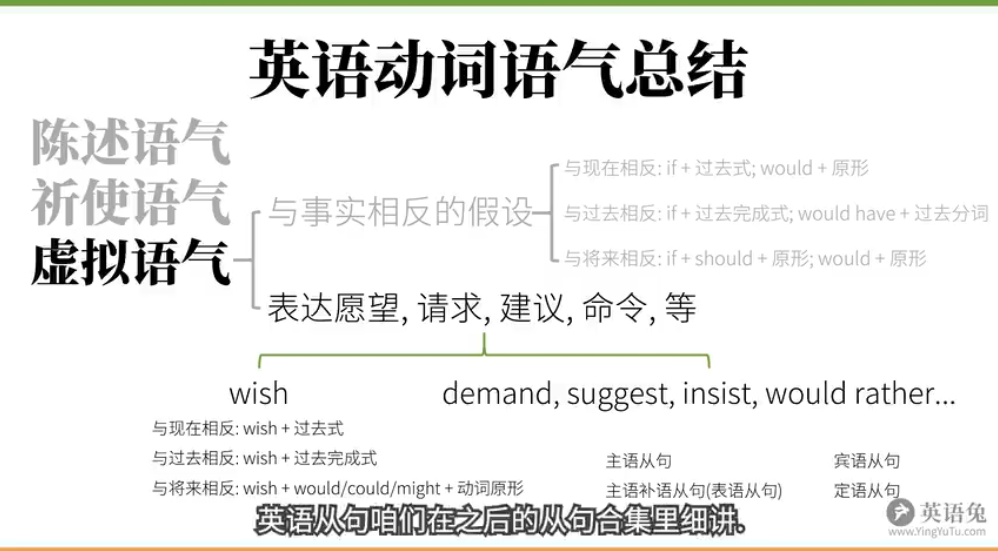
独立主格
概念
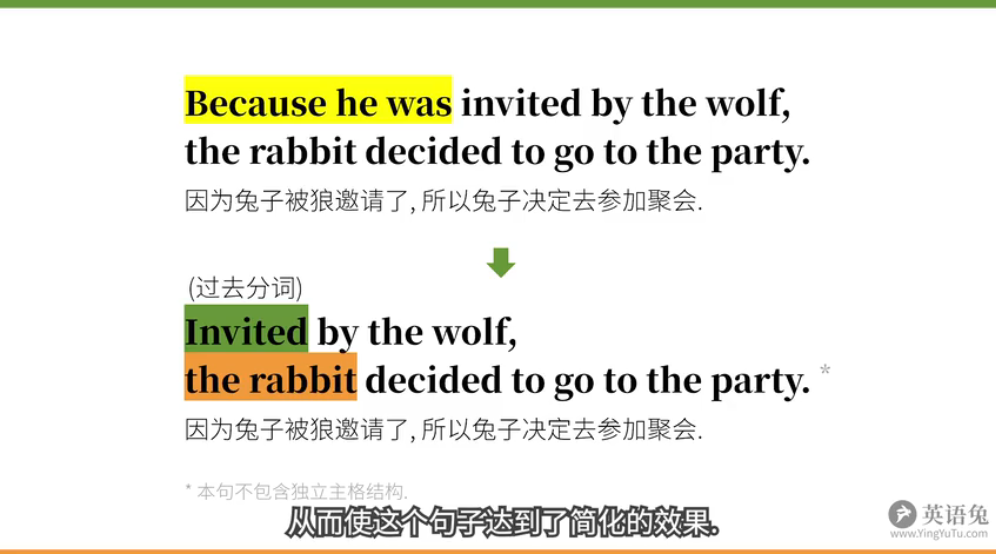

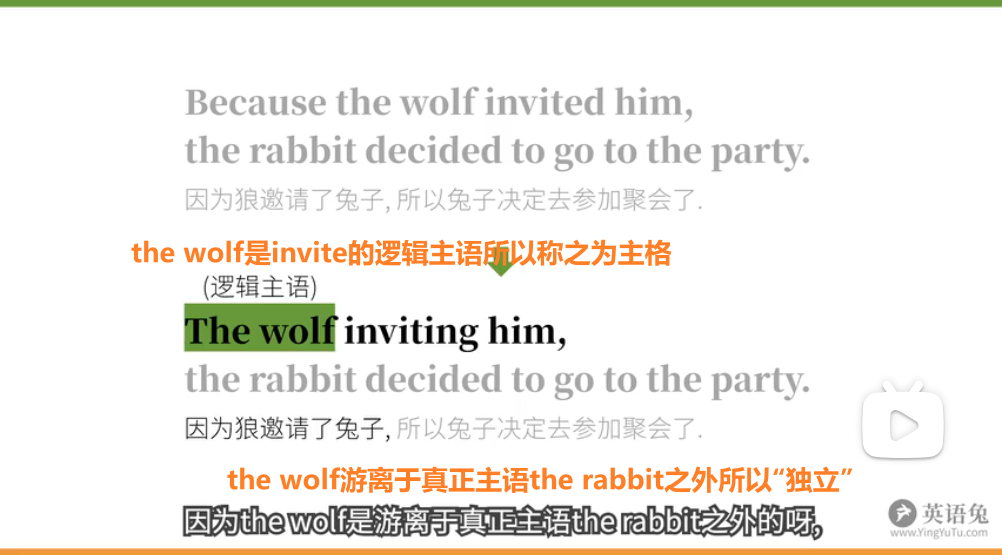
独立主格结构对从句的简化
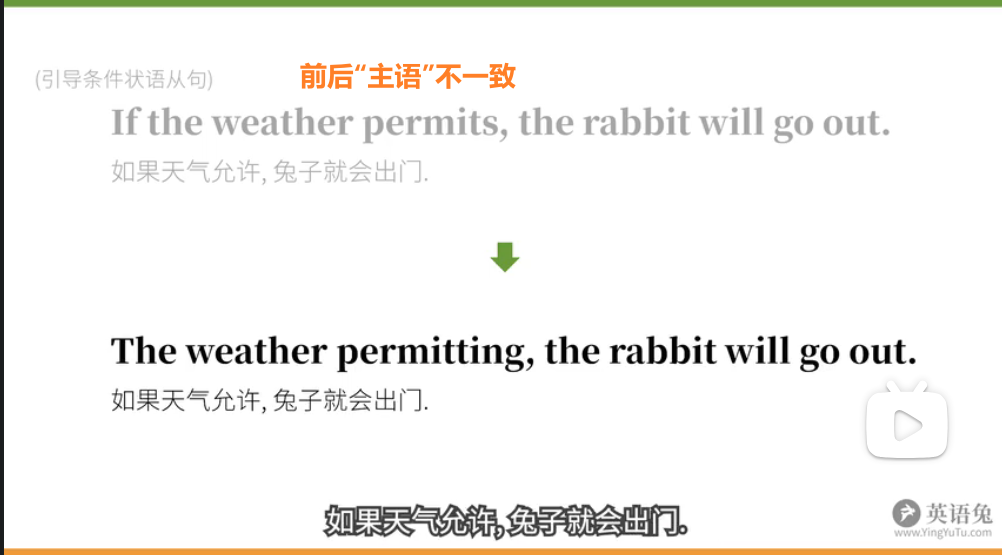
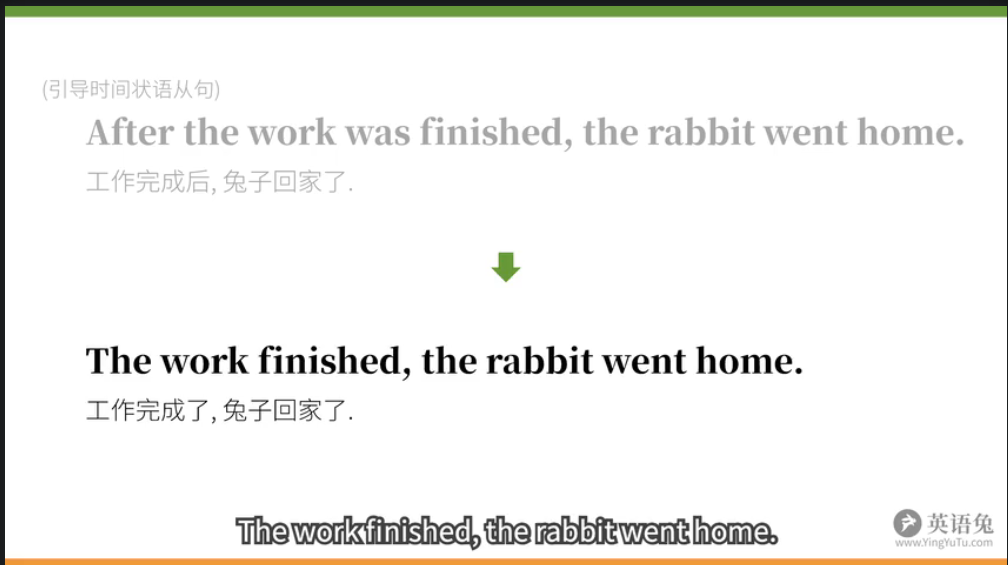
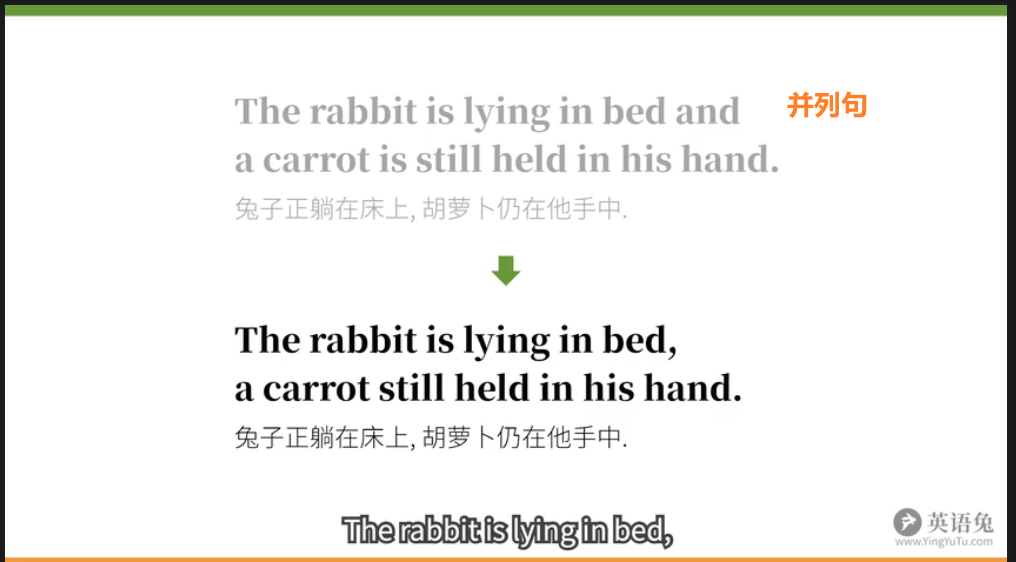
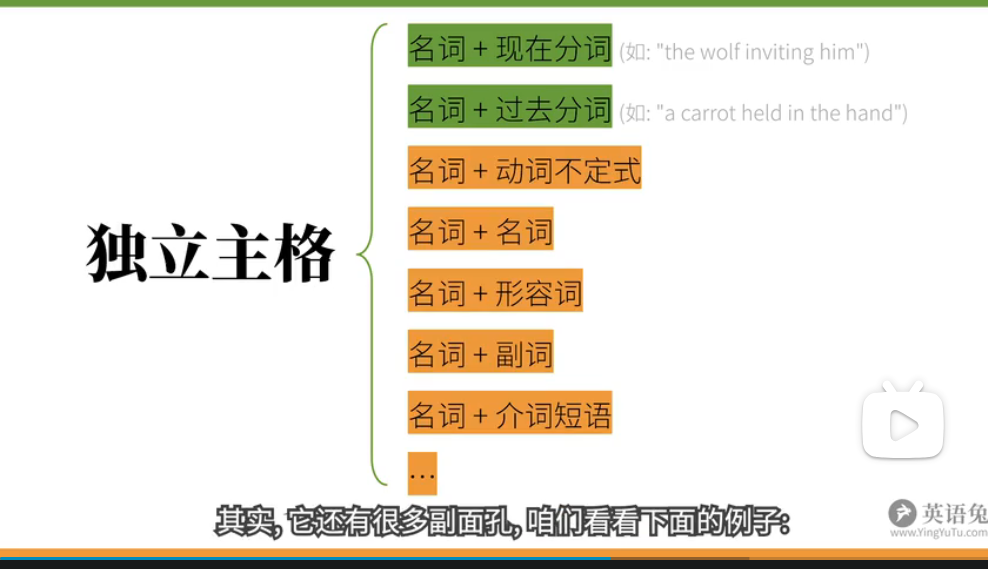
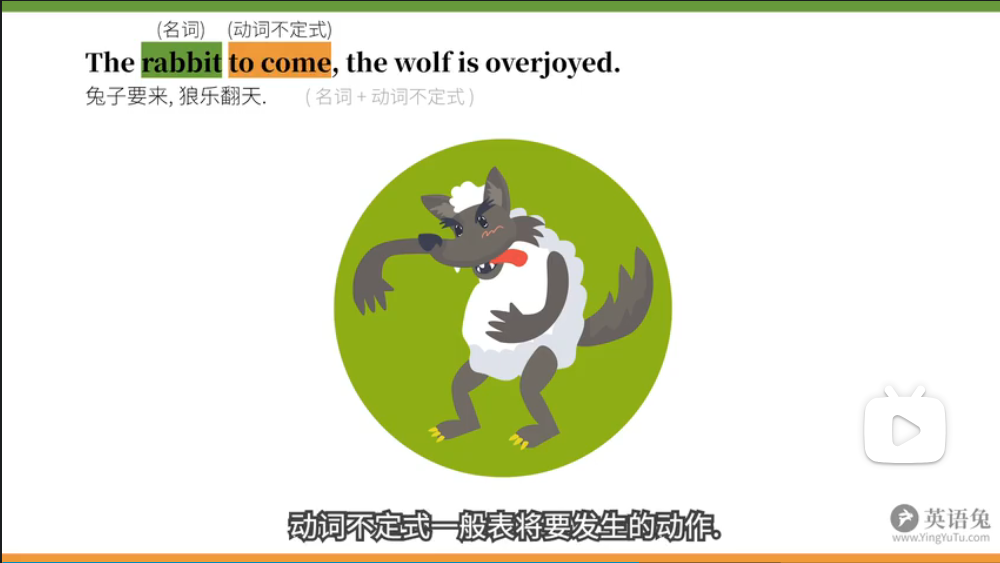
The rabbit to come, the wolf is overjoyed.


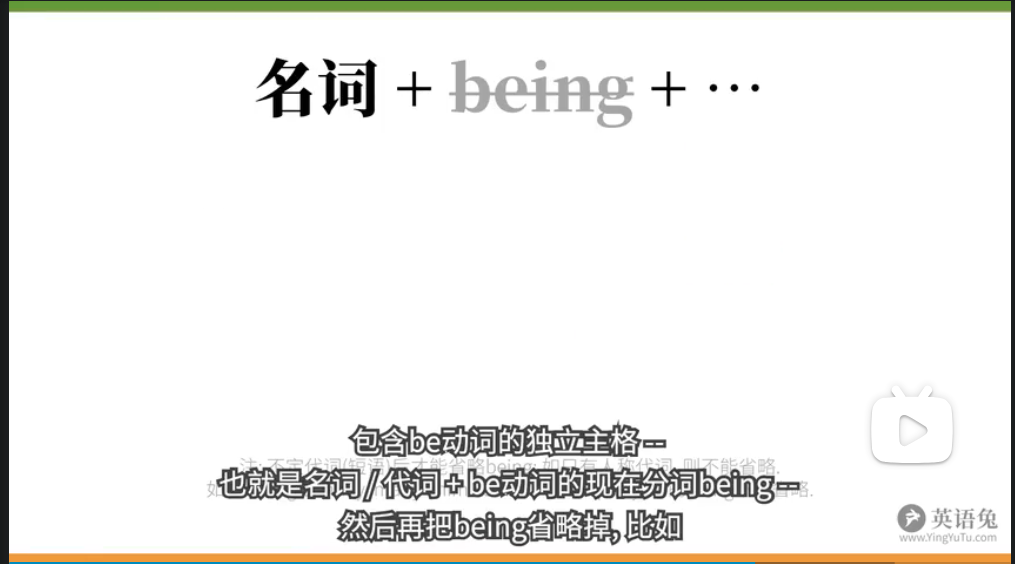

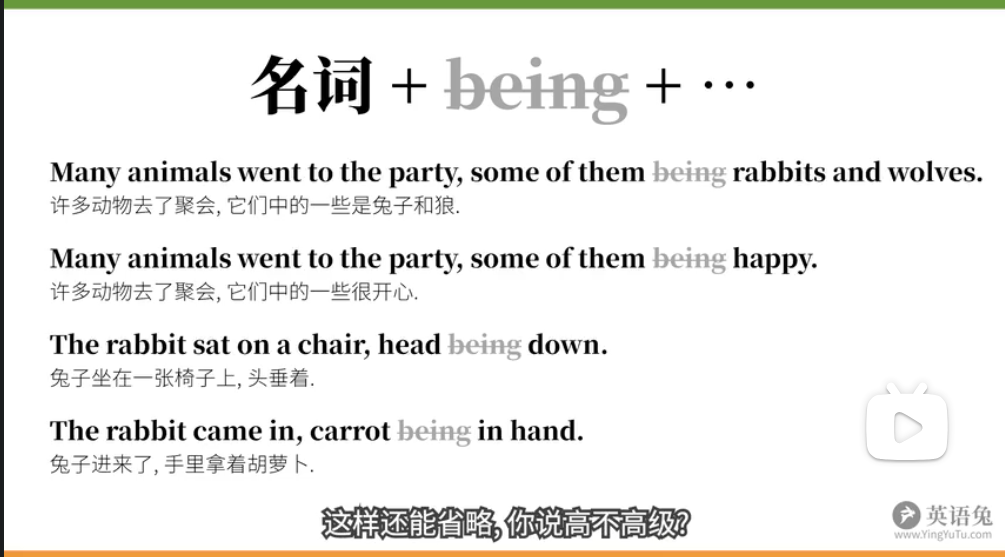
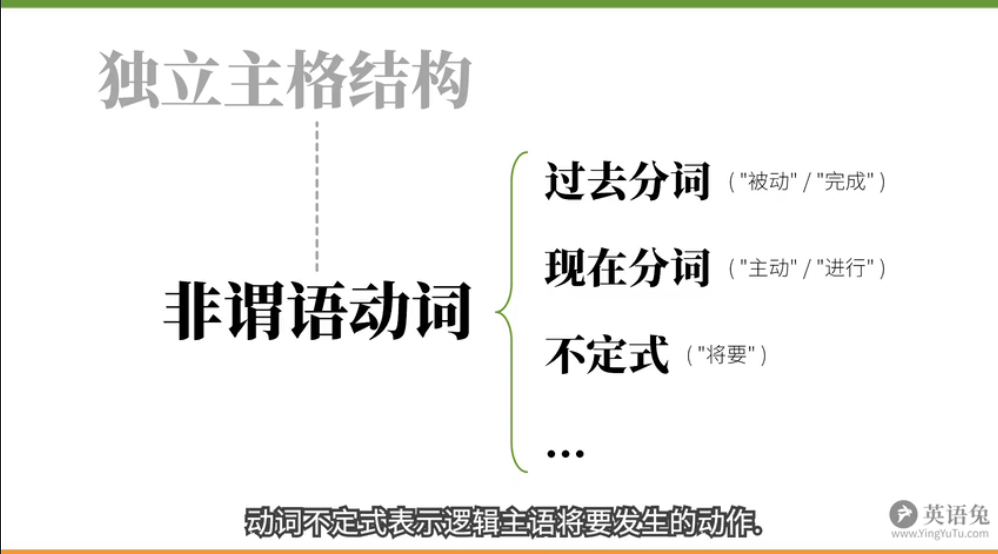

with+宾语+宾补
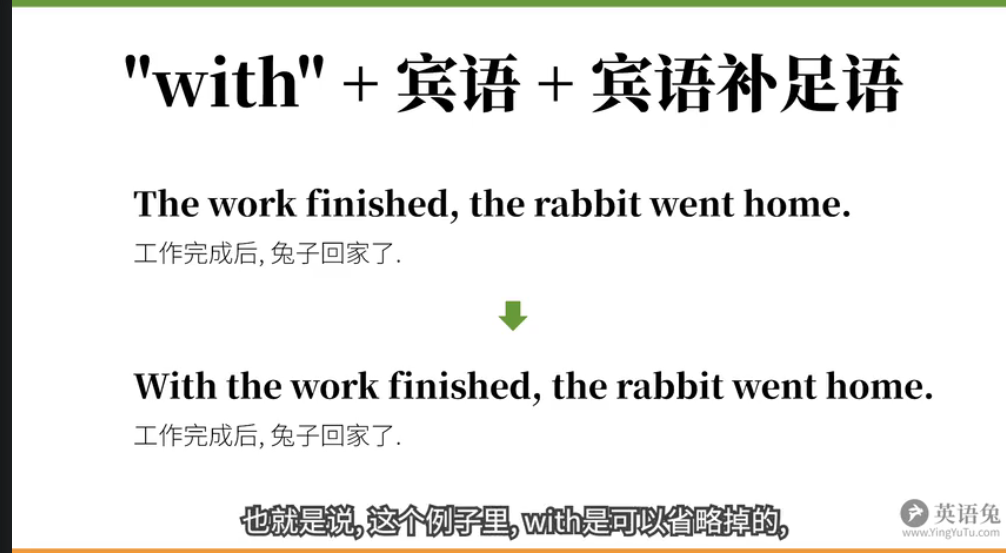
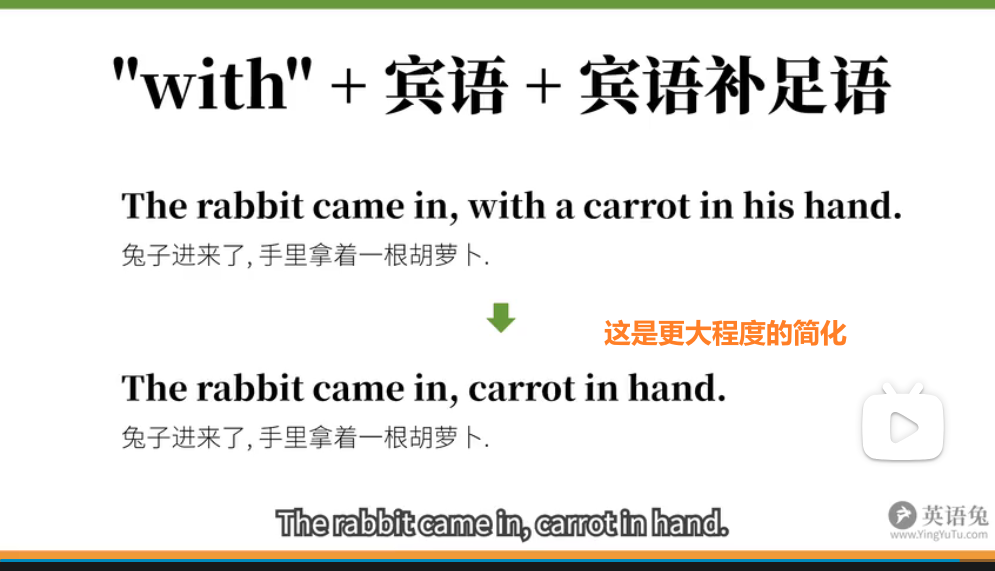
大学英语词汇解析
- 课程概述
- 授课目标
- 课程大纲
- Week 1 Introduction + Unit 1 Part 1
- Week 2 Unit 1 Part 2
- Week 3 Unit 2 Part 1
- Week 4 Unit 2 Part 2
- Week 5 Unit 3 Part 1
- Week 6 Unit 3 Part 2
- Week 7 Unit 4 Part 1
- Week 8 Unit 4 Part 2
- Week 9 Unit 5 Part 1
- Week 10 Unit 5 Part 2
- Week 11 Unit 6 Part 1
- Week 12 Unit 6 Part 2
- Week 13 Unit 7 Part 1
- Week 14 Unit 7 Part 2
- Week 15 Unit 8 Part 1
- Week 16 Unit 8 Part 2
课程概述
本课程与各高校大学英语课堂教学《综合英语》课程并行,以《综合英语》中出现的重难点词汇短语为线索来组织课程内容。针对学生英语词汇学习的困难,例如记忆时效短、使用中容易出错、一词多义时无法确定词义的选择、记单词太枯燥、太难于坚持等等困难,本课程从每单元精选重难点词汇短语,以此为纲,从语义学、构词学、语言学、跨文化交际等方方面面来讲解词汇,使学生在探究英语词汇短语奥妙的过程中,切实理解单词的意义,了解单词的文化内涵,把握单词的运用场景,掌握单词的记忆方法,真正提高学习者学习英语的兴趣,以期达到学生自觉学习和可持续学习的目的。
对教材中词汇的精细剖析可供学生在课前深入学习相关单元的重点词汇,在这一基础上,学生可进一步通过在课上积极参与需要灵活运用相关词汇的互动式语言任务来吸收内化相关知识,课后再次复习所学所用词汇并完成相关课外语言实践任务。通过这三者,即慕课、课堂教学以及课外语言实践活动的有机结合,可帮助学生扩大词汇的广度和深度,加强词汇在书面表达和口头表达中的运用能力以及整体语言表达能力。同时,通过这一循环往复、环环相扣的教学模式/学习方法,线上线下的生生、师生交流,学生可获得更好的体验式的英语学习氛围和环境。
授课目标
本课程精选大学英语重难点词汇短语,从语义学、构词学、语言学、跨文化交际等方面来讲解词汇,帮助学生切实理解单词的意义、了解单词的文化内涵、把握单词的运用场景、掌握单词的记忆方法,真正提高学习者学习英语的兴趣,以期达到学生自觉学习和可持续学习的目的。
课程大纲
Week 1 Introduction + Unit 1 Part 1
0.1 Introduction: 课程导入 ——词汇学习策略(1)
0.2 Introduction: 课程导入 ——词汇学习策略(2)
0.3 Introduction: 课程导入 ——词汇学习策略(3)
1.1 picnic: 字母C和G的发音
1.2 schedule:美式英语和英式英语:湿猴理论
1.3 happy:词义的复位:词义放大与缩小
1.4 low: 原始意义与派生意义,中心意义与引申意义,拟声词:词义理据之一
Week 2 Unit 1 Part 2
1.5 scale: 义项分析:意义的辐射与链式发展
1.6 fill: 宗教角度理解单词:ergative verbs
1.7 overdue 词汇意义与词缀意义的关系,单词意义与其汉语对应词的关系
1.8 balance:单词中心意义的提取,各种意义之间的关系
1.9 weed: 多义性与义项分析,词类转换:名词转动词
1.10 sharp: 多义性与意义的发展--eleventh hour
1.11 household:合成词的构成(compounding)
Week 3 Unit 2 Part 1
2.1 plain: 单词中心意义提取及多词义发展
2.2 slender: 单词意义的颜色:褒义词和贬义词
2.3 historic: -ic与-ical的意义区别
2.4 but: 双重否定的理解,意群的划分
2.5 forge/coin:词义区别与新词构成--混成法(blending)
2.6 live free: 补足语与状语
2.7 iron: 特殊读音与语场(wok)
2.8 decade: 数字前缀(1-6)
Week 4 Unit 2 Part 2
2.9 数字前缀7-10,100,1000,多:愚人节来历
2.10 head: 义项分析之head 多义关联网路图
2.11 spot: 中心意思及各种不同意义的获取
2.12 log:意义获取的理据以及文化差异对比喻喻体选择的影响
2.13 word: 词义辨析;本身名词与转动词后的动名词词义的区别
2.14 lot:词义获取的理据--抽签
2.15 compel: 词根词缀学习与拓展
Week 5 Unit 3 Part 1
3.1 lock: 中心意义提取与多义发展
3.2 suburb:词根词缀,词素变体,省力原则
3.3 miss: 称谓词的意义及用法,女权运动对语言的影响
3.4 replace:前缀re-的多义性与词义本身的多义变化
3.5 announce: 前缀拓展pro-, de-, re-
Week 6 Unit 3 Part 2
3.6 defend: 前缀拓展ob- of-
3.7 barricade, barrier, bar: 意义获取的基本理据 bar-棒
3.8 odd 意义的获取与关联,odds
3.9 surveillance: 逆成法构词 Laser--首字母法(PRC)
3.10 otherwise : 意义的放大 sympathetic,romance
Week 7 Unit 4 Part 1
4.1 imagination: -able, -tive的意义
4.2 sense:多义性与词义发展及联系
4.3 -ful, -less:后缀-ful, -less的意义,高语境文化与低语境文化
4.4 make both ends meet: 短语意义的理解与运用,有关“勉强度日”和“both”的成语
4.5 doubt and suspect: 单词真正含义的理解:英文定义(与其对应的汉语表达的关系)
Week 8 Unit 4 Part 2
4.6 retrospect: 词根-spect-及相关单词拓展
4.7 outlandish: 后缀-ish的意义,缓和语气的方式
4.8 if anything, if any: 常用词的特殊用法,意群和语感的概念
4.9 credit: 词根-cred-及相关单词拓展
4.10 not give a fig:词义理据: Adam and Eve‘s story
Week 9 Unit 5 Part 1
5.1 guardsman: 中缀介绍与拓展
5.2 her holds: 为什么船是女的?类比法获取单词意义
5.3 feature: 与汉语意义有差距的词,汉英词汇在是否及物方面的区别
5.4 take...for granted: 短语意义的理据,英语句子之短短长原则
5.5 on behalf of: 短语中of与所有格代词之间的关系
Week 10 Unit 5 Part 2
5.6 graduate:了解单词的真正含义
5.7 genuine: 单词意义的获取以及与同义词的比较
5.8 delicate: 隐含的单词中心意思
5.9 serve:一词多义与英语双关语pun的构成
5.10 than:比较句的完整结构与理解
Week 11 Unit 6 Part 1
6.1 mind: 与matter一词的对应意义,礼貌语言的格式
6.2 bare:各种意思,近义词辨析,表示“空”的多个单词的比较
6.3 count : 各种意思,句子三个层次的意义,presupposition (预命题)
6.4 stir:各种意义的发展及其用法
6.5 twilight:twilight词汇意义的获取,相关的短语及意义
Week 12 Unit 6 Part 2
6.6 loose and fast: fast的各种意思,breakfast, 合成词与短语
6.7 leafs--leaves:规定语言学与描述语言学
6.8 -er还是-or:后缀-er,-or的使用规则,诗歌中的押韵
6.9 wearily: wear的真正意义
6.10 acute and chronic:词形分析,单词拓展
Week 13 Unit 7 Part 1
7.1 ring: ring finger, ring a bell 等
7.2 twist: 各种意义和用法
7.3 tie: 常用词的特殊意义拓展
7.4 assemble: 多义与意义联系
7.5 betray:前缀be-的用法和意义,betray的意义和用法
Week 14 Unit 7 Part 2
7.6 subject:构词法规则——缩略法
7.7 freeze: 新意,读音:弹舌——各种奇怪的语音(英语的变体)
7.8 nail: 新意,连读There is a nail in it.
7.9 scratch: 与汉语不同的表达
7.10 put through: 以副词(介词)为主要词义的短语 ~ on, ~ through
Week 15 Unit 8 Part 1
8.1 abnormal:前缀ab-的意义,前缀ab-的单词拓展,词汇联想记忆法
8.2 evil:各种意义和用法,常见英语文字游戏
8.3 egg:各种意义和用法
8.4 line: 意义来源及发展
8.5 rear:一词多义,各义项之间的关系,相关短语辨析
Week 16 Unit 8 Part 2
8.6 wave:各种意义和用法
8.7 sweep:各种基本意义及引申意义
8.8 pass away:委婉语的意义与用法
8.9 定冠词和零冠词:定冠词、零冠词的意义和基本用法,理解记忆单词
8.10 加强词:形容词、名词作加强词,喻体的选择
Oral-English
Discussion Skills
- 1Giving Your Opinion and Asking for the Opinion of Others
- 2Supporting Your Ideas by Paraphrasing and Quoting Others
- 3Expressing Interest and Asking for Elaboration
- 4Asking for Clarification
- 5Agreeing and Disagreeing During a Discussion
- 6Expanding on Your Own Ideas
- 7Compromising and Reaching a Consensus
- 8Keeping the Discussion on Topic
来源:上海外语出版社《新目标英语听说2》
1Giving Your Opinion and Asking for the Opinion of Others
If you enjoy expressing your ideas, giving your opinion is something you will do regularly. Asking for opinions also constitutes an important part of our daily communication. You can get different perspectives or useful suggestions from others if you do it properly. Here are the most common ways to express and ask for opinions.
Offering Your Opinion
In my opinion / In my view...
Generally speaking, I think...
Personally, I haven’t the faintest idea about / whether...
To my mind...
I’d just like to say...
As far as I’m concerned...
I’m quite convinced that...
To be quite honest / frank...
Asking for the Opinion of Others
How do you feel about...?
What do you think of...?
What do you reckon?
What’s your opinion of...?
What are your views on...?
What would you say to... / if we...?
Where do you stand on...?
Examples:
To be honest, smart technologies have already made an impact on many professions, so we need to acquire relevant technical skills if we want to succeed in the workplace.
As far as I’m concerned, we must constantly adapt and innovate to ensure success for the world is changing so fast.
What are your views on starting a small business after graduation?
What do you think of the current unemployment rate?
2Supporting Your Ideas by Paraphrasing and Quoting Others
In a discussion, a speaker will sometimes support his or her ideas by giving, or citing the source of a piece of information. This is usually done by paraphrasing or quoting another person, such as an expert in the field. The following sentence patterns might be used to signal that a speaker is using someone else’s words or ideas to support his or her ideas in the discussion.
Paraphrasing (not exact words)
(source) states / says / suggests / argues / believes that ...
In (title), (source) says / states / suggests / argues that ...
According to (source), ...
To paraphrase (source), ...
Quoting (exact words)
(source) was quoted as saying “...”
(source) said, “...”
In the words of (source), “...”
To quote (source), “...”
This is what (source) calls “...”
Examples:
William James says that the greatest weapon against stress is our ability to choose one thought over another.
A Chinese old saying states that misfortune may be an actual blessing.
To quote Oprah Winfrey, “Breathe. Let go. And remind yourself that this very moment is the only one you know you have for sure.”
3Expressing Interest and Asking for Elaboration
The goal of a discussion is to explore a topic deeply by having participants share their ideas, opinions, and experiences related to the topic. You can show that you are listening to others by offering a response (rejoinder) that shows your feelings about the ideas being expressed. Also, an active participant will encourage others to elaborate on their ideas by asking follow-up questions. These can be general questions (such as who, what, when, how and why) or more detailed questions that specifically refer to what others have said. Follow-up questions help you learn more about other people’s ideas and experiences, and can keep a discussion going.
Interested
I see.
That’s nice.
Oh, yeah?/Yeah?
Uh-huh.
Surprised
You’re kidding!
Really?
No way!
Wow!
Follow-up question
Who …?
What …?
When …?
How …?
Why …?
Examples:
May I ask why you say that?
It sounds like an interesting sport! What is the rule for serving in Bossaball?
I see. But when did China roll out a national fitness plan?
4Asking for Clarification
Clarification is important in discussion especially when what is being communicated is difficult in some way. By asking for clarification, you aim to ensure that your understanding of what the speaker has said is correct and to reassure the speaker that you are genuinely interested in what he or she is trying to say.
You may use the following ways to ask for clarification:
Asking for Repetition
- Would you mind repeating that for me?
- Would you mind going over that one more time?
- Sorry, could I ask you to tell me that…again?
- Could you clarify what you meant by…?
- Could you be more specific?
- I don’t think I got your meaning. Could you go over that again?
- I don’t think I quite understand what you meant. Would you mind repeating that?
Repeating and Restating the Other Person’s Idea
- Let me see if I understood correctly.
- I’d just like to confirm that I got that right.
- So what you are saying is...Does that sound right?
- If I understand you correctly, you are saying...
- You mean...?
- I think you are saying...
- In other words, ...
Responding
- Thanks for clarifying. I understand better now.
- Thank you for repeating that. It makes more sense to me.
- Thanks. We seem to be on the same page now.
- I appreciate the clarification. Glad we agree on that.
- Sorry, I still don’t understand.
- I’m sorry, but could you explain that one more time?
5Agreeing and Disagreeing During a Discussion
Joining discussions is an important part of daily communication. You can contribute to a discussion by agreeing and disagreeing. It is important to learn how to disagree effectively. When you are trying to disapprove of another speaker’s point, you want to do it in a polite and constructive way. That is to say, you should acknowledge the other speaker’s points and ideas before explaining why and how you disagree. Common expressions used to show agreement and disagreement are as follows:
To agree with others
You are right.
I agree with you because…
That’s just what I was thinking.
That’s a good point.
You can say that again.
So / Neither do I.
I think so too.
I’d go along with that
Exactly!
I couldn’t agree more.
I was just going to say that.
You have a point there.
Yes, me too / me neither.
I’m with you.
I share your view.
To disagree with others
I agree with you to some extent / up to a point, but…
I am sorry (to disagree), but…
I see what you mean, but…
I can see your point, however…
That’s a good point, but…
I see what you’re getting at / where you’re coming from, but…
You might be right, but…
I’m afraid I don’t see it that way.
I’m not sure if I would go along with…
That’s not always the case because…
That’s not necessarily true because…
That doesn’t make much sense to me.
Well, I’m not so sure about that.
Yes, but don’t you think...?
I think what he/she may actually be suggesting is…
Examples:
Well, that’s true. But it can be dangerous to judge your relationship against romantic ideals.
I have to side with Tony on this one. Long distance relationships are never going to work out.
I understand where you are coming from, but one-sided love is real and selfless. You get happy when that person is happy even though you aren’t included in his or her happiness.
There is some truth to what you’re saying, but don’t you think that beauty is in the eye of the beholder?
6Expanding on Your Own Ideas
Sometimes during a group or class discussion, you want to add more details or information to something you have already said. The following are some phrases to help you to go back to your original idea and expand on it.
What I meant before was ...
I’d like to go back to what I was saying earlier ...
Let me add something to what I said before ...
What I was trying to say was ...
About my earlier point ...
About what I said earlier ...
I’d like to take my earlier point a step further ...
Examples:
What I meant before was giving often created a ripple effect. That’s to say, my simple behaviour brightens their day and the warmth will be spread.
I’d like to go back to what I was saying earlier. Money can’t buy happiness.
Let me add something to what I said before. I want my money to be used in the right place. Therefore, to figure out how, I use my brain to figure out which charitable organizations are trustworthy.
What I was trying to say was when you borrow something from someone, you should take good care of it.
About my earlier point, I didn’t mean we should not donate money. What I meant was taking part in voluntary activities was also philanthropic behaviour.
7Compromising and Reaching a Consensus
To compromise is to make a deal between different parties where each party gives up part of their demand. In arguments, compromise is a concept of finding agreement through communication. Consensus is a general agreement. It is used to describe both the decision and the process of reaching a decision. The idea of it is based on the reality of overlapping interests. It often involves variations from an original goal or desire. Through compromising and reaching a consensus, we stop trying to get people to agree about stuff they do not agree about. We can instead focus on finding agreement to solve problems. You may find the following expressions useful:
Asking for opinions
What’s your take on this?
What’s your view?
Do you have any views on…?
Softening your own opinion
I may be wrong, but…
I’m no expert, but…
I don’t know about you, but…
Disagreeing
I can’t say for certain that…
Maybe it’s just me, but…How about (verb + ing…)?
I’m not so sure.
Do you really want…?
Can you seriously picture…?
I see your point, however, don’t you
think that…
I understand what you’re saying, but…
Imagine for a moment that you are…
Try to see it from my point of view.
Reframing the disagreement
So here is the real question:…?
We could look at this from a different perspective.
I think one way of looking at that is to…
Setting conditions
I’ll agree to your…, so long as…
I’m ready to agree if you can…
I would be willing to…, provided that…
The bottom line is that…
Proposing a solution
We propose that…
So why don’t we…?
I’d like to suggest that we…
Can we resolve this by…?
If I agree, would you be willing to…?
Signalling agreement
Right.
I’m with you.
I agree that…
I think you are right about…
That sounds great to us.
I can go with that.
Examples:
Do you have any views on the effects of globalization?
I am no expert, but I think localization itself is neither good nor bad.
Imagine for a moment that you are a worker for a car company in an industrialized country and one day you lose your job because the entire factory is moved to another country.
The bottom line is that we can’t raise both salaries and bonuses.
Can we resolve this by agreeing that there is a link between globalization and cultural identity of people?
8Keeping the Discussion on Topic
During a discussion, people sometimes get off the topic, bringing up ideas that aren’t related to the discussion topic. In this situation, other people could make an effort to bring the discussion back to the original topic in a polite way.
The following are some expressions for bringing a discussion back on topic and keeping a discussion focused.
That’s interesting, but it raises a different point. Could we come back to that later?
Maybe we could talk about that later, but for now ...
That’s a good point, but ...
Let’s stay focused.
Can we go back to ...?
Maybe we should get back to the question.
I think maybe we’re getting off track / getting off the topic (subject).
Let’s get back to ...
Examples:
That’s a very good point, but our topic is language diversity. We could talk about how to learn English when the present one is finished.
Let’s stay focused everybody. Please put aside the way the Indians eat and focus on traditional dress around the world.
Can we go back to the Chinese ethnic minorities? Maybe when we finish talking about this, if time permits, we will talk about Chinese dialects.
Yes, it is undeniable that kilts are Scotland’s tradition dress. Maybe we should get back to the question of the tribes in Africa.
I think maybe we are getting off track. You know our topic is the indigenous people in the Arctic region, not the winter vacation plan.
Famous English Speeches
The Gettysburg Address
Gettysburg, Pennsylvania
November 19, 1863
On June 1, 1865, Senator Charles Sumner referred to the most famous speech ever given by President Abraham Lincoln. In his eulogy on the slain president, he called the Gettysburg Address a "monumental act." He said Lincoln was mistaken that "the world will little note, nor long remember what we say here." Rather, the Bostonian remarked, "The world noted at once what he said, and will never cease to remember it. The battle itself was less important than the speech."
There are five known copies of the speech in Lincoln's handwriting, each with a slightly different text, and named for the people who first received them: Nicolay, Hay, Everett, Bancroft and Bliss. Two copies apparently were written before delivering the speech, one of which probably was the reading copy. The remaining ones were produced months later for soldier benefit events. Despite widely-circulated stories to the contrary, the president did not dash off a copy aboard a train to Gettysburg. Lincoln carefully prepared his major speeches in advance; his steady, even script in every manuscript is consistent with a firm writing surface, not the notoriously bumpy Civil War-era trains. Additional versions of the speech appeared in newspapers of the era, feeding modern-day confusion about the authoritative text.
Bliss Copy
Ever since Lincoln wrote it in 1864, this version has been the most often reproduced, notably on the walls of the Lincoln Memorial in Washington. It is named after Colonel Alexander Bliss, stepson of historian George Bancroft. Bancroft asked President Lincoln for a copy to use as a fundraiser for soldiers (see "Bancroft Copy" below). However, because Lincoln wrote on both sides of the paper, the speech could not be reprinted, so Lincoln made another copy at Bliss's request. It is the last known copy written by Lincoln and the only one signed and dated by him. Today it is on display at the Lincoln Room of the White House.
Four score and seven years ago our fathers brought forth on this continent, a new nation, conceived in Liberty, and dedicated to the proposition that all men are created equal.
Now we are engaged in a great civil war, testing whether that nation, or any nation so conceived and so dedicated, can long endure. We are met on a great battle-field of that war. We have come to dedicate a portion of that field, as a final resting place for those who here gave their lives that that nation might live. It is altogether fitting and proper that we should do this.
But, in a larger sense, we can not dedicate -- we can not consecrate -- we can not hallow -- this ground. The brave men, living and dead, who struggled here, have consecrated it, far above our poor power to add or detract. The world will little note, nor long remember what we say here, but it can never forget what they did here. It is for us the living, rather, to be dedicated here to the unfinished work which they who fought here have thus far so nobly advanced. It is rather for us to be here dedicated to the great task remaining before us -- that from these honored dead we take increased devotion to that cause for which they gave the last full measure of devotion -- that we here highly resolve that these dead shall not have died in vain -- that this nation, under God, shall have a new birth of freedom -- and that government of the people, by the people, for the people, shall not perish from the earth.
Abraham Lincoln
November 19, 1863
Nicolay Copy
Named for John G. Nicolay, President Lincoln's personal secretary, this is considered the "first draft" of the speech, begun in Washington on White house stationery. The second page is writen on different paper stock, indicating it was finished in Gettysburg before the cemetery dedication began. Lincoln gave this draft to Nicolay, who went to Gettysburg with Lincoln and witnessed the speech. The Library of Congress owns this manuscript.
Four score and seven years ago our fathers brought forth, upon this continent, a new nation, conceived in liberty, and dedicated to the proposition that all men are created equal.
Now we are engaged in a great civil war, testing whether that nation, or any nation so conceived, and so dedicated, can long endure. We are met on a great battle field of that war. We come to dedicate a portion of it, as a final resting place for those who died here, that the nation might live. This we may, in all propriety do.
But, in a larger sense, we can not dedicate we can not consecrate we can not hallow, this ground The brave men, living and dead, who struggled here, have hallowed it, far above our poor power to add or detract. The world will little note, nor long remember what we say here; while it can never forget what they did here.
It is rather for us, the living, we here be dedicated to the great task remaining before us that, from these honored dead we take increased devotion to that cause for which they here, gave the last full measure of devotion that we here highly resolve these dead shall not have died in vain; that the nation, shall have a new birth of freedom, and that government of the people, by the people, for the people, shall not perish from the earth.
Hay Copy
Believed to be the second draft of the speech, President Lincoln gave this copy to John Hay, a White House assistant. Hay accompanied Lincoln to Gettysburg and briefly referred to the speech in his diary: "the President, in a fine, free way, with more grace than is his wont, said his half dozen words of consecration." The Hay copy, which includes Lincoln's handwritten changes, also is owned by the Library of Congress.
Four score and seven years ago our fathers brought forth, upon this continent, a new nation, conceived in Liberty, and dedicated to the proposition that all men are created equal.
Now we are engaged in a great civil war, testing whether that nation, or any nation so conceived, and so dedicated, can long endure. We are met here on a great battlefield of that war. We have come to dedicate a portion of it, as a final resting place for those who here gave their lives that that nation might live. It is altogether fitting and proper that we should do this.
But in a larger sense, we can not dedicate we can not consecrate we can not hallow this ground. The brave men, living and dead, who struggled here, have consecrated it far above our poor power to add or detract. The world will little note, nor long remember, what we say here, but can never forget what they did here.
It is for us, the living, rather to be dedicated here to the unfinished work which they have, thus far, so nobly carried on. It is rather for us to be here dedicated to the great task remaining before us that from these honored dead we take increased devotion to that cause for which they gave the last full measure of devotion that we here highly resolve that these dead shall not have died in vain; that this nation shall have a new birth of freedom; and that this government of the people, by the people, for the people, shall not perish from the earth.
Everett Copy
Edward Everett, the chief speaker at the Gettysburg cemetery dedication, clearly admired Lincoln's remarks and wrote to him the next day saying, "I should be glad, if I could flatter myself that I came as near to the central idea of the occasion, in two hours, as you did in two minutes." In 1864 Everett asked Lincoln for a copy of the speech to benefit Union soldiers, making it the third manuscript copy. Eventually the state of Illinois acquired it, where it's preserved at the Abraham Lincoln Presidential Library and Museum.
Four score and seven years ago our fathers brought forth, upon this continent, a new nation, conceived in Liberty, and dedicated to the proposition that all men are created equal.
Now we are engaged in a great civil war, testing whether that nation, or any nation so conceived, and so dedicated, can long endure. We are met on a great battle-field of that war. We have come to dedicate a portion of that field, as a final resting-place for those who here gave their lives, that that nation might live. It is altogether fitting and proper that we should do this.
But, in a larger sense, we can not dedicate, we can not consecrate we can not hallow this ground. The brave men, living and dead, who struggled here, have consecrated it far above our poor power to add or detract. The world will little note, nor long remember what we say here, but it can never forget what they did here.
It is for us, the living, rather, to be dedicated here to the unfinished work which they who fought here, have, thus far, so nobly advanced. It is rather for us to be here dedicated to the great task remaining before us that from these honored dead we take increased devotion to that cause for which they here gave the last full measure of devotion that we here highly resolve that these dead shall not have died in vain that this nation, under God, shall have a new birth of freedom and that government of the people, by the people, for the people, shall not perish from the earth.
Bancroft Copy
As noted above, historian George Bancroft asked President Lincoln for a copy to use as a fundraiser for soldiers. When Lincoln sent his copy on February 29, 1864, he used both sides of the paper, rendering the manuscript useless for lithographic engraving. So Bancroft kept this copy and Lincoln had to produce an additional one (Bliss Copy). The Bancroft copy is now owned by Cornell University.
Four score and seven years ago our fathers brought forth, on this continent, a new nation, conceived in Liberty, and dedicated to the proposition that all men are created equal.
Now we are engaged in a great civil war, testing whether that nation, or any nation so conceived, and so dedicated, can long endure. We are met on a great battle-field of that war. We have come to dedicate a portion of that field, as a final resting-place for those who here gave their lives, that that nation might live. It is altogether fitting and proper that we should do this.
But, in a larger sense, we can not dedicate, we can not consecrate we can not hallow this ground. The brave men, living and dead, who struggled here, have consecrated it far above our poor power to add or detract. The world will little note, nor long remember what we say here, but it can never forget what they did here. It is for us the living, rather, to be dedicated here to the unfinished work which they who fought here have thus far so nobly advanced. It is rather for us to be here dedicated to the great task remaining before us that from these honored dead we take increased devotion to that cause for which they here gave the last full measure of devotion - that we here highly resolve that these dead shall not have died in vain that this nation, under God, shall have a new birth of freedom, and that government of the people, by the people, for the people, shall not perish from the earth.
Source for all versions: Collected Works of Abraham Lincoln, edited by Roy P. Basler and others.
‘You’ve got to find what you love,’ Jobs says
This is a prepared text of the Commencement address delivered by Steve Jobs, CEO of Apple Computer and of Pixar Animation Studios, on June 12, 2005.
Plain Text
I am honored to be with you today at your commencement from one of the finest universities in the world. I never graduated from college. Truth be told, this is the closest I’ve ever gotten to a college graduation. Today I want to tell you three stories from my life. That’s it. No big deal. Just three stories.
The first story is about connecting the dots.
I dropped out of Reed College after the first 6 months, but then stayed around as a drop-in for another 18 months or so before I really quit. So why did I drop out?
It started before I was born. My biological mother was a young, unwed college graduate student, and she decided to put me up for adoption. She felt very strongly that I should be adopted by college graduates, so everything was all set for me to be adopted at birth by a lawyer and his wife. Except that when I popped out they decided at the last minute that they really wanted a girl. So my parents, who were on a waiting list, got a call in the middle of the night asking: “We have an unexpected baby boy; do you want him?” They said: “Of course.” My biological mother later found out that my mother had never graduated from college and that my father had never graduated from high school. She refused to sign the final adoption papers. She only relented a few months later when my parents promised that I would someday go to college.
And 17 years later I did go to college. But I naively chose a college that was almost as expensive as Stanford, and all of my working-class parents’ savings were being spent on my college tuition. After six months, I couldn’t see the value in it. I had no idea what I wanted to do with my life and no idea how college was going to help me figure it out. And here I was spending all of the money my parents had saved their entire life. So I decided to drop out and trust that it would all work out OK. It was pretty scary at the time, but looking back it was one of the best decisions I ever made. The minute I dropped out I could stop taking the required classes that didn’t interest me, and begin dropping in on the ones that looked interesting.
It wasn’t all romantic. I didn’t have a dorm room, so I slept on the floor in friends’ rooms, I returned Coke bottles for the 5¢ deposits to buy food with, and I would walk the 7 miles across town every Sunday night to get one good meal a week at the Hare Krishna temple. I loved it. And much of what I stumbled into by following my curiosity and intuition turned out to be priceless later on. Let me give you one example:
Reed College at that time offered perhaps the best calligraphy instruction in the country. Throughout the campus every poster, every label on every drawer, was beautifully hand calligraphed. Because I had dropped out and didn’t have to take the normal classes, I decided to take a calligraphy class to learn how to do this. I learned about serif and sans serif typefaces, about varying the amount of space between different letter combinations, about what makes great typography great. It was beautiful, historical, artistically subtle in a way that science can’t capture, and I found it fascinating.
None of this had even a hope of any practical application in my life. But 10 years later, when we were designing the first Macintosh computer, it all came back to me. And we designed it all into the Mac. It was the first computer with beautiful typography. If I had never dropped in on that single course in college, the Mac would have never had multiple typefaces or proportionally spaced fonts. And since Windows just copied the Mac, it’s likely that no personal computer would have them. If I had never dropped out, I would have never dropped in on this calligraphy class, and personal computers might not have the wonderful typography that they do. Of course it was impossible to connect the dots looking forward when I was in college. But it was very, very clear looking backward 10 years later.
Again, you can’t connect the dots looking forward; you can only connect them looking backward. So you have to trust that the dots will somehow connect in your future. You have to trust in something — your gut, destiny, life, karma, whatever. This approach has never let me down, and it has made all the difference in my life.
My second story is about love and loss.
I was lucky — I found what I loved to do early in life. Woz and I started Apple in my parents’ garage when I was 20. We worked hard, and in 10 years Apple had grown from just the two of us in a garage into a $2 billion company with over 4,000 employees. We had just released our finest creation — the Macintosh — a year earlier, and I had just turned 30. And then I got fired. How can you get fired from a company you started? Well, as Apple grew we hired someone who I thought was very talented to run the company with me, and for the first year or so things went well. But then our visions of the future began to diverge and eventually we had a falling out. When we did, our Board of Directors sided with him. So at 30 I was out. And very publicly out. What had been the focus of my entire adult life was gone, and it was devastating.
I really didn’t know what to do for a few months. I felt that I had let the previous generation of entrepreneurs down — that I had dropped the baton as it was being passed to me. I met with David Packard and Bob Noyce and tried to apologize for screwing up so badly. I was a very public failure, and I even thought about running away from the valley. But something slowly began to dawn on me — I still loved what I did. The turn of events at Apple had not changed that one bit. I had been rejected, but I was still in love. And so I decided to start over.
I didn’t see it then, but it turned out that getting fired from Apple was the best thing that could have ever happened to me. The heaviness of being successful was replaced by the lightness of being a beginner again, less sure about everything. It freed me to enter one of the most creative periods of my life.
During the next five years, I started a company named NeXT, another company named Pixar, and fell in love with an amazing woman who would become my wife. Pixar went on to create the world’s first computer animated feature film, Toy Story, and is now the most successful animation studio in the world. In a remarkable turn of events, Apple bought NeXT, I returned to Apple, and the technology we developed at NeXT is at the heart of Apple’s current renaissance. And Laurene and I have a wonderful family together.
I’m pretty sure none of this would have happened if I hadn’t been fired from Apple. It was awful tasting medicine, but I guess the patient needed it. Sometimes life hits you in the head with a brick. Don’t lose faith. I’m convinced that the only thing that kept me going was that I loved what I did. You’ve got to find what you love. And that is as true for your work as it is for your lovers. Your work is going to fill a large part of your life, and the only way to be truly satisfied is to do what you believe is great work. And the only way to do great work is to love what you do. If you haven’t found it yet, keep looking. Don’t settle. As with all matters of the heart, you’ll know when you find it. And, like any great relationship, it just gets better and better as the years roll on. So keep looking until you find it. Don’t settle.
My third story is about death.
When I was 17, I read a quote that went something like: “If you live each day as if it was your last, someday you’ll most certainly be right.” It made an impression on me, and since then, for the past 33 years, I have looked in the mirror every morning and asked myself: “If today were the last day of my life, would I want to do what I am about to do today?” And whenever the answer has been “No” for too many days in a row, I know I need to change something.
Remembering that I’ll be dead soon is the most important tool I’ve ever encountered to help me make the big choices in life. Because almost everything — all external expectations, all pride, all fear of embarrassment or failure — these things just fall away in the face of death, leaving only what is truly important. Remembering that you are going to die is the best way I know to avoid the trap of thinking you have something to lose. You are already naked. There is no reason not to follow your heart.
About a year ago I was diagnosed with cancer. I had a scan at 7:30 in the morning, and it clearly showed a tumor on my pancreas. I didn’t even know what a pancreas was. The doctors told me this was almost certainly a type of cancer that is incurable, and that I should expect to live no longer than three to six months. My doctor advised me to go home and get my affairs in order, which is doctor’s code for prepare to die. It means to try to tell your kids everything you thought you’d have the next 10 years to tell them in just a few months. It means to make sure everything is buttoned up so that it will be as easy as possible for your family. It means to say your goodbyes.
I lived with that diagnosis all day. Later that evening I had a biopsy, where they stuck an endoscope down my throat, through my stomach and into my intestines, put a needle into my pancreas and got a few cells from the tumor. I was sedated, but my wife, who was there, told me that when they viewed the cells under a microscope the doctors started crying because it turned out to be a very rare form of pancreatic cancer that is curable with surgery. I had the surgery and I’m fine now.
This was the closest I’ve been to facing death, and I hope it’s the closest I get for a few more decades. Having lived through it, I can now say this to you with a bit more certainty than when death was a useful but purely intellectual concept:
No one wants to die. Even people who want to go to heaven don’t want to die to get there. And yet death is the destination we all share. No one has ever escaped it. And that is as it should be, because Death is very likely the single best invention of Life. It is Life’s change agent. It clears out the old to make way for the new. Right now the new is you, but someday not too long from now, you will gradually become the old and be cleared away. Sorry to be so dramatic, but it is quite true.
Your time is limited, so don’t waste it living someone else’s life. Don’t be trapped by dogma — which is living with the results of other people’s thinking. Don’t let the noise of others’ opinions drown out your own inner voice. And most important, have the courage to follow your heart and intuition. They somehow already know what you truly want to become. Everything else is secondary.
When I was young, there was an amazing publication called The Whole Earth Catalog, which was one of the bibles of my generation. It was created by a fellow named Stewart Brand not far from here in Menlo Park, and he brought it to life with his poetic touch. This was in the late 1960s, before personal computers and desktop publishing, so it was all made with typewriters, scissors and Polaroid cameras. It was sort of like Google in paperback form, 35 years before Google came along: It was idealistic, and overflowing with neat tools and great notions.
Stewart and his team put out several issues of The Whole Earth Catalog, and then when it had run its course, they put out a final issue. It was the mid-1970s, and I was your age. On the back cover of their final issue was a photograph of an early morning country road, the kind you might find yourself hitchhiking on if you were so adventurous. Beneath it were the words: “Stay Hungry. Stay Foolish.” It was their farewell message as they signed off. Stay Hungry. Stay Foolish. And I have always wished that for myself. And now, as you graduate to begin anew, I wish that for you.
Stay Hungry. Stay Foolish.
Thank you all very much.